Introduction
In an era where data reigns supreme, predictive AI emerges as a transformative force, empowering organizations to anticipate future trends and make informed decisions with unprecedented accuracy. By harnessing historical data and advanced algorithms, companies can not only streamline operations but also enhance customer experiences across various sectors, from healthcare to finance.
As industries increasingly adopt this technology, the integration of predictive analytics with tools like Robotic Process Automation (RPA) unveils a pathway to operational excellence, reducing inefficiencies and maximizing resource allocation.
However, the journey is not without its challenges, as organizations must navigate data quality issues and resistance to change. This article delves into the multifaceted world of predictive AI, exploring its mechanisms, real-world applications, and the critical balance between leveraging its benefits while addressing inherent challenges.
As businesses stand on the brink of a new technological frontier, understanding and embracing predictive AI will be essential for driving innovation and achieving sustained growth.
Defining Predictive AI: Concepts and Mechanisms
The predictive AI definition illustrates a crucial segment of artificial intelligence that leverages historical information and advanced statistical algorithms to forecast future outcomes. By carefully examining patterns and trends within large information sets, forecasting AI systems produce informed predictions about events, behaviors, and market trends. Essential to this technology are mechanisms such as machine learning, information mining, and statistical modeling, which enable forecasting AI to learn from previous information and improve its precision over time.
Companies increasingly recognize AI’s potential to accelerate growth within the IT sector, which highlights the predictive AI definition and its role across diverse industries such as finance and healthcare. In healthcare, for example, companies encountered challenges such as manual information entry errors and slow software testing that hindered efficiency. The implementation of GUI automation addressed these issues, reducing entry errors by 70% and improving workflow efficiency by 80%.
Furthermore, the rise of Small Language Models and GenAI Workshops are transforming business operations by improving data quality and providing tailored training solutions for organizations. In the context of decentralized work environments, predictions indicate that by 2025, 50% of knowledge workers will utilize virtual assistants, with many asserting that these technologies significantly enhance productivity and quality of life. However, public sentiment around AI adoption underscores the need for safety and security measures, as 85% of the general public believes a nationwide effort is necessary.
Additionally, the EMMA RPA solutions provide a pathway to modernizing outdated systems, further enhancing operational efficiency. As we progress, understanding the predictive AI definition and embracing anticipatory AI, along with innovative solutions like EMMA RPA, will be crucial for operational leaders striving to streamline processes and stay competitive in a swiftly evolving technological landscape.
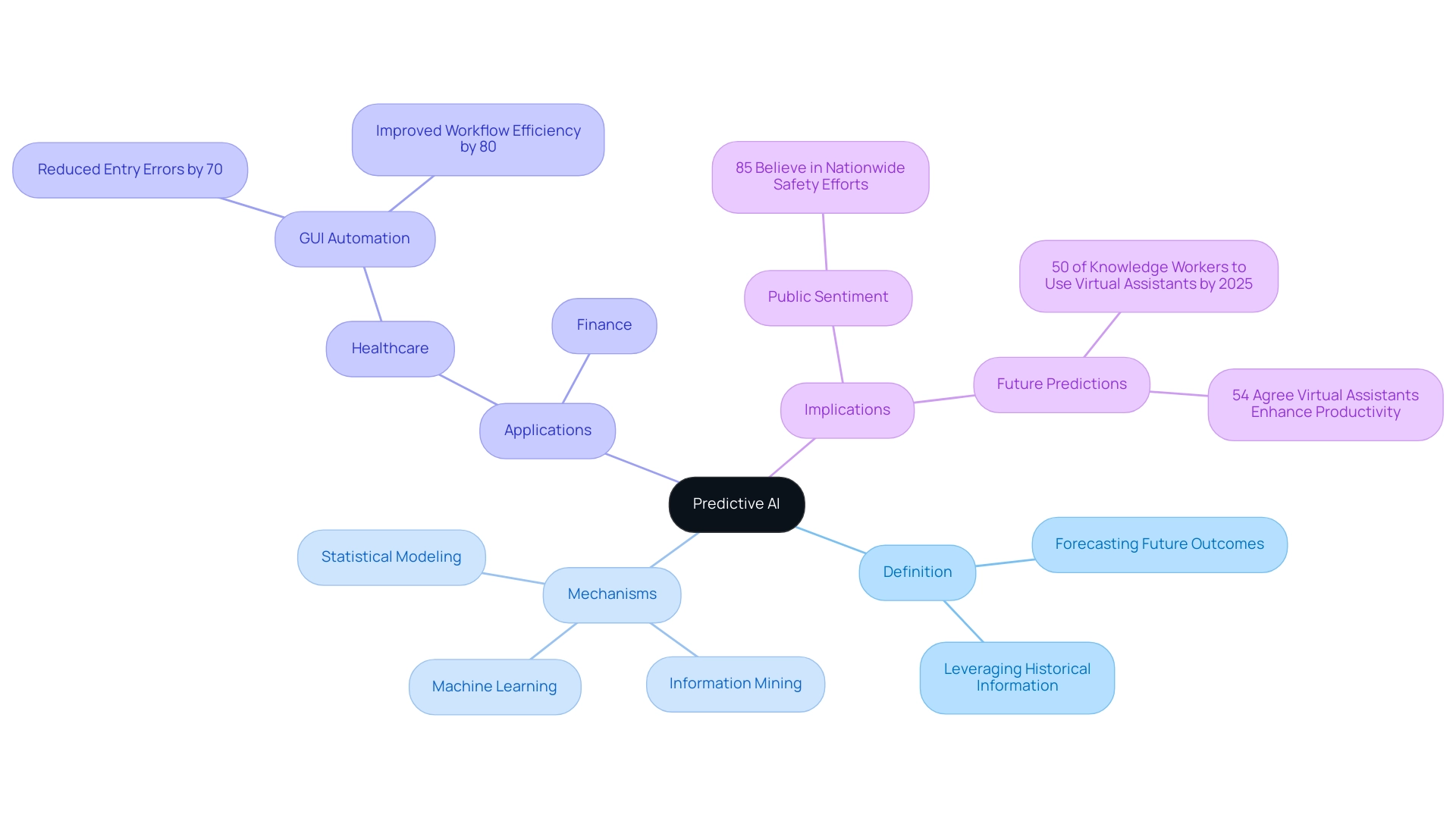
Real-World Applications of Predictive AI: Transforming Industries
The predictive AI definition illustrates how it is fundamentally transforming industries by providing organizations with the tools to effectively anticipate future trends and behaviors. In the healthcare sector, predictive analytics is essential for forecasting patient admissions, enabling hospitals to optimize resource allocation and enhance overall patient care. As one industry leader noted, these advancements are pivotal for ‘improving overall patient care.’
This is especially crucial as 80 percent of US healthcare providers significantly boost their IT and software investments, with AI advancements leading the charge. Additionally, 56% of healthcare leaders plan to invest in generative AI solutions within the next three years, indicating a strong future direction for AI in healthcare. Combined with Robotic Process Automation (RPA), which streamlines manual workflows and reduces mistakes, these technologies are essential in overcoming implementation challenges such as manual information entry errors and slow software testing.
RPA not only enhances operational efficiency, achieving a 70% reduction in entry mistakes and an 80% improvement in workflow effectiveness, but also allows teams to focus on more strategic, value-adding initiatives. Furthermore, the significance of Business Intelligence cannot be overstated; it converts raw information into actionable insights, driving informed decision-making for business growth. As companies harness predictive models across various sectors, from retail to finance, they enhance operational efficiency, which aligns with the predictive AI definition and paves the way for smarter, more responsive business practices.
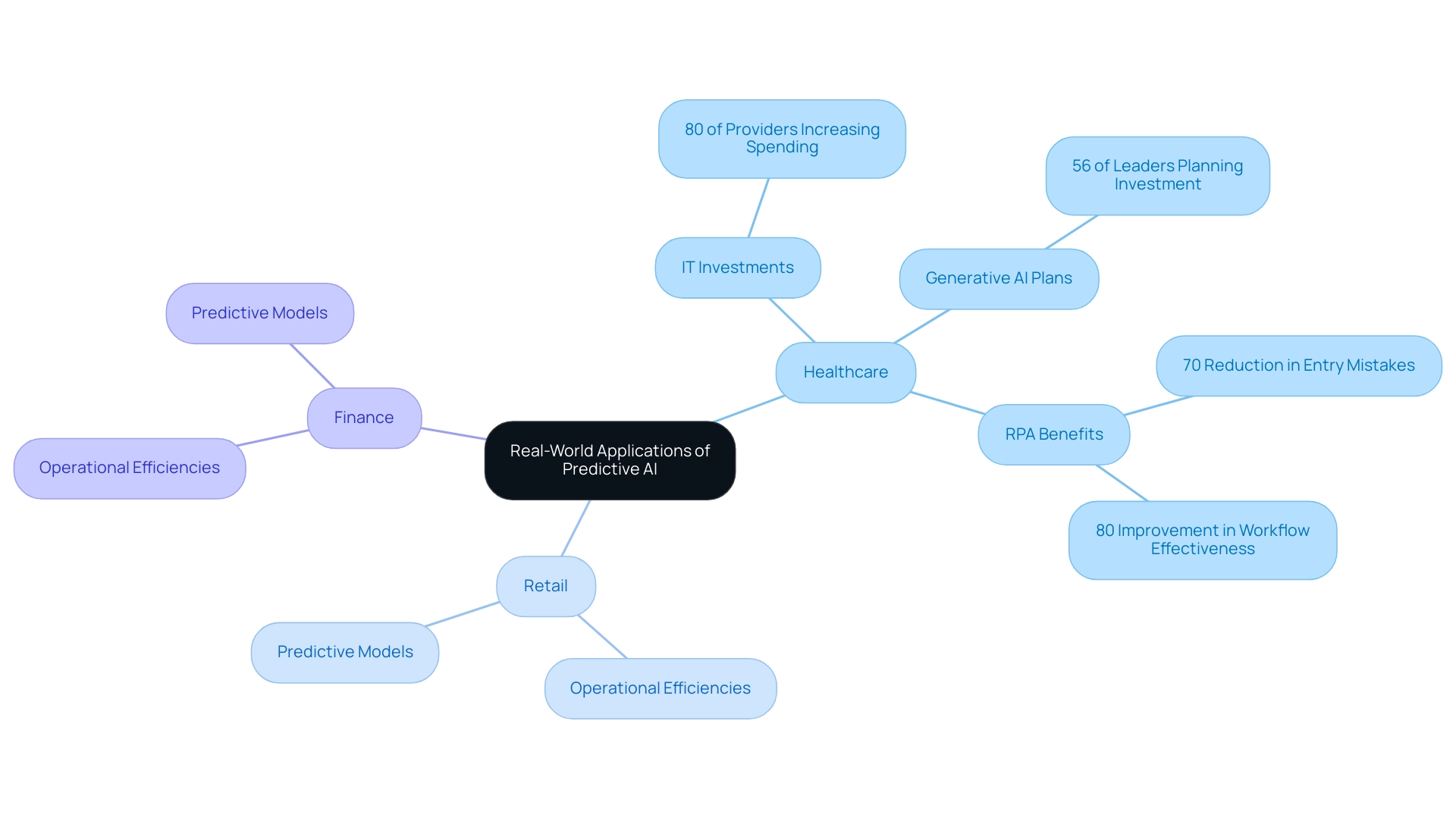
Predictive AI vs. Generative AI: Key Differences and Synergies
Predictive AI and generative AI represent two distinct yet complementary facets of artificial intelligence. The predictive AI definition highlights how this technology primarily focuses on predicting future events through the analysis of historical data, allowing entities to make informed decisions based on expected outcomes. In contrast, generative AI focuses on creating new content—be it images, text, or music—by learning intricate patterns from existing datasets.
As Nicholas Renotte, Chief AI Engineer at IBM Client Engineering, aptly points out,
For example, lots of businesses want to generate a financial forecast, but that’s not typically going to require a gen AI solution, especially when there are models that can do that for a fraction of the cost.
This distinction is crucial for organizations aiming to leverage AI effectively. The importance of these innovations is highlighted by the projected influence of generative AI, which encompasses a 3x rise in MBE value and the establishment of roughly 13,000 new jobs, enhancing the net worth of the Black community by about $2 billion.
Furthermore, the case analysis named ‘Direct Investment into SCI’ demonstrates a practical use, highlighting how investments in community projects can create direct influence, possibly improved by forecasting and generative AI methods. Nonetheless, the two innovations can collaborate efficiently; for example, generative AI can create artificial information that boosts the training of predictive models, thus enhancing their precision and reliability. This interplay is increasingly relevant, particularly as organizations modernize with solutions like EMMA RPA for automation and tailored Small Language Models for enhanced data analysis and privacy.
The GenAI workshops provide hands-on training that equips teams with the skills to implement these technologies effectively, while tailored AI solutions address specific business challenges, driving productivity and innovation. Such integrations not only streamline operations but also empower businesses to make informed, strategic decisions in a rapidly evolving AI landscape.
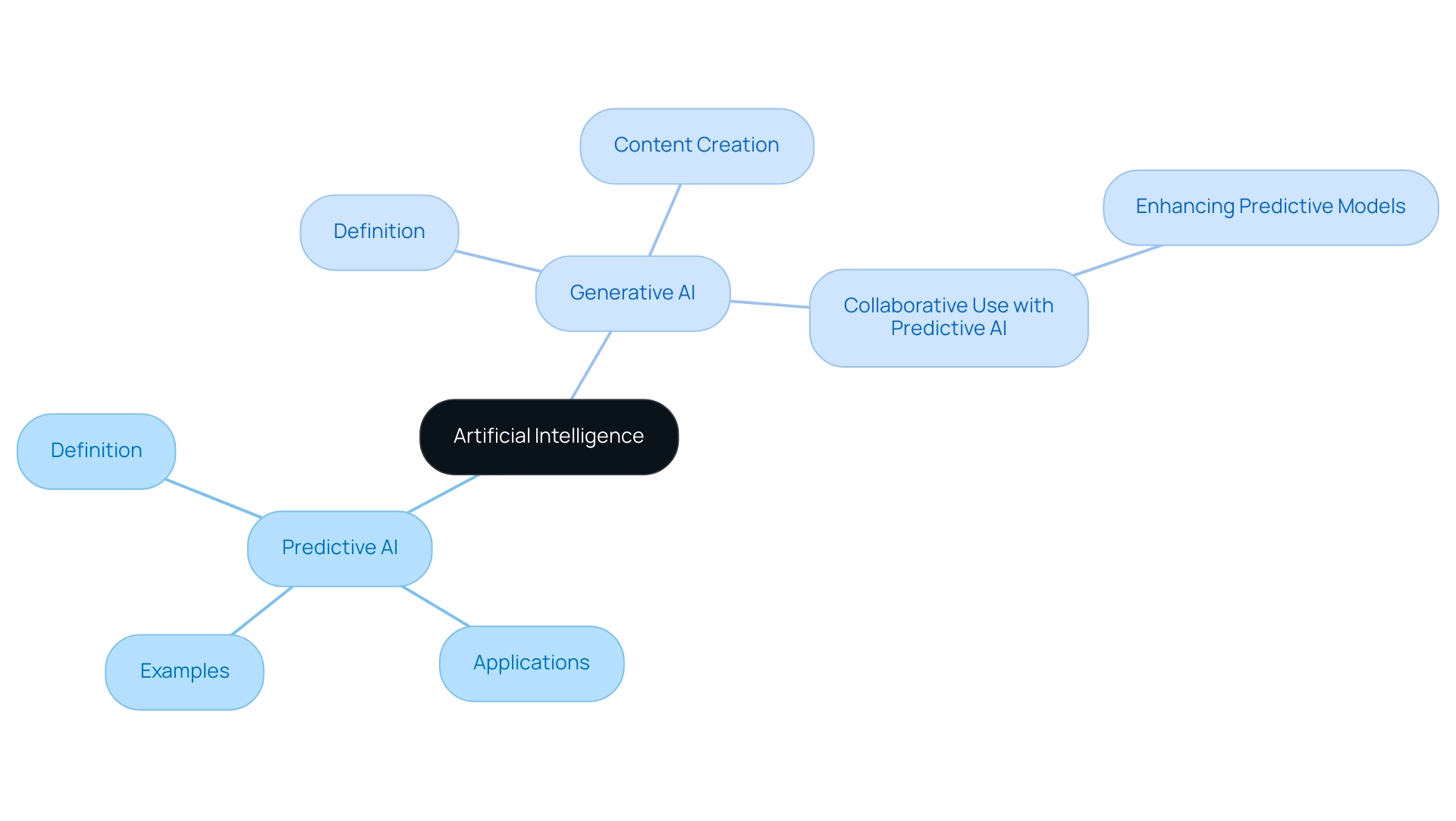
Benefits and Challenges of Implementing Predictive AI
Implementing forecasting AI presents a wealth of benefits that can transform organizational operations, such as significantly improved operational efficiency, enhanced decision-making capabilities, and the proactive anticipation of customer needs. By utilizing analytical forecasting alongside Robotic Process Automation (RPA), companies can optimize resource allocation, thereby reducing costs and minimizing waste—an essential advantage in today’s competitive landscape. RPA can also address staffing shortages by automating repetitive tasks, allowing employees to focus on higher-value work, and modernize outdated systems to improve overall productivity.
Notably, AI-powered self-driving vehicles are projected to generate over $170 billion in annual revenue worldwide, highlighting the lucrative potential of AI integration. However, entities often encounter challenges that can impede successful implementation. Key hurdles include:
- Ensuring data quality
- Integrating existing systems with the predictive AI definition
- Overcoming resistance to change among staff
The recent Executive Order issued by the White House in October 2023 underscores the importance of establishing new AI safety and security standards, further complicating the regulatory landscape entities must navigate. Additionally, while the rapid growth of voice assistant technology—evidenced by over 4 billion devices in use worldwide, projected to reach 8.4 billion by 2024—illustrates successful AI integration, it also highlights the challenges of job displacement and privacy concerns associated with AI adoption. As of 2023, machine learning technologies have only a 2.6% representation in job advertisements, signaling a need for greater awareness and training in this area.
By proactively addressing these challenges and overcoming the drawbacks of AI through customized RPA solutions and utilizing Business Intelligence to convert data into actionable insights, companies can unlock the full potential of forecasting AI, driving efficiency and growth into 2024 and beyond. Furthermore, enhancing workplace productivity and morale through automation can alleviate the burden of repetitive tasks, address talent retention issues, and modernize outdated systems, creating a more dynamic and innovative operational environment.
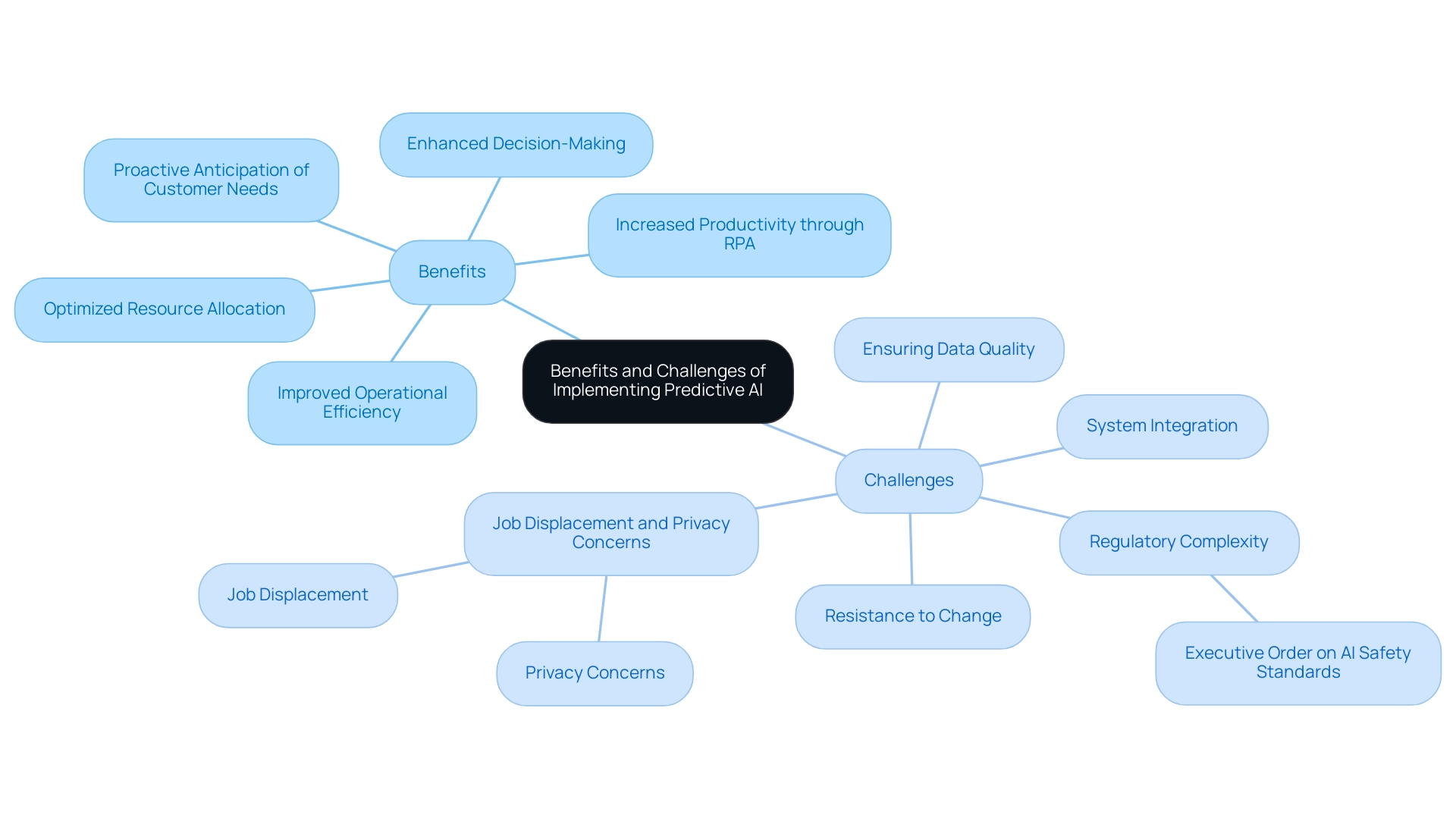
The Future of Predictive AI: Trends and Innovations
The predictive AI definition points to a future that is exceedingly promising, driven by rapid advancements in machine learning algorithms and the growing computational capabilities that facilitate more sophisticated analyses. Significantly, 31% of entities have reported accelerated decision-making processes due to Big Data and AI solutions, underscoring the tangible benefits of these technologies. However, many organizations face challenges in AI adoption, often perceiving these projects as complex, costly, and difficult to integrate into existing workflows.
This perception is compounded by concerns over poor master data quality, which can hinder effective AI implementation. This is where tools like Robotic Process Automation (RPA) come into play, streamlining manual processes to enhance operational efficiency. The merging of AI with the Internet of Things (IoT) is especially significant, as it improves the precision and real-time relevance of forecasting models across various sectors.
As AKM Aminul Islam noted, ‘Generative artificial intelligence (AI) models, or Gen-AI for short, started as a way to create chatbots,’ highlighting the evolution of AI technologies that feed into predictive analytics. Innovations like explainable AI are set to revolutionize the landscape by introducing greater transparency in decision-making processes. This not only builds trust in the predictions generated by these systems but also enables entities to make informed choices.
Furthermore, utilizing Business Intelligence tools is essential for converting raw information into actionable insights, fostering growth and innovation. However, organizations must address challenges related to data quality, accessibility, and security, as emphasized in the case study titled ‘Data Management as an AI Bottleneck.’ As businesses increasingly embrace digital transformation, the predictive AI definition, which is supported by RPA and robust Business Intelligence strategies, will undoubtedly become a cornerstone for driving innovation and achieving a competitive edge, enabling leaders to navigate complex operational challenges with confidence.
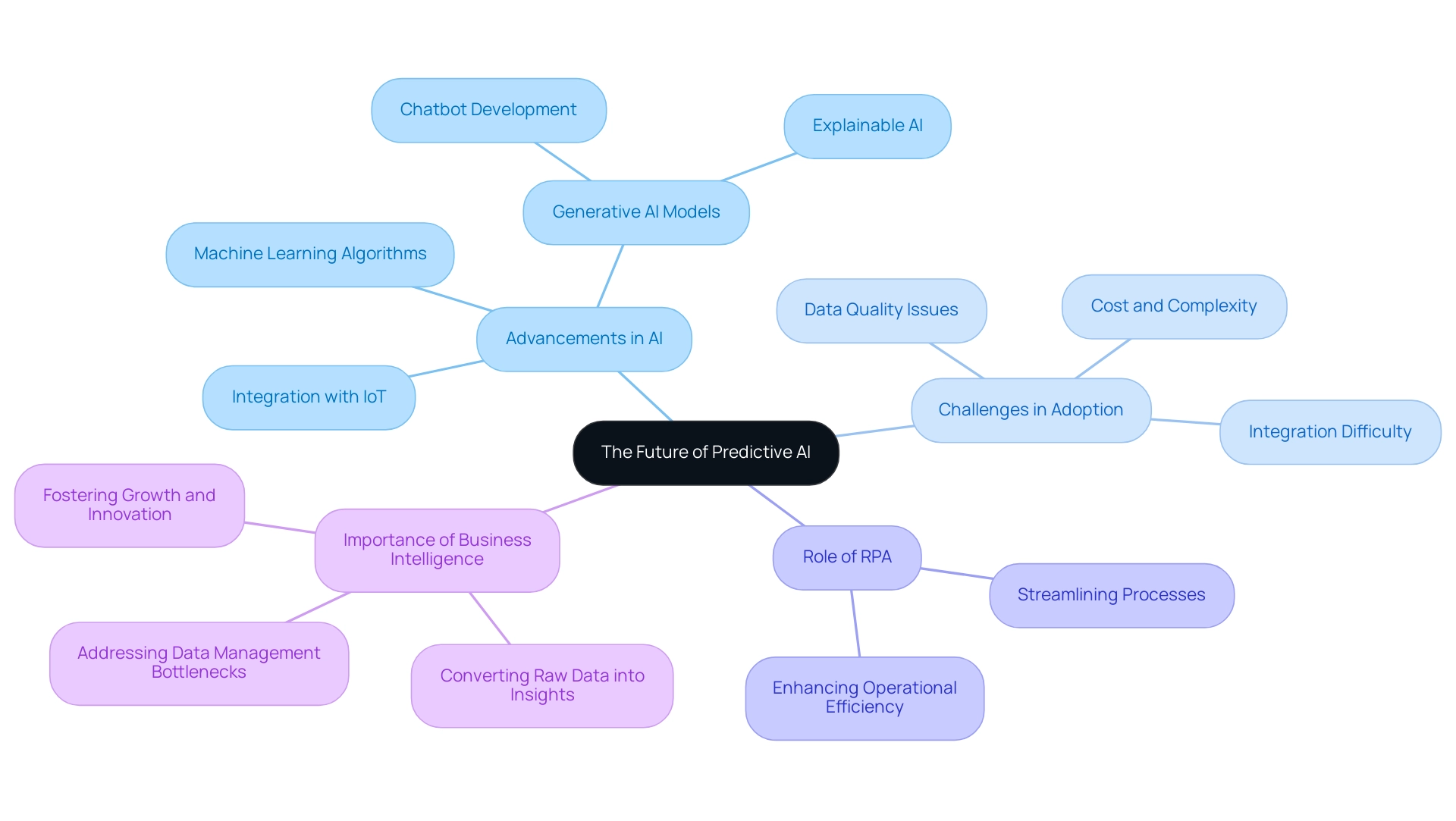
Conclusion
Predictive AI stands at the forefront of technological advancement, offering organizations the ability to forecast future trends and optimize operations across various sectors. By harnessing historical data and sophisticated algorithms, businesses can enhance decision-making, improve customer experiences, and drive significant efficiencies. The integration of predictive analytics with tools like Robotic Process Automation (RPA) not only simplifies workflows but also addresses common challenges such as data entry errors and slow processes, allowing teams to focus on strategic initiatives.
Despite the promising benefits, organizations must navigate hurdles like data quality issues and resistance to change. These challenges, coupled with the evolving regulatory landscape surrounding AI, necessitate a proactive approach to implementation. By investing in tailored solutions and fostering a culture of innovation, companies can unlock the full potential of predictive AI, transforming operational efficiency and ensuring sustained growth.
As industries continue to evolve, embracing predictive AI is not merely an option but a necessity for organizations aiming to thrive in an increasingly competitive environment. The future is bright for those willing to leverage these technologies, as they pave the way for smarter, more responsive business practices that will define success in the years to come. By committing to this journey, organizations can not only enhance their operations but also position themselves as leaders in their respective fields, ready to meet the challenges and opportunities that lie ahead.
Introduction
In the rapidly evolving landscape of business operations, Robotic Process Automation (RPA) stands out as a transformative force, redefining how organizations approach efficiency and productivity. By deploying software robots to handle mundane, repetitive tasks, companies can significantly reduce human error and operational costs while empowering their workforce to focus on strategic initiatives that foster innovation.
The integration of RPA is not merely a trend; it is a necessity for organizations striving to maintain a competitive edge in an increasingly complex marketplace. From enhancing compliance and accuracy to providing scalable solutions, the benefits of RPA are compelling.
However, the journey to successful implementation is not without its challenges. Understanding these obstacles and exploring the promising future of RPA, especially when combined with artificial intelligence, is crucial for any organization looking to harness its full potential.
This article delves into the definition, benefits, challenges, and future trends of RPA, offering a comprehensive guide for organizations ready to embrace this game-changing technology.
Introduction to Robotic Process Automation (RPA): Definition and Importance
Robotic Process Automation (RPA) involves the deployment of software robots to automate repetitive, rule-based tasks that are typically handled by human workers. This technology has become a cornerstone of enterprise automation, significantly improving performance, minimizing errors, and empowering employees to concentrate on higher-value tasks requiring critical thinking and creativity. A notable case study illustrates this: a mid-sized healthcare company faced challenges such as manual data entry errors, slow software testing, and difficulties integrating legacy systems without APIs.
To address these issues, the company implemented GUI automation to streamline data entry, software testing, and legacy system integration, achieving a remarkable 70% reduction in data entry errors and a 50% acceleration in testing processes. The ROI from this implementation was realized within six months. By integrating RPA, organizations can enhance their standing in the RPA Gartner Quadrant while streamlining processes across various departments, including finance, human resources, and customer service, leading to significant improvements in productivity and service delivery.
In the telecom sector, for instance, operators leverage RPA for customer service management and database administration, allowing support representatives to concentrate on more complex tasks. Recent findings indicate that workers save approximately 3.6 hours per week thanks to automation, underscoring its potential to transform workplace dynamics. With 65% of participants in a 2022 survey by Robocorp recognizing the benefits of flexible, usage-based pricing models for RPA solutions, the acknowledgment of RPA’s abilities in enhancing excellence is undeniable.
As key participants in the RPA market, including UiPath, Automation Anywhere, and Blue Prism, guide the trend, the momentum for RPA adoption keeps increasing, further reinforcing its position in the RPA Gartner Quadrant as a vital instrument for improving operational effectiveness.
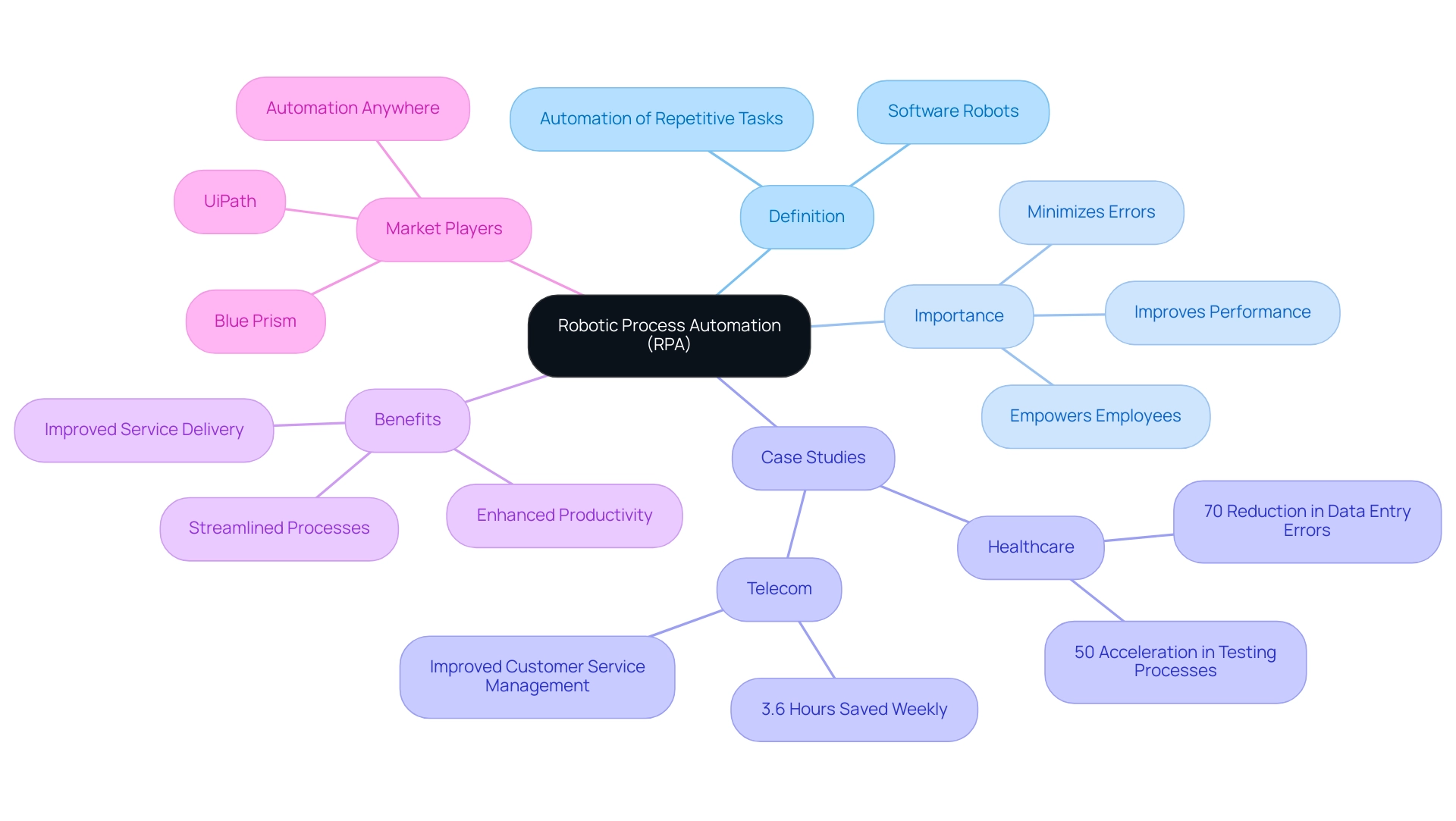
Understanding the Gartner Magic Quadrant for RPA: Evaluation Criteria and Insights
The RPA Gartner Quadrant is an essential resource for organizations aiming to evaluate vendors based on execution capabilities and vision completeness, especially in a rapidly evolving AI landscape. Key evaluation criteria include:
- Product functionalities
- Market responsiveness
- Overall customer experience
These criteria are critical for overcoming technology implementation challenges. This comprehensive framework illuminates the competitive landscape, enabling organizations to identify RPA solutions that align with their specific goals, enhance operational efficiency, and deliver significant cost savings.
Trusted by top organizations, Appian is recognized for driving transformational process change, while Microsoft has emerged as a formidable competitor in the RPA market. Leveraging insights from the RPA Gartner Quadrant empowers organizations to make informed decisions and effectively navigate vendor positioning to maximize their automation investments. As Tim Yalich, Head of Auto Strategy for Wolters Kluwer, aptly noted, ‘More impressively, despite a ransomware attack that threatened many enterprises into a paper-based environment, many saw opportunities to pivot and remain digital, validating the importance of digitizing their entire workflow operations to meet customer needs.’
This viewpoint emphasizes the importance of implementing strong RPA solutions to improve productivity and resilience. Furthermore, tailored AI solutions can assist organizations in seamlessly integrating RPA into their operations, ensuring they remain competitive in this evolving landscape. It’s important to remember that Gartner disclaims all warranties regarding its research publications and does not endorse any vendor, product, or service depicted in its research.
Recently, Appian’s legal victory over Pegasystems in a $2.036 billion lawsuit illustrates the competitive dynamics at play and may influence its standing in the market. For organizations aiming to improve their performance through RPA, investigating these solutions further could be crucial.
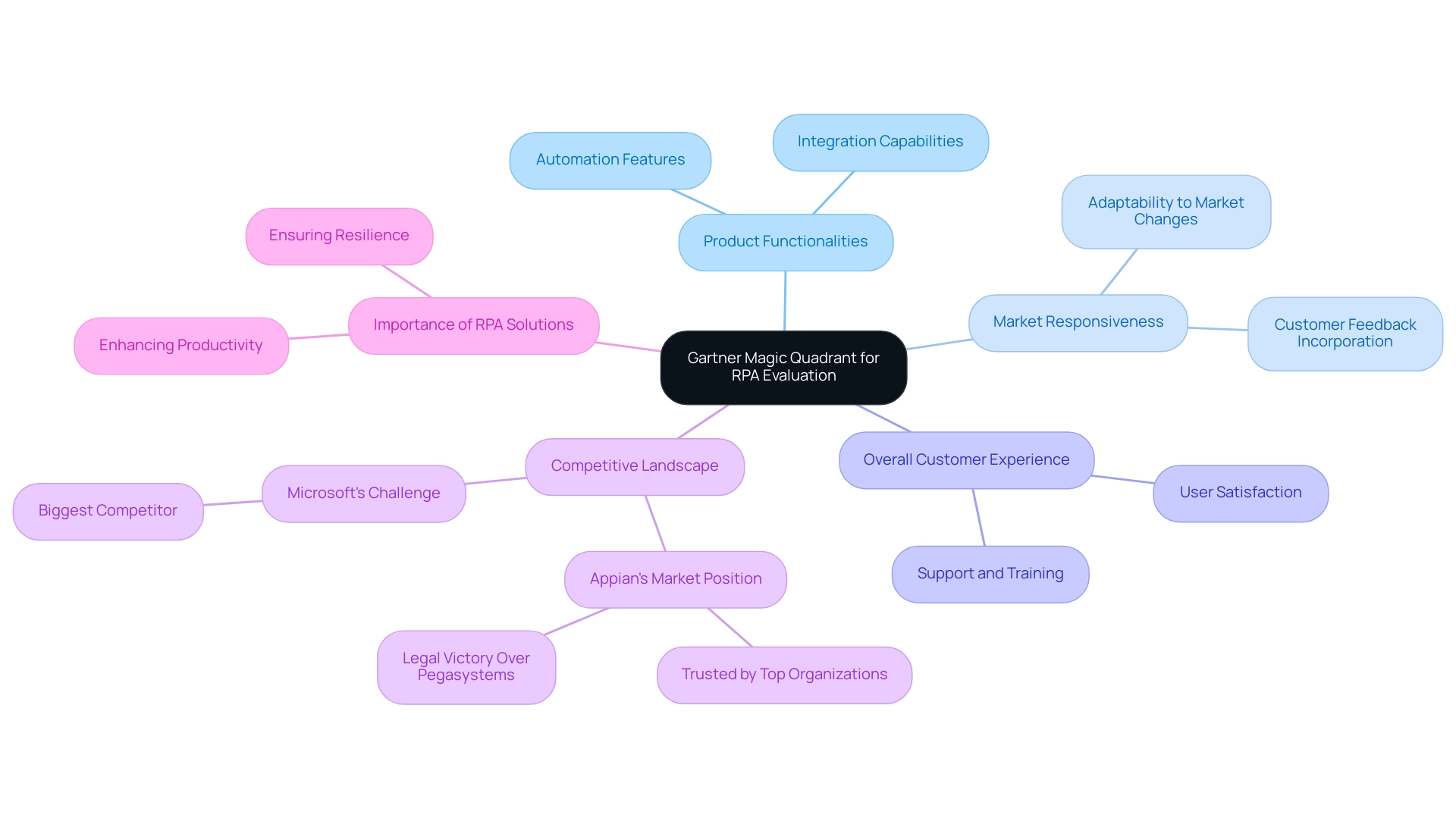
Key Benefits of Implementing RPA in Business Operations
Implementing Robotic Process Automation (RPA) in organizational operations unlocks a multitude of advantages that can transform efficiency and drive success. Key benefits include:
-
Increased Productivity: By automating routine and repetitive tasks, employees are freed to concentrate on strategic initiatives that add greater value to the organization.
This shift not only boosts morale but also enhances overall performance. In fact, robots are expected to take over 20% of current routine tasks, with some believing they could handle up to 52% of work capacity, showcasing the transformative potential of RPA. Solutions like EMMA RPA and Microsoft Power Automate exemplify user-friendly digitalization, allowing organizations to streamline workflows and enhance productivity effectively. -
Cost Efficiency: RPA significantly reduces operational costs by minimizing the reliance on manual labor and the potential for human errors. As evidenced by recent findings, over 65% of respondents in a Robocorp 2022 survey acknowledged the potential benefits of usage-based pricing models for RPA, underlining the financial advantages that can be realized.
-
Enhanced Compliance: Automated processes provide a consistent approach to adhering to regulatory requirements, minimizing compliance risks and ensuring that operations remain within legal and industry standards.
-
Improved Accuracy: RPA systems are designed to eliminate human errors, resulting in higher quality outputs and reduced rework, which is crucial for maintaining competitive advantage.
-
Scalability: RPA solutions can be easily scaled to accommodate fluctuating organizational needs, allowing entities to adapt swiftly to market changes without incurring significant additional costs.
As Cem Dilmegani noted, the RPA market has experienced a remarkable growth rate of 22.1% in 2023, surpassing other sectors, which indicates that businesses are increasingly recognizing the value of these technologies as reflected in the RPA Gartner quadrant. Additionally, the strong funding environment for RPA firms—such as UiPath’s $1.2 billion, Automation Anywhere’s $840 million, Blue Prism Group’s $182 million, and Workfusion’s $180 million—emphasizes the industry’s dedication to improving productivity and reducing costs. The case study titled ‘RPA Adoption Across Industries‘ illustrates how RPA is being increasingly embraced in sectors like healthcare, finance, and manufacturing to automate complex, industry-specific processes, contributing to improved efficiency.
By embracing RPA, organizations can address challenges such as task repetition fatigue and staffing shortages, improving their operational capabilities and positioning themselves for sustained success in a competitive marketplace. Additionally, the integration of robotics in the workplace is visually represented by a stylized illustration featuring a human figure collaborating with robotic figures, emphasizing the synergy between human intelligence and automation. To explore how RPA can transform your business, book a free consultation today.
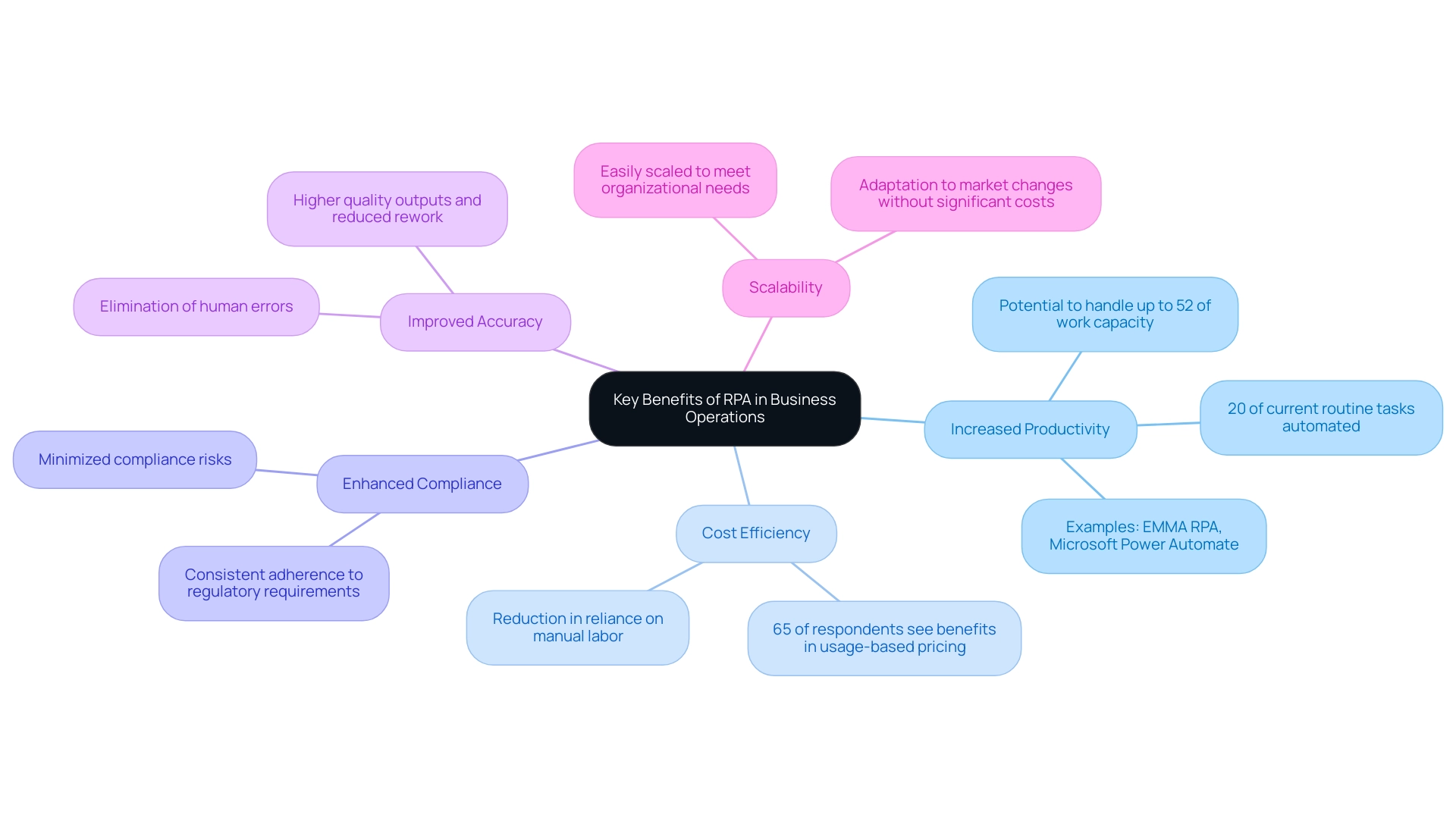
Challenges in RPA Deployment: Navigating Common Obstacles
Although the benefits of Robotic Process Automation (RPA) are significant, organizations often face various challenges during its implementation that can impede productivity. Key challenges include:
- Resistance to Change: Employees often hesitate to embrace new technologies due to concerns about job security and shifts in work processes.
For instance, a study examining RPA’s influence on employee acceptance within a major oil and gas company’s finance and accounting unit revealed that RPA significantly affects how employees adapt to technological changes, underscoring the importance of addressing acceptance to ensure organizational success. This is particularly relevant as statistical analysis has shown that companies automating economy and accounting functions experienced less downsizing compared to those automating other functions, emphasizing the positive impacts RPA can have on workforce stability.
-
Integration Issues: Achieving seamless interoperability between RPA tools and existing systems can be a complex endeavor, potentially leading to operational disruptions if not managed properly.
-
Lack of Expertise: A prevalent barrier to successful RPA implementation is the insufficient knowledge surrounding its capabilities and applications, which can stall progress.
-
Process Selection: Identifying the right processes for automation is crucial; not every task is suitable for RPA. To effectively navigate these challenges, organizations should prioritize investing in change management strategies, provide comprehensive training to employees, and conduct thorough assessments of processes to determine automation suitability.
By proactively addressing these issues, companies can facilitate smoother RPA adoption and leverage its full potential. Furthermore, with our risk-free ROI-driven GUI automation services, organizations can automate repetitive tasks, address staffing shortages, and modernize outdated systems confidently, ensuring they see measurable results, such as the mid-sized company’s success in reducing data entry errors by 70% and enhancing workflow performance by 80%. As part of our promise, you only pay if the automation process is delivered as planned, ensuring a risk-free investment.
Our step-by-step methodology includes:
- Accessing a process of yours that you would like to automate,
- Calculating the efforts required to automate the process,
- Estimating the time savings you will see after the project and calculating the ROI, and
- Automating the process, done by a certified professional on our side.
As McKinsey predicts, sectors like medicine and pharma could save as much as $100 billion by depending on AI and big data, illustrating the broader implications of RPA across industries.
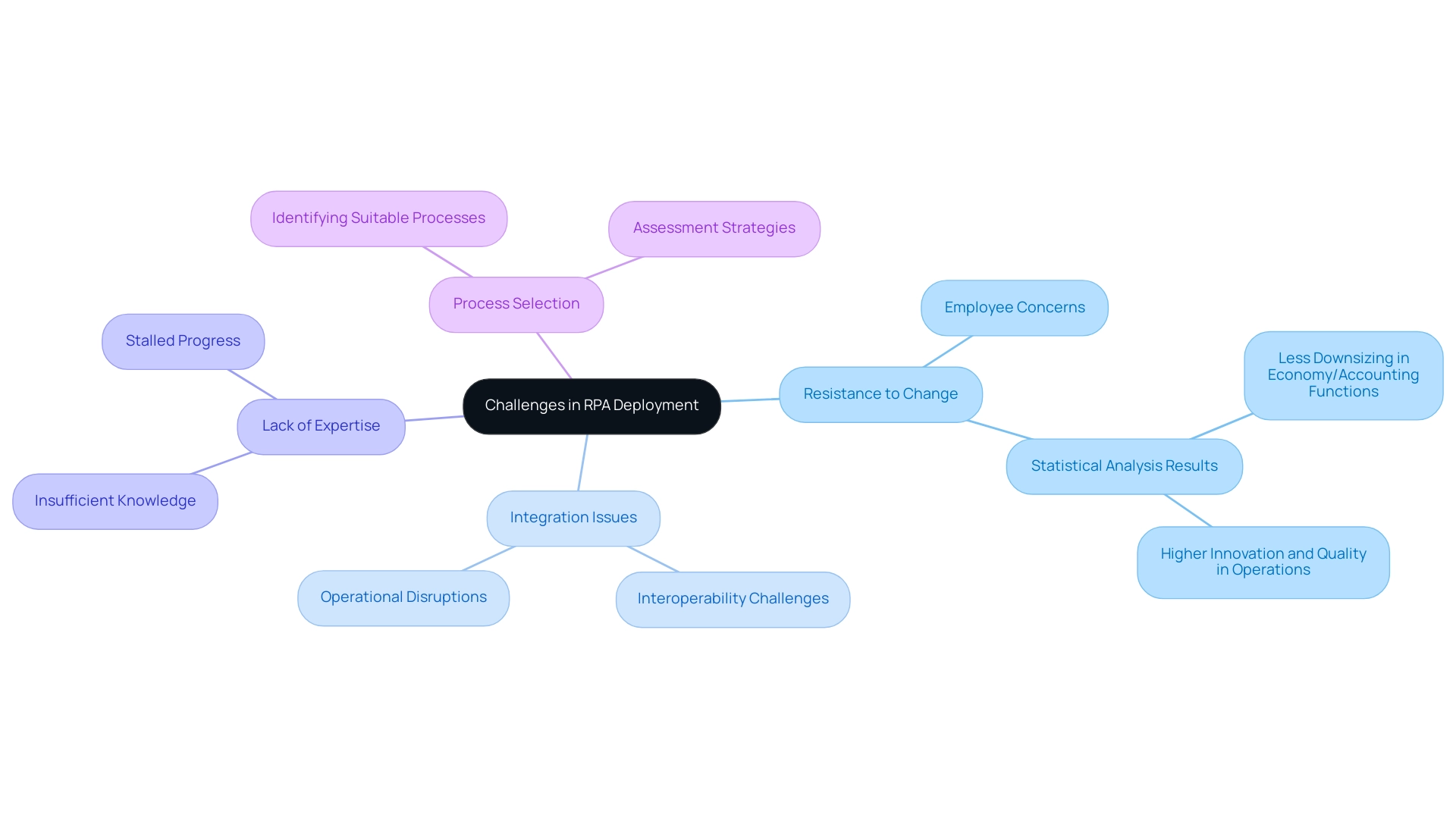
The Future of RPA: Integration with AI and Emerging Trends
The future of Robotic Process Automation (RPA) is intricately linked to advancements in artificial intelligence (AI), particularly as organizations often grapple with challenges such as poor master data quality and hesitation in adopting AI due to perceived complexity and cost. By combining AI with RPA, companies can attain intelligent automation, where machines not only perform tasks but also learn and adjust over time, significantly improving productivity. RPA continues to alleviate manual and repetitive work, allowing employees to focus on higher-value tasks.
Key emerging trends in this arena include:
-
Cognitive Automation: This fusion of AI and RPA enables the management of more complex tasks requiring nuanced decision-making, addressing the AI implementation paralysis often caused by data inconsistencies. RPA can directly mitigate these issues by ensuring that data is consistently processed and validated before being utilized in AI applications.
-
Predictive Analytics: Utilizing data to anticipate needs and improve workflows, this trend promotes proactive, data-driven strategies that enhance performance. RPA plays a crucial role in gathering and cleaning data, thus providing a solid foundation for predictive analytics.
-
Enhanced User Interfaces: Innovations in user experience design improve interactions between users and automated systems, making them more intuitive and effective, which is crucial for overcoming adoption hesitations. For instance, Social’s AI chatbot can respond to inquiries in just 2.7 seconds, showcasing the efficiency of AI in real-world applications.
Furthermore, trends in Intelligent Process Automation (IPA) demonstrate how integrating AI with RPA leads to personalized customer experiences and deeper insights into customer behavior. Organizations that proactively adopt these trends are poised to drive innovation and attain operational excellence, positioning themselves as leaders in an increasingly competitive landscape. Moreover, the synergy between RPA and Business Intelligence can facilitate enhanced data-driven insights, enabling informed decision-making that drives growth and innovation.
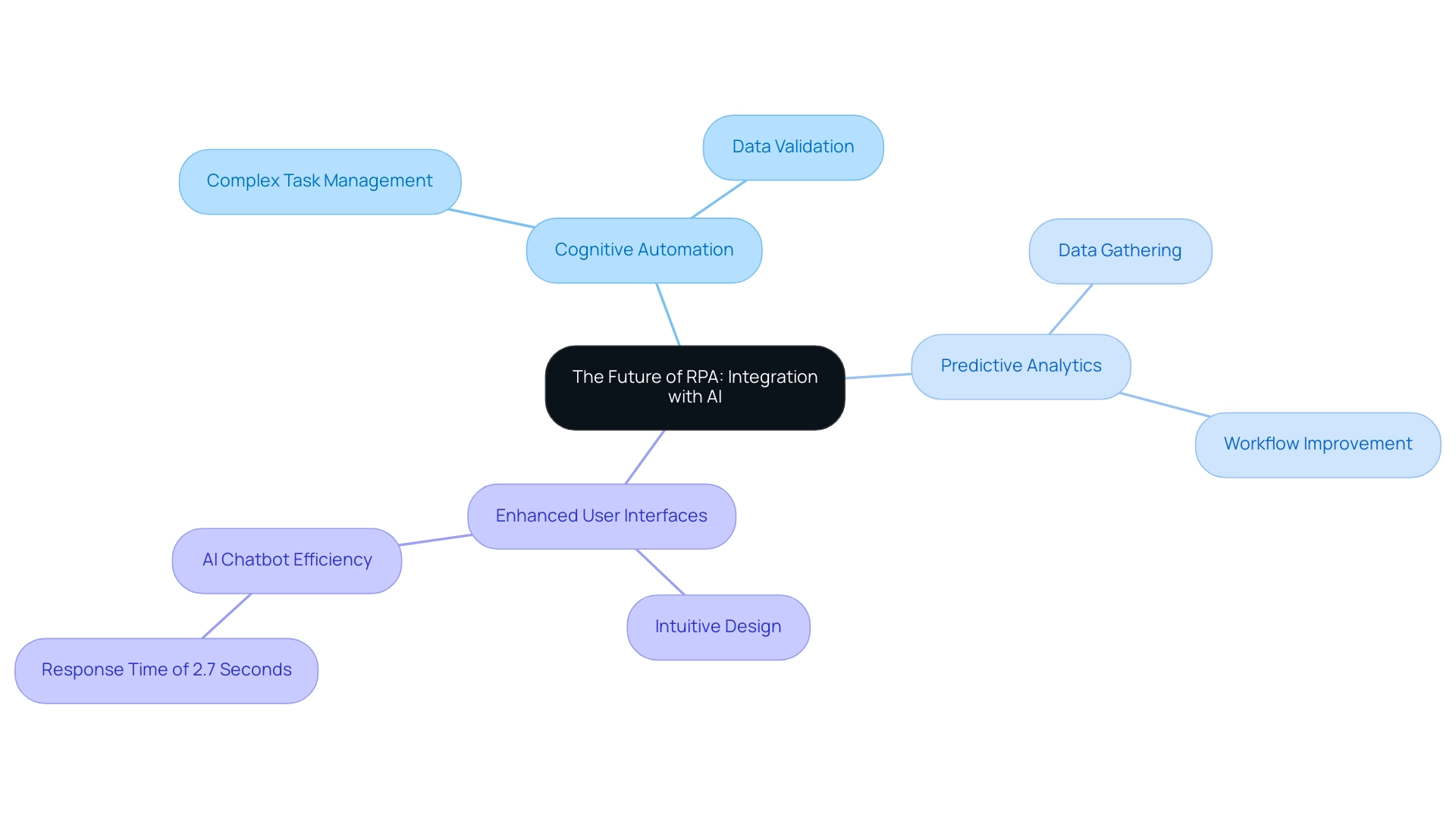
Conclusion
The integration of Robotic Process Automation (RPA) into business operations is not just a strategic advantage; it is a critical step towards achieving operational excellence and maintaining competitiveness in a rapidly changing marketplace. By automating repetitive tasks, organizations can improve productivity, reduce costs, and enhance accuracy, allowing employees to focus on high-value activities that drive innovation and growth. The compelling case studies and statistics presented highlight how businesses across various sectors have realized substantial returns on investment through RPA implementations.
However, the journey towards successful RPA adoption is fraught with challenges, including resistance to change and integration issues. It is essential for organizations to address these obstacles proactively by investing in change management and employee training. By doing so, companies can facilitate a smoother transition and unlock the full potential of RPA to transform their operations.
Looking ahead, the future of RPA is intertwined with advancements in artificial intelligence, paving the way for even greater efficiencies through intelligent automation. Embracing emerging trends such as cognitive automation and predictive analytics will empower organizations to not only streamline processes but also enhance decision-making capabilities.
In conclusion, organizations that prioritize RPA and its integration with AI are well-positioned to thrive in an increasingly competitive landscape. The time to act is now—embracing this transformative technology can lead to significant improvements in efficiency, cost savings, and ultimately, sustained success.
Introduction
In the dynamic landscape of modern business, the quest for operational efficiency has never been more critical. As organizations increasingly turn to Robotic Process Automation (RPA) to streamline their processes, the choice of tools becomes paramount. With options like EMMA RPA and Microsoft Power Automate leading the charge, understanding their unique functionalities and benefits can empower companies to make informed decisions that align with their strategic goals.
This article delves into the strategies for enhancing productivity, integrating RPA with existing systems, and measuring performance, while also addressing common challenges that may arise during implementation. By leveraging these insights, organizations can harness the full potential of RPA, driving efficiency and fostering a culture of innovation that ultimately elevates employee satisfaction and operational success.
Choosing the Right RPA Tools for Cloud Efficiency
In the pursuit of cloud efficiency, organizations must carefully evaluate cloud RPA tools, specifically EMMA RPA and Microsoft Power Automate, both recognized for their robust functionality and user-friendly interfaces. EMMA RPA transforms operational efficiency by addressing outdated systems and task repetition fatigue, while also tackling staffing shortages, thereby enhancing employee morale through intelligent processes. Its seamless digitalization features render it user-friendly for various applications, ultimately enhancing productivity in the workplace.
Power Automate is recognized as Microsoft’s leading solution for advanced business workflow management. It enables entities to craft dynamic automated workflows that seamlessly connect applications and services, streamlining operations and enhancing overall efficiency. Recent case studies demonstrate significant improvements, such as a mid-sized company in the healthcare sector reducing data entry errors by 70% and accelerating software testing processes by 50% through GUI technology, highlighting the measurable outcomes of these technologies in improving service delivery.
The decision on which RPA tool to adopt ultimately hinges on specific organizational goals and the complexity of tasks intended for mechanization, particularly when considering cloud RPA options. A thorough evaluation of these options—including trial periods, feature comparisons, and user feedback—will yield valuable insights that align with the entity’s efficiency objectives. Recent statistics indicate that RPA technologies are expected to grow at a CAGR of 27.02% from 2023 to 2030, emphasizing the market potential and relevance of RPA tools.
Additionally, 74% of automation tool users report increased task completion speeds, underscoring the importance of selecting the right RPA solution. By leveraging such data and insights, entities can make informed decisions that enhance operational efficiency and employee satisfaction.
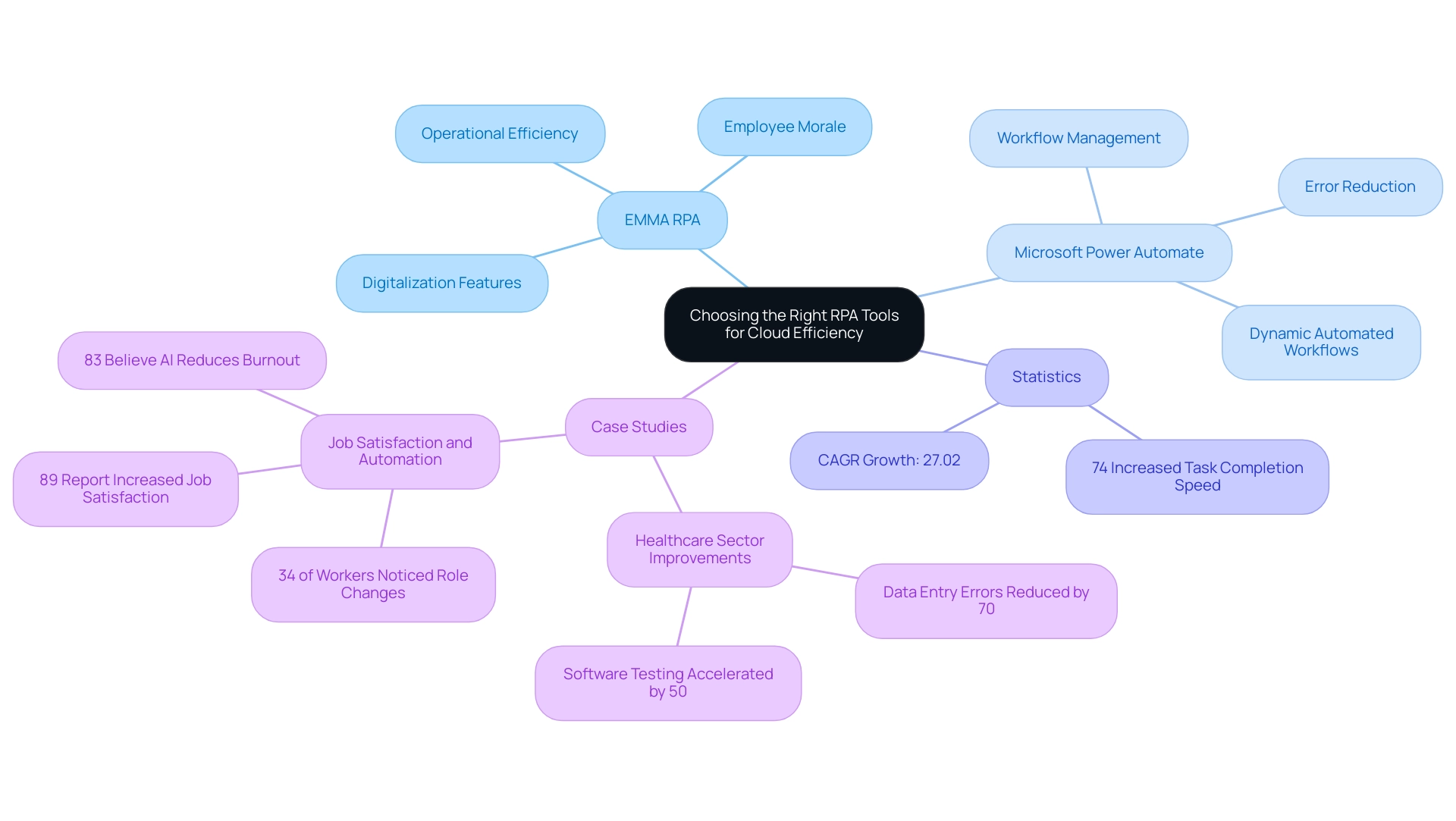
Strategies for Enhancing Productivity with Cloud RPA
To significantly enhance productivity through cloud RPA, organizations should adopt the following strategies:
- Identify High-Impact Processes:
Begin by conducting a thorough analysis of existing workflows to target repetitive and time-intensive tasks that stand to benefit from automation. Prioritize processes that necessitate high accuracy and are particularly vulnerable to human error, such as data entry and invoice processing.
Given that only 3% of entities have successfully scaled their digital workforce, identifying these high-impact areas is crucial for effective RPA implementation.
-
Establish Clear Objectives:
It is essential to define specific, measurable goals for RPA implementation that resonate with broader business objectives. For example, if the goal is to reduce operational costs, quantify the anticipated savings and outline a realistic timeframe for achieving these results. -
Train and Empower Employees:
Involve employees throughout the digitization journey by offering comprehensive training on the new RPA tools. Enabling team members to comprehend and adopt technological advancements nurtures a culture of innovation and improves acceptance throughout the company. As the Deloitte Global RPA Survey shows, over 90% of C-level executives employing intelligent processes believe their companies excel at managing change in response to evolving business trends, highlighting the importance of aligning RPA efforts with business objectives and addressing workplace challenges.
Additionally, addressing the exhaustion and annoyance caused by repetitive tasks can improve morale and productivity.
- Implement Continuous Monitoring and Improvement:
After deploying RPA, it is crucial to establish key metrics to assess its impact on productivity. Consistently assessing performance data can reveal areas for additional optimization, enabling organizations to adjust their strategies as needed.
A case study on productivity gains from mechanization reveals that 79% of workers identified increased productivity as a primary benefit, underscoring the value of continuous monitoring.
- Encourage Cross-Departmental Collaboration:
Promote open communication between departments to ensure that mechanization initiatives are aligned with comprehensive business processes. Collaborative efforts can uncover new automation opportunities and facilitate the sharing of best practices among teams.
This collaboration can also help address challenges related to attracting and retaining talent, as a more efficient workflow can make operational roles more appealing.
By embracing these strategies, companies can significantly enhance their cloud RPA initiatives, which drive the desired productivity gains that contribute to improved operational efficiency and a greater focus on strategic, high-value tasks. In today’s rapidly evolving AI landscape, overcoming technology implementation challenges is essential for maintaining a competitive edge and ensuring that your enterprise thrives.

Integrating RPA with Existing Business Systems
To successfully integrate cloud RPA with existing business systems, organizations should adhere to the following best practices:
-
Conduct a System Audit:
Begin with a comprehensive assessment of current business systems to pinpoint potential integration points. Understanding data flows and system capabilities clarifies how RPA will interact with existing technologies, setting the stage for effective implementation and enhancing operational efficiency. -
Ensure Compatibility:
Selecting RPA tools that align with existing software and platforms is crucial. This compatibility facilitates seamless data sharing and automation, thus minimizing operational disruptions and enhancing overall efficiency in the rapidly evolving AI landscape. -
Leverage APIs and Connectors:
Utilize Application Programming Interfaces (APIs) and pre-built connectors that enable efficient communication between RPA tools and current systems. This strategy not only accelerates the implementation but also reduces complexity, making integration more manageable and fostering improved productivity. -
Pilot Integrations:
Initiate pilot projects to trial integrations before committing to a full-scale rollout. This step enables entities to recognize and tackle potential issues early, ensuring a smoother and more successful integration experience while minimizing risks related to technology implementation challenges. -
Continuously Monitor Integration Performance:
Post-integration, it is essential to continuously monitor the performance of automated processes. Regular evaluations can highlight areas for improvement, enabling entities to fine-tune their integrations and enhance efficiency over time, thus unlocking the full potential of Business Intelligence and RPA.
By prioritizing these best practices, entities can effectively integrate their existing technology stacks with cloud RPA tools. Such strategic integration not only streamlines operations but also fosters enhanced productivity—a necessity in today’s competitive landscape. Notably, a staggering 78 percent of entities adopting RPA anticipate significant increases in their RPA investments within the next three years, underscoring the critical need for successful implementations.
Additionally, RPA is capable of handling up to 90% of data entry tasks in clinical research, illustrating its transformative potential in driving data-driven insights and operational efficiency. Successful collaborations with experts can enable robust RPA strategies while ensuring IT security, empowering entities to adapt to these technologies and thrive in their operational goals.
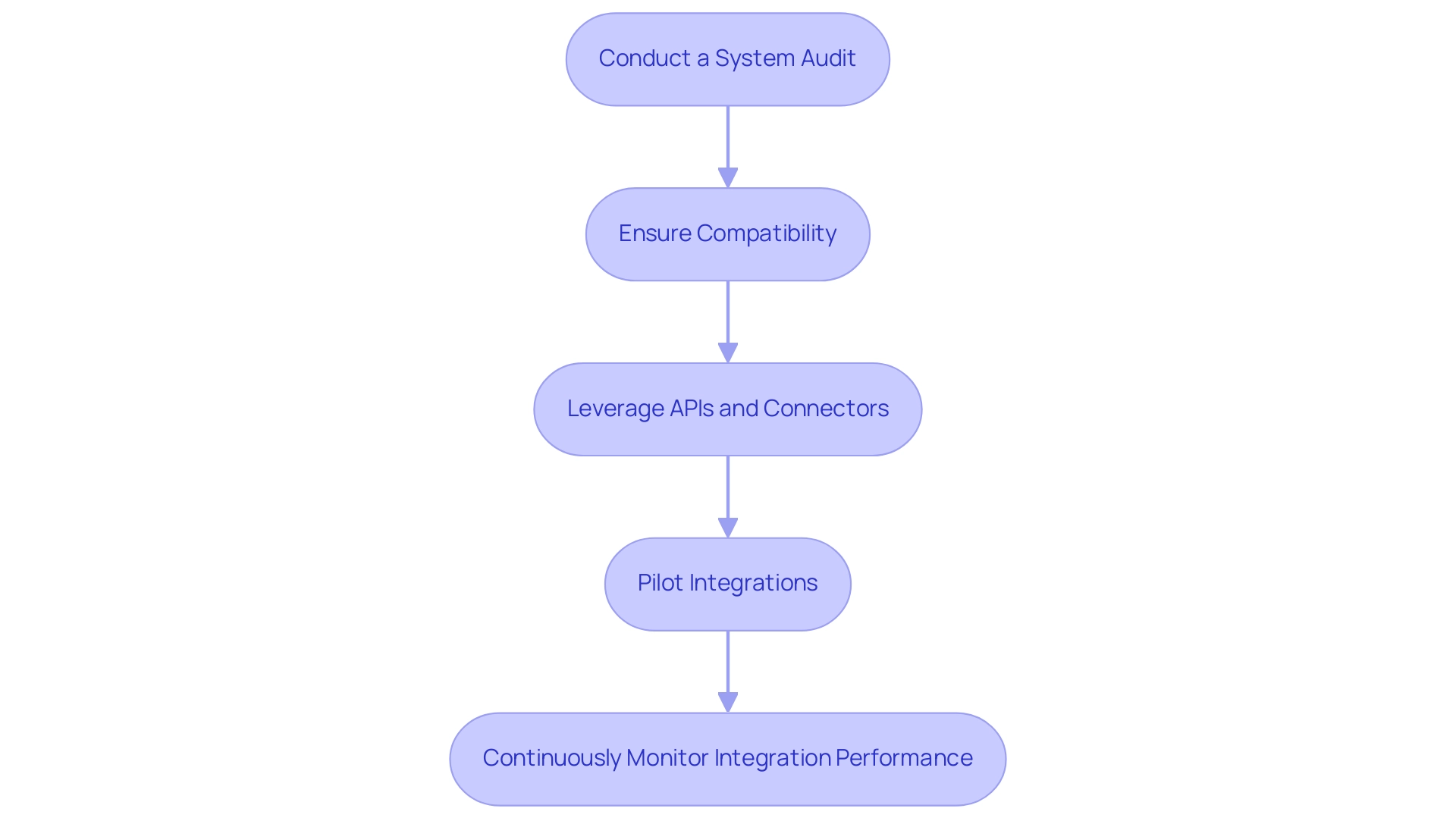
Measuring and Analyzing RPA Performance
To effectively measure and analyze the performance of Robotic Process Automation (RPA), organizations should concentrate on key performance indicators (KPIs) that provide actionable insights:
-
Time Savings: By calculating the time saved through mechanization, organizations can quantify the enhancement in operational efficiency. On average, workers save 3.6 hours per week thanks to mechanization, significantly boosting productivity and allowing teams to focus on higher-value tasks.
-
Error Reduction: Monitoring the reduction in errors in automated processes compared to manual execution is crucial. A substantial decrease in errors not only signifies successful mechanization but also enhances reliability in operations, fostering a culture of accuracy.
-
Cost Savings: Evaluating the financial implications of RPA implementation, including reduced labor costs and boosted productivity, is essential. Comprehending the return on investment (ROI) supports the continuation and expansion of automated initiatives, with numerous entities acknowledging the advantages of usage-based pricing. Notably, a recent Robocorp survey revealed that 65% of respondents acknowledged the potential advantages of such pricing models.
-
Throughput: Measuring the volume of transactions or activities completed over a designated timeframe provides insights into the scalability of RPA solutions. This metric is essential for evaluating how effectively automated systems can manage heightened workloads, guaranteeing that organizations can expand without being obstructed by manual tasks.
-
Employee Satisfaction: Gathering feedback from employees about their experiences with automated systems can reveal the impact of RPA on job satisfaction. Employees who are freed from routine tasks often demonstrate higher levels of engagement, which is a strong indicator of successful mechanization.
Additionally, integrating tailored AI solutions with RPA can further enhance operational efficiency by addressing specific business challenges and optimizing workflows. These AI technologies can analyze data patterns and provide insights that complement RPA initiatives, leading to more informed decision-making.
It’s important to note that successful business process optimization requires team involvement, with 45% of business teams playing critical roles. Consistently evaluating these KPIs allows organizations to make informed, data-driven choices to enhance their cloud RPA strategies, ensuring that processes continue to provide value and align seamlessly with their overarching business objectives.
The case study titled ‘User Satisfaction and Customer Experience‘ illustrates the effect of RPA on customer service and employee routines, showcasing enhanced speed and accuracy of responses due to the mechanization of repetitive tasks. As Yana Pokora, a Content Manager and RPA researcher, emphasizes, the successful implementation of automation necessitates ongoing evaluation to enhance both customer experience and employee efficiency, reinforcing the importance of these KPIs. Moreover, leveraging Business Intelligence to transform raw data into actionable insights can empower entities to make strategic decisions that drive growth and innovation.
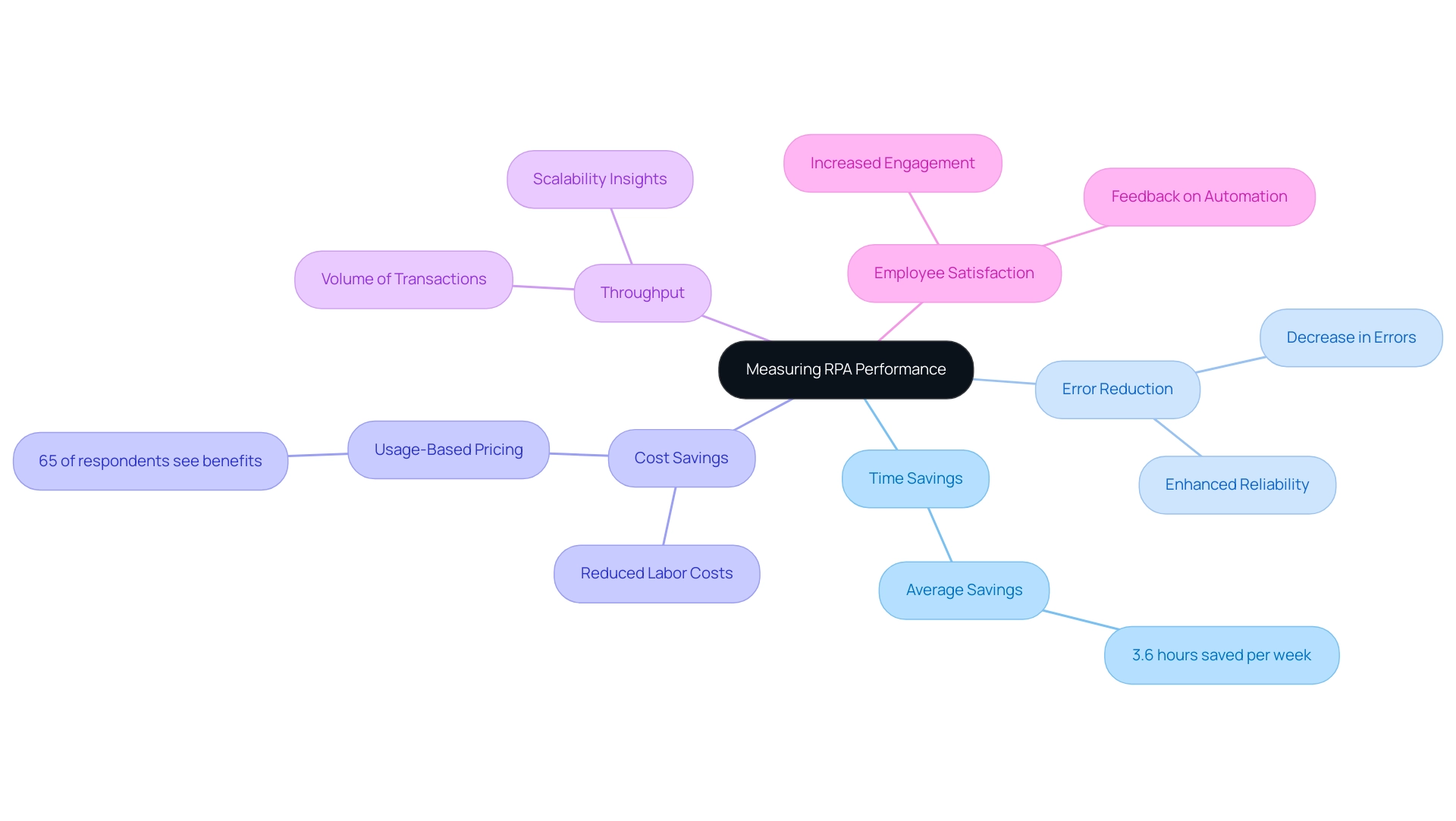
Overcoming Common Challenges in RPA Implementation
Successfully implementing cloud RPA requires a strategic approach to effectively navigate common challenges. Here are several key strategies to consider:
-
Communicate the Benefits: Clearly articulate the advantages of RPA to all stakeholders.
Highlighting time savings, reduced errors, lower costs, and enhanced job satisfaction can facilitate buy-in from employees and management alike. -
Involve Employees Early: Engage employees in the RPA implementation process from the outset.
By including them in discussions and decision-making, organizations can significantly reduce resistance and foster a culture of acceptance. -
Provide Comprehensive Training: Implement thorough training programs to ensure employees feel confident using new RPA tools.
Addressing potential concerns and emphasizing how mechanization will enhance their roles is crucial for smooth adoption. -
Start Small and Scale Gradually: Initiate RPA projects with smaller, manageable tasks that require minimal disruption.
As initial successes are achieved, gradually expand initiatives to encompass larger processes, reinforcing confidence in RPA’s effectiveness. -
Establish a Change Management Plan: Create a structured change management strategy that includes ongoing support and resources for employees.
By proactively addressing concerns and providing assistance during the transition, entities can ease the implementation process. -
Integrate with Other Technologies: Successful RPA implementations frequently connect with other technologies, such as AI and Business Intelligence, to develop more intelligent and adaptable systems, enhancing the overall effectiveness of initiatives.
These strategies are essential for cultivating a supportive environment for RPA adoption. By tackling these challenges directly, organizations can attain successful results, ultimately resulting in improved operational efficiency and greater employee satisfaction.
In fact, a recent study found that 91% of employees believe that technology saves time and enhances work-life balance, with 89% reporting increased job satisfaction as a result of these advancements.
Furthermore, with 80% of health systems planning to invest in digital healthcare solutions over the next five years, the urgency for RPA adoption is clear. Cloud RPA not only streamlines processes but also positively contributes to employee morale, making it a vital component of modern operational strategies.
As Yana Pokora, Content Manager at Flobotics, stated, ‘We hope this list of RPA stats has convinced you that automation is the next step you should take to improve the all-round efficiency of your business.
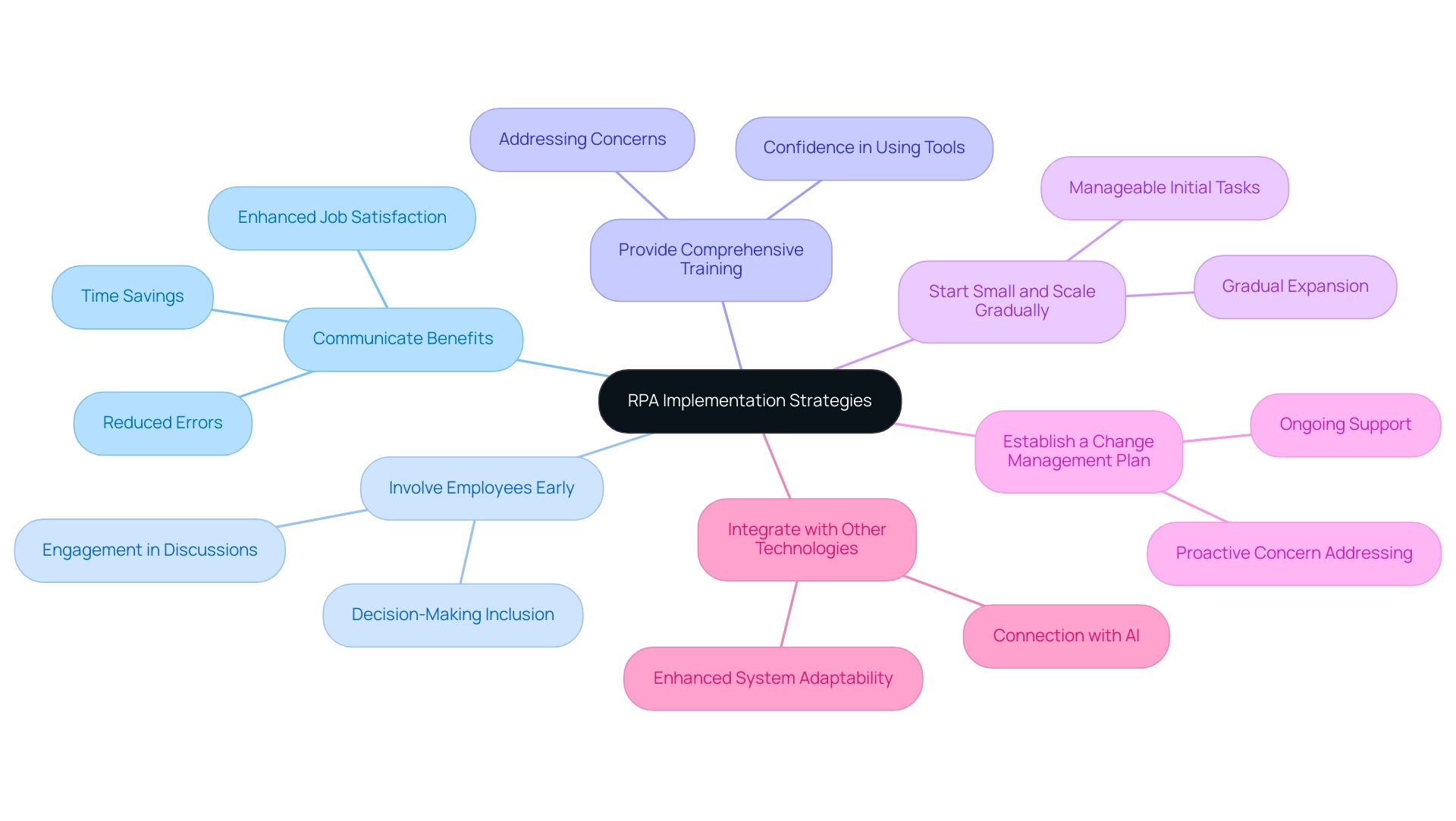
Conclusion
Embracing Robotic Process Automation (RPA) is a transformative step towards achieving operational efficiency in the modern business landscape. With tools like EMMA RPA and Microsoft Power Automate, organizations can tackle repetitive tasks, reduce errors, and ultimately enhance employee satisfaction. The strategic evaluation of these tools allows businesses to select solutions that align with their specific goals, ensuring a tailored approach to automation.
To maximize productivity gains, organizations should focus on:
- Identifying high-impact processes
- Setting clear objectives
- Training employees
- Fostering cross-departmental collaboration
By continuously monitoring and optimizing RPA implementations, businesses can unlock their full potential, driving efficiency and innovation throughout their operations.
Moreover, effective integration of RPA with existing systems is crucial for seamless operations. Conducting system audits, ensuring compatibility, and leveraging APIs can facilitate this integration, allowing organizations to streamline workflows and enhance performance. Regular measurement of key performance indicators will provide valuable insights into the effectiveness of RPA initiatives, ensuring that automation delivers tangible benefits.
Overcoming common challenges in RPA implementation requires a proactive approach that includes:
- Communication
- Employee involvement
- Comprehensive training
By addressing these hurdles, organizations can cultivate a supportive environment that embraces automation as a means to enhance operational success and employee morale.
In a rapidly evolving technological landscape, the adoption of RPA is not just advantageous; it is essential for organizations aiming to thrive. By harnessing the power of automation, businesses can position themselves at the forefront of innovation and efficiency, ultimately achieving their operational goals and fostering a culture of continuous improvement.
Introduction
In the evolving landscape of business operations, the adoption of Robotic Process Automation (RPA) is not just a trend; it is a strategic imperative. As organizations grapple with the demands of efficiency and accuracy, RPA emerges as a powerful ally, enabling the automation of repetitive tasks that once drained valuable human resources.
This technology not only minimizes human error but also reallocates talent to more strategic initiatives, paving the way for enhanced productivity and innovation. With compelling case studies showcasing significant improvements in operational performance across various industries, the potential of RPA to transform workflows is becoming increasingly clear.
However, the journey to successful implementation is not without its challenges, necessitating a careful approach to integration, security, and workforce management.
This article delves into the multifaceted benefits of RPA, its practical applications, and the considerations necessary for realizing its full potential in the modern workplace.
Understanding Robotic Process Automation (RPA) and Its Importance
Robotic Process Automation (RPA) represents a groundbreaking technology that empowers organizations to deploy software robots for executing repetitive tasks traditionally performed by humans. RPA can be used to automate mundane and rule-based processes, significantly enhancing efficiency and accuracy. A case study illustrates how a mid-sized company streamlined operations by integrating GUI automation, reducing data entry errors by 70% and accelerating testing processes by 50%.
This company faced significant challenges, including manual data entry errors and slow software testing, which hindered productivity. The solution not only addressed these issues but also achieved a remarkable ROI within six months, highlighting RPA’s potential in transforming healthcare service delivery. This technology is essential for reducing human error and reallocating valuable human resources to more strategic initiatives, effectively tackling common challenges such as task repetition fatigue and staffing shortages in departmental settings.
As institutions struggle with increasing demands to enhance productivity, RPA can be used to automate processes and emerge as a crucial instrument for attaining excellence in operations. Projections suggest that companies can anticipate cutting expenses by 30% by 2024 through hyper-automation technologies, including RPA. This underscores that RPA can be used to automate processes, which plays a pivotal role in improving efficiency while driving overall business growth.
In fact, a recent study found that 93% of organizations implementing RPA noted improvements in compliance, while 81% reported cost reductions and 77% experienced enhanced management information capabilities. However, despite its benefits, RPA deployment faces challenges such as integration with existing systems, security concerns, and workforce skill set management. Businesses will utilize a mix of RPA, AI, machine learning, and other technological solutions to enhance operations, leading to an estimated 30% decrease in costs by 2024, as highlighted by Gartner.
Moreover, as RPA solution providers steadily develop their platforms, they are improving features and capabilities to meet the varied requirements of companies in their efficiency journey, promoting innovation and refining processes.

Practical Applications of RPA Across Different Industries
Robotic Process Automation (RPA) can be used to automate various processes, emerging as a transformative force across multiple industries and significantly enhancing operational efficiency. In the healthcare sector, a case study illustrates how a mid-sized company streamlined operations through graphical user interface processes, addressing challenges such as:
- Manual data entry errors
- Slow software testing
- The integration of legacy systems without APIs
By automating data entry and system monitoring, the company achieved a remarkable 70% reduction in errors and a 50% acceleration in testing processes, ultimately improving workflow efficiency by 80%.
Additionally, the company realized an ROI within six months of implementing the automation solutions. These measurable outcomes not only demonstrate the effectiveness of RPA but also highlight its role in enhancing patient data management, leading to improved care delivery. According to McKinsey, RPA in medical insurance can reduce claims processing costs by 30% for companies that automate 60-70% of actions associated with claims administration.
Furthermore, in the finance sector, RPA plays a crucial role by automating invoice processing and reconciliation, which accelerates the closing of financial statements while minimizing human error. In retail, RPA optimizes inventory management by automating stock level monitoring and order processing, thereby reducing the likelihood of overstocking or stockouts. The varied uses of RPA can be used to automate its impressive flexibility in tackling industry-specific challenges, which enables companies to boost productivity and efficiency in a swiftly changing AI environment.

Key Benefits of Implementing RPA in Business Processes
Organizations can enhance efficiency because RPA can be used to automate processes, offering a wealth of advantages. RPA can be used to automate mundane, repetitive tasks, which significantly boosts productivity by reducing errors and allowing employees to focus on higher-value activities that require human insight and creativity. This shift is crucial, especially as statistics indicate that robots could contribute as much as 52% of work capacity among RPA adopters, with robots expected to handle 20% of current routine tasks.
Additionally, RPA can be used to automate routine processes, which results in significant cost reductions by decreasing reliance on manual labor. RPA can be used to automate these tasks, which not only cuts costs but also enhances accuracy and compliance, ensuring that software robots execute operations with remarkable precision and consistency. Moreover, RPA facilitates faster processing times, which directly correlates to increased customer satisfaction.
As Tajammul Pangarkar, CMO at Prudour Pvt Ltd, observes, ‘When he’s not ruminating about various happenings in the tech world, he can usually be found indulging in his next favorite interest – table tennis,’ underscoring the importance of finding balance in operational focus. Furthermore, RPA can be used to automate repetitive tasks, which addresses staffing shortages and allows businesses to maintain productivity even with limited personnel. Lastly, the scalability of RPA solutions, such as EMMA RPA and Microsoft Power Automate, shows that RPA can be used to automate the adaptation of businesses to fluctuating demands without the burden of extensive retraining or the need to hire additional staff.
As industry standards for RPA continue to evolve, entities adopting these technologies can capitalize on best practices, interoperability, and security within the RPA ecosystem. Notably, RPA adoption varies significantly across industries, with manufacturing leading at 35%, followed by technology at 31% and healthcare at 10%. These statistics highlight the varied landscape of RPA implementation, where early adopters can take advantage of efficiency benefits, ultimately resulting in more streamlined operations.
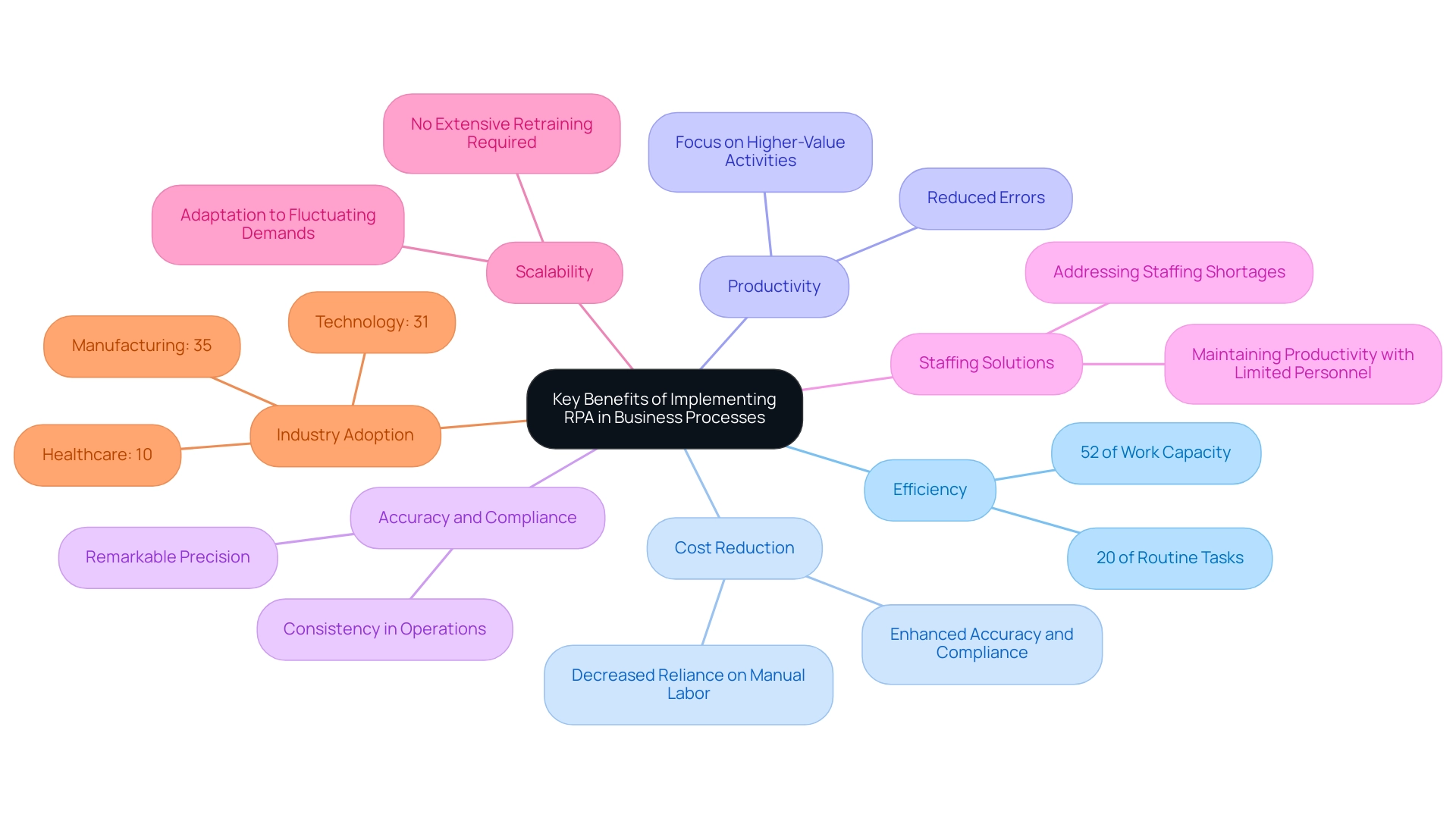
Challenges and Considerations for Successful RPA Deployment
While Robotic Process Automation (RPA) offers a wealth of advantages, organizations face several challenges during its deployment. One primary hurdle is the meticulous identification and mapping of processes before implementation, ensuring that RPA is utilized effectively to maximize its benefits.
Addressing workplace issues such as repetitive tasks and staffing shortages is critical; many employees feel overwhelmed by mundane duties, impacting morale and productivity. While resistance to change remains a significant challenge, RPA can be used to automate and alleviate these burdens. Employees may have concerns about job security with the introduction of technology.
As Xavier Lhuer from McKinsey and Company observes, RPA is a promising new advancement in business processes that offers a potential ROI of 30-200%—in the first year. Employees may like it, too. Engaging employees early in the process and addressing their concerns through effective change management strategies is essential.
A case study titled “Mitigating Employee Resistance to an RPA Implementation” emphasizes that successful RPA implementation relies on easing employee concerns and showcasing the advantages of mechanization, ultimately improving efficiency and job satisfaction.
Moreover, entities must prioritize data security and compliance, as RPA often interacts with sensitive information. Ensuring these systems adhere to relevant regulations is vital for mitigating risks. As stated by Infosys BPM,
Our flexible, global operating model helps you transform your legal function and enable you to focus more on your core business activities,
which emphasizes the need for RPA to align with core business functions.
To modernize outdated systems, entities can implement RPA solutions, as RPA can be used to automate processes like GUI control and intelligent process management, which streamline operations and integrate seamlessly with existing software. Ongoing monitoring and maintenance of RPA systems are also crucial to ensure their effectiveness and adaptability to the dynamic business landscape. For instance, a mid-sized company successfully utilized GUI techniques to reduce data entry errors by 70% and accelerate testing processes by 50%, achieving ROI within six months.
With delivery locations spread across 16 countries, Infosys BPM provides extensive BPM services that can significantly enhance RPA performance. By investing in these areas, businesses not only improve RPA outcomes but also cultivate a culture of continuous improvement. By proactively addressing these challenges, entities can successfully leverage RPA’s transformative power, unlocking value that aligns with their core objectives.

The Future of RPA: Integration with AI and Emerging Trends
The merging of robotic process technology (RPA) and artificial intelligence (AI) is paving the way for more sophisticated and impactful solutions in the business landscape. As entities strive to enhance decision-making capabilities, integrating AI with RPA can be used to automate routine tasks and analyze data, which generates informed recommendations. Many businesses face significant challenges, particularly poor master data quality, which can lead to inconsistent, incomplete, or inaccurate data, ultimately hindering efficient operations and flawed decision-making.
Additionally, there is a common reluctance to adopt AI, with many viewing projects as complex, time-intensive, and costly. However, tailored solutions like Small Language Models (SLMs) provide efficient, secure, and cost-effective data analysis, alleviating these concerns. Notably, methods like K-means and Gaussian Mixture Models have demonstrated an impressive average accuracy rate of 95%, underscoring the effectiveness of intelligent automation technologies.
A case study on fault detection in in-wheel motor bearings illustrates how advanced methods can detect wear faults without compromising structural integrity, proving more suitable for condition monitoring than traditional vibration analysis. Embracing these advancements allows businesses to unlock remarkable efficiencies and foster innovation, as RPA can be used to automate key processes, solidifying their competitive advantage in an increasingly dynamic environment. As we progress, these technologies will undoubtedly redefine operational paradigms, enabling entities to navigate complexities with greater agility and precision.
To explore how your organization can leverage these technologies, consider booking a consultation to discuss tailored solutions that address your specific challenges.
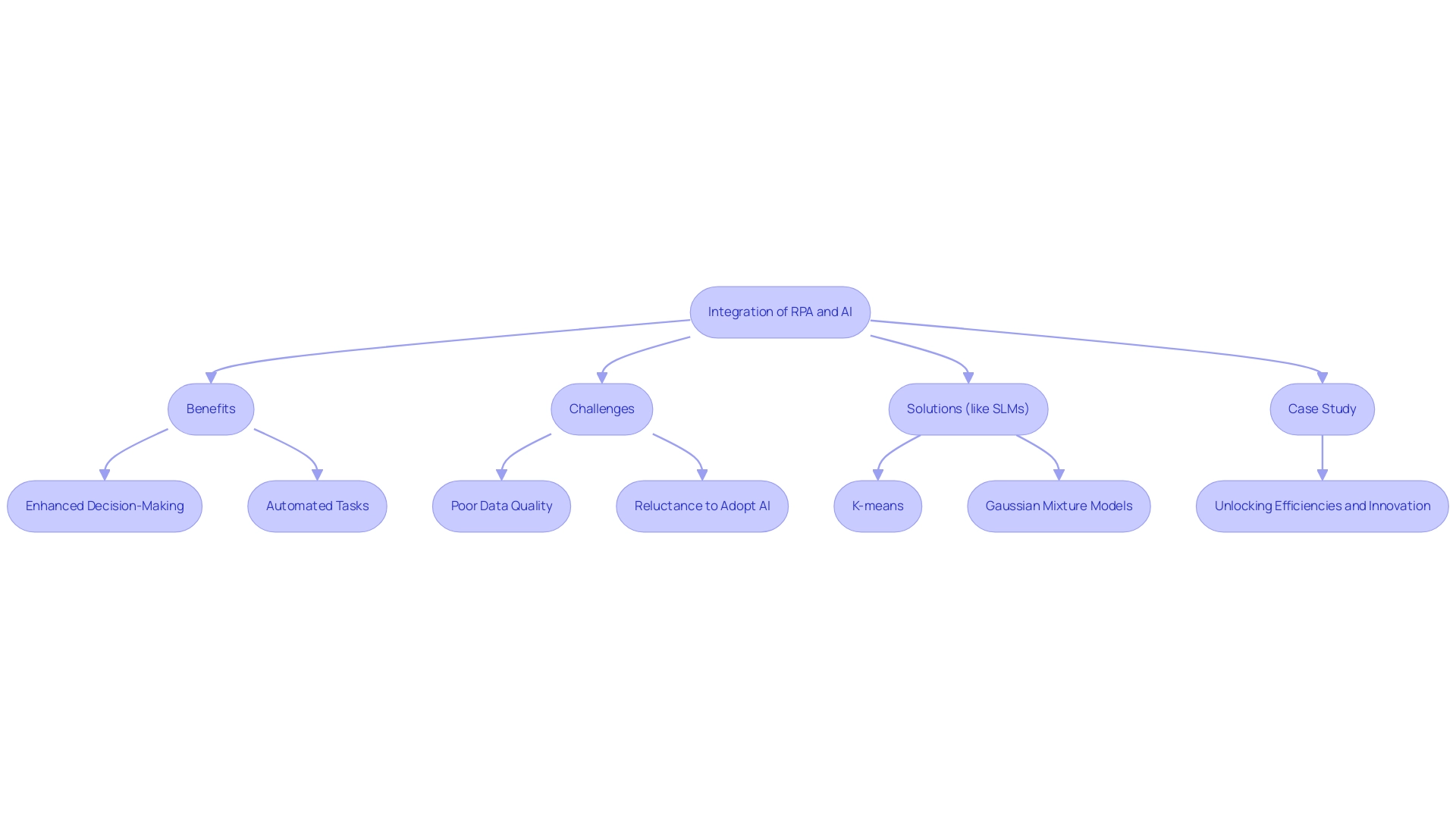
Conclusion
Robotic Process Automation (RPA) is not just a tool; it is a transformative force reshaping how organizations operate across various industries. By automating repetitive tasks, RPA enhances operational efficiency, reduces errors, and reallocates human resources to more strategic initiatives. The compelling case studies presented highlight significant improvements in productivity, with companies achieving remarkable ROI and operational cost reductions. With projections suggesting a 30% reduction in costs by 2024, the strategic importance of RPA in driving business growth cannot be overstated.
However, successful implementation of RPA is not without its challenges. Organizations must navigate the complexities of:
- Process identification
- Employee engagement
- Data security
to fully harness the benefits of automation. Addressing employee concerns and cultivating a culture of continuous improvement are crucial steps in overcoming resistance to change and ensuring a smooth transition.
Looking ahead, the integration of RPA with artificial intelligence presents exciting opportunities for enhanced decision-making and operational agility. As businesses embrace these technologies, they position themselves to thrive in a rapidly evolving landscape. By proactively addressing the challenges of RPA deployment and leveraging its capabilities, organizations can unlock significant value and drive innovation, ultimately achieving operational excellence in their respective fields.
Introduction
In the rapidly evolving landscape of technology, generative AI stands out as a revolutionary force reshaping industries and enhancing operational efficiencies. Unlike traditional AI, which primarily analyzes and interprets data, generative AI creates entirely new content, harnessing advanced algorithms to unlock innovative solutions.
As organizations navigate the complexities of adopting these transformative technologies, they encounter both significant opportunities and challenges. From streamlining workflows with Robotic Process Automation (RPA) to addressing ethical considerations, the journey toward effective AI integration is multifaceted.
This article delves into the core concepts of AI and generative AI, their distinct applications across various sectors, and the strategies organizations can implement to leverage these powerful tools for sustained growth and competitive advantage.
Defining AI and Generative AI: Core Concepts
Artificial Intelligence (AI) encompasses the simulation of human intelligence in machines designed to think, learn, and adapt like people. Within this broad field, generative AI emerges as a transformative subset that specializes in producing new content derived from existing information. This innovative technology sets itself apart from traditional AI, which primarily concentrates on analyzing and interpreting information, leading us to consider what is the opposite of generative AI.
Generative AI harnesses sophisticated algorithms, such as deep learning and neural networks, to create original outputs, including text, images, and music. This distinction is crucial as it sets the stage for understanding the diverse applications and advantages of these technologies. However, many organizations face challenges in adopting AI due to perceptions of it being time-intensive, costly, and difficult to implement. Our custom Small Language Models (SLMs) directly address these concerns by providing efficient information analysis capabilities.
SLMs can quickly process large datasets, yielding actionable insights that enhance decision-making, such as identifying trends and optimizing operations, while ensuring improved privacy since they can be deployed on-premises. Cost-effectiveness is another advantage, as SLMs require less computational power to implement and maintain. In light of the rapidly evolving AI landscape, leveraging Robotic Process Automation (RPA) can further streamline operations by automating manual workflows, significantly enhancing productivity and operational efficiency. By incorporating RPA, organizations can minimize mistakes and allow teams to focus on more strategic, value-adding tasks.
As the interest in Generative Pre-trained Transformers (GPT) has surged by an astonishing 3,600%, it reflects the growing significance and use of generative AI applications across various sectors. While 65% of consumers trust businesses utilizing AI, there remains skepticism about certain applications. Therefore, navigating the overwhelming AI options and identifying tailored solutions, alongside harnessing Business Intelligence to transform raw information into actionable insights, will empower leaders to leverage AI’s capabilities effectively and drive competitive advantage.
To explore how our SLMs can benefit your organization, book a free consultation today.
![A business professional interacting with a futuristic, holographic interface displaying various visual representations and analytics, analyzing graphs and metrics in a modern office setting.]
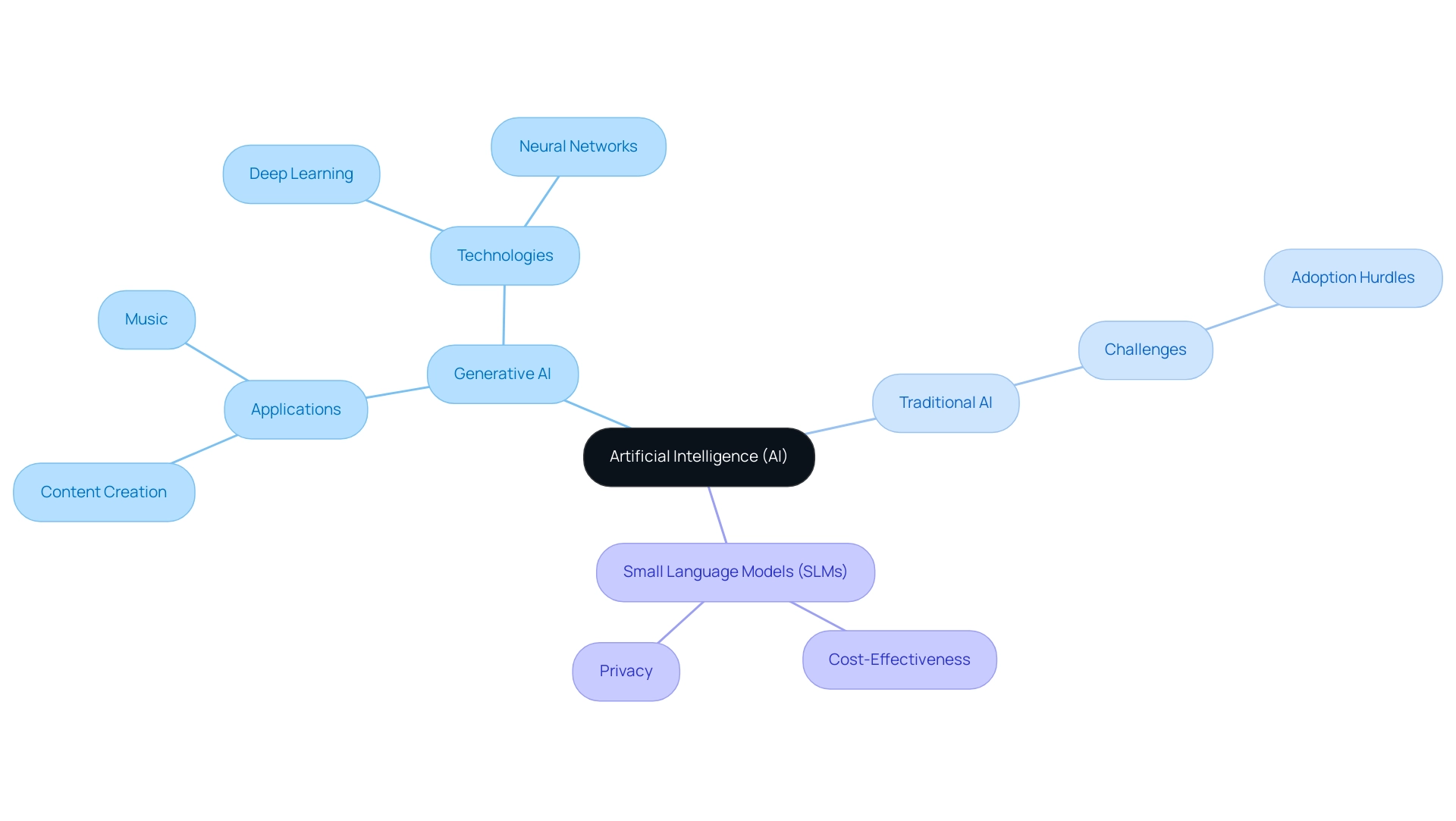
Key Differences Between Generative AI and Traditional AI
Generative AI stands apart from traditional AI through several crucial distinctions that can greatly enhance operational efficiency. While traditional AI mainly concentrates on information analysis, classification, and prediction using established rules and historical information, generative AI utilizes advanced models to generate new content that reflects the patterns inherent in the input. For instance, traditional AI may analyze customer behavior information to forecast sales trends, whereas generative AI can craft entirely new marketing content inspired by existing successful campaigns.
This foundational contrast not only enhances operational capabilities but also unlocks innovative opportunities across various sectors.
As organizations grapple with outdated systems that hinder productivity, integrating Robotic Process Automation (RPA) tools like EMMA RPA can streamline workflows, reduce errors, and free up teams for more strategic tasks. Furthermore, our customized AI offerings, including Small Language Models—created for effective information analysis and enhanced privacy—and GenAI workshops that deliver practical training and bespoke GPT development, ensure improved information quality and actionable insights for informed decision-making. The function of Business Intelligence is essential in this context, as it converts unprocessed information into practical insights, allowing organizations to make knowledgeable choices that promote growth and innovation.
Importantly, both conventional and generative AI can work together to improve offerings like personalized material creation, where traditional AI examines information to guide strategies while generative AI produces customized material. Based on industry insights, generative AI is anticipated to account for 10% of the total produced information by 2025, highlighting its increasing importance in the digital environment. As Bernard Marr aptly points out, ‘Recognizing the unique capabilities of these different forms of AI allows us to harness their full potential as we continue on this exciting journey.’
A case study titled ‘The Future of AI’ illustrates this evolving synergy, showing how traditional AI can perform analysis while generative AI focuses on content creation, thus providing comprehensive solutions that drive efficiency and creativity.
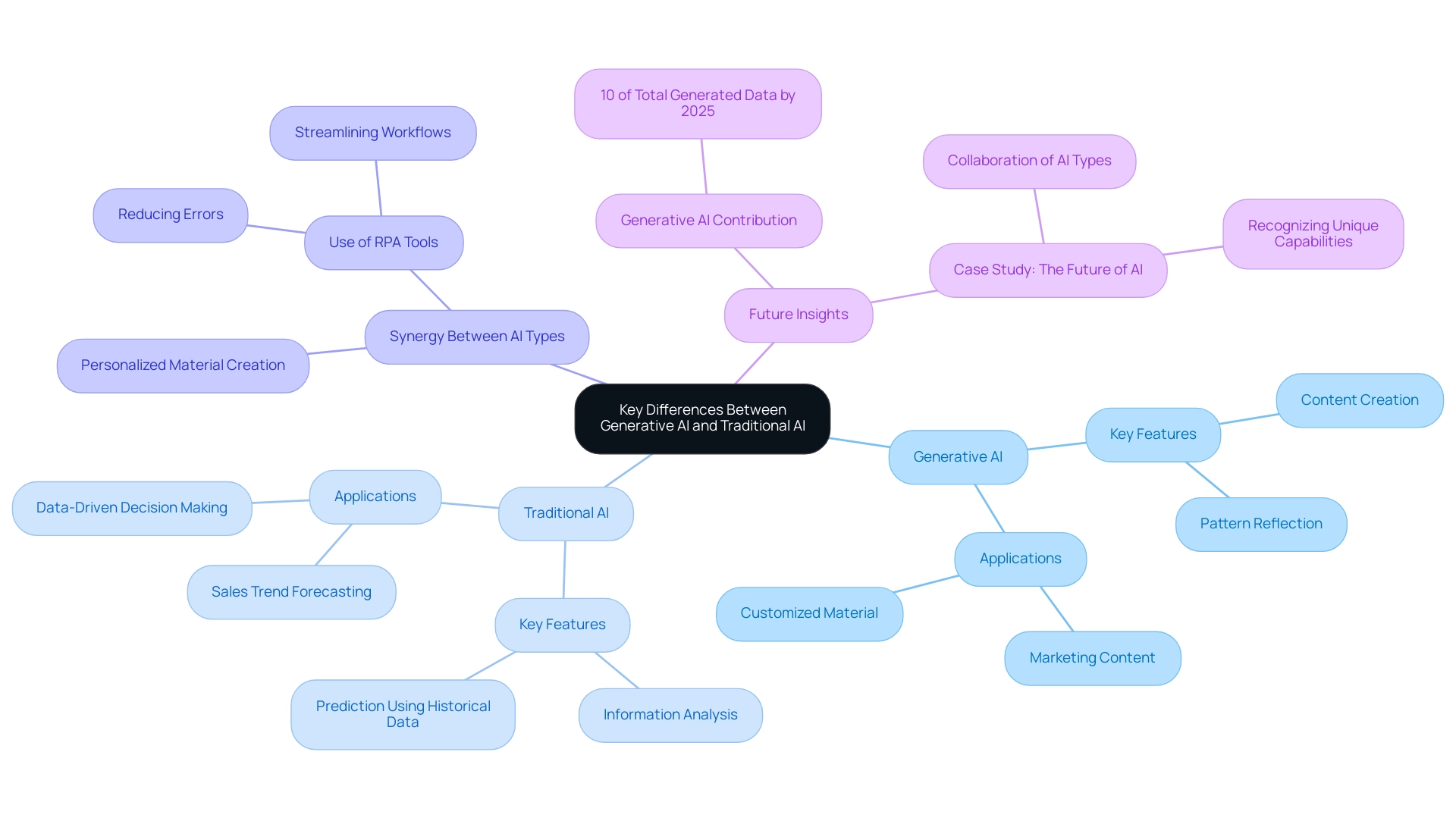
Applications of Generative AI: Transforming Industries
Generative AI is rapidly transforming multiple industries by enhancing creativity and operational efficiency. For instance, in healthcare, a mid-sized company successfully implemented GUI automation to streamline operations by automating information entry, software testing, and legacy system integration. This approach significantly reduced data entry errors by 70%, accelerated testing processes by 50%, and improved overall workflow efficiency by 80%.
The ROI from this implementation was achieved within 6 months, demonstrating the effectiveness of the solution. Such automation not only enhances operational efficiency but also supports healthcare professionals in delivering better service quality. In the creative sector, innovative tools like DALL-E are redefining content creation by generating artwork from textual descriptions, allowing artists to expand their creative horizons.
Furthermore, AI is influencing around 30% of service professionals in the hospitality sector, with 79% of the industry adopting these advanced technologies to enhance customer experience. This trend contributes to a projected growth of the Generative AI market from $632.18 million to an impressive $3.58 billion by 2032, showcasing its impact on both creativity and productivity. In finance, AI assists in developing predictive models that improve risk evaluation and fraud detection, showcasing its ability to promote financial stability.
The case study titled ‘Generative AI in Travel and Hospitality’ illustrates these points, highlighting the anticipated revenue impact by 2024, while emphasizing the importance of business intelligence and RPA in driving data-driven insights and operational efficiency for business growth.
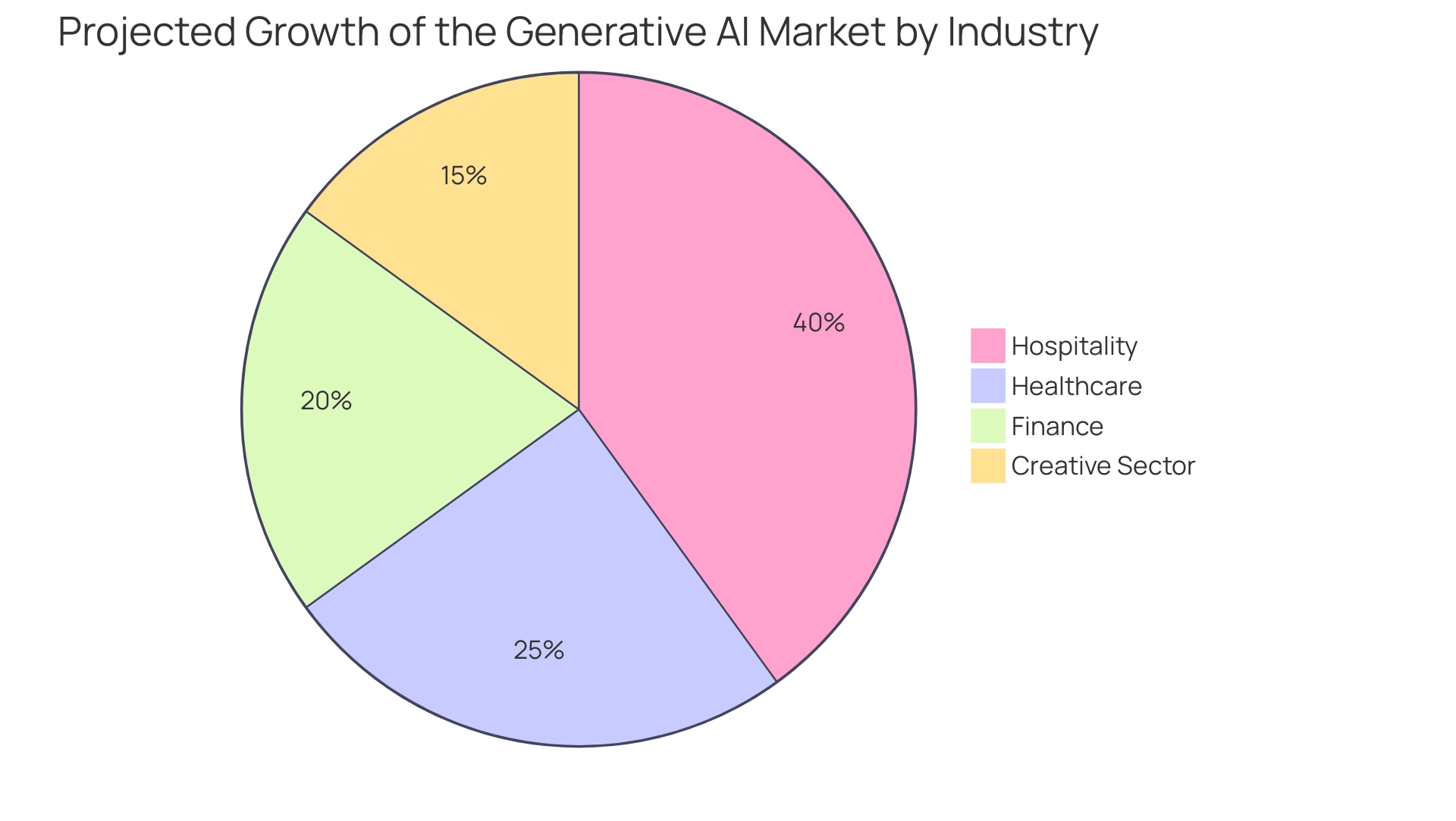
Challenges and Limitations of Generative AI
While generative AI offers transformative potential, navigating the overwhelming AI landscape presents significant challenges. A primary concern revolves around the generation of biased or misleading information, heavily shaped by the data utilized for training. Reports suggest that bias in AI outputs can result in disparities; for instance, studies demonstrate that up to 70% of AI-generated materials can reflect societal prejudices embedded within their training sets.
Moreover, implementing AI can be resource-intensive, demanding substantial computational power and specialized expertise. As technology expert Emily Matzelle states, ‘Organizations must be vigilant about the ethical implications of artificial intelligence, particularly regarding copyright and the potential misuse of produced content.’ To address these challenges effectively, organizations can leverage tailored AI solutions that cut through the noise and align with specific business goals.
For example, integrating Robotic Process Automation (RPA) can streamline repetitive tasks, enhance operational efficiency, and reduce errors, allowing teams to focus on strategic initiatives. The retail sector exemplifies this trend, with AI spending projected to hit $20.05 billion by 2026, driven by 80% of retail executives expecting to adopt AI-powered automation by 2027. Furthermore, a recent survey revealed that 75% of participants anticipate artificial intelligence will lead to significant or disruptive change in their industries, underscoring the necessity of utilizing Business Intelligence to transform raw data into actionable insights, enabling informed decision-making that drives growth and innovation.
Organizations that proactively address these issues will be better positioned to harness the full benefits of creative AI while mitigating its inherent risks.
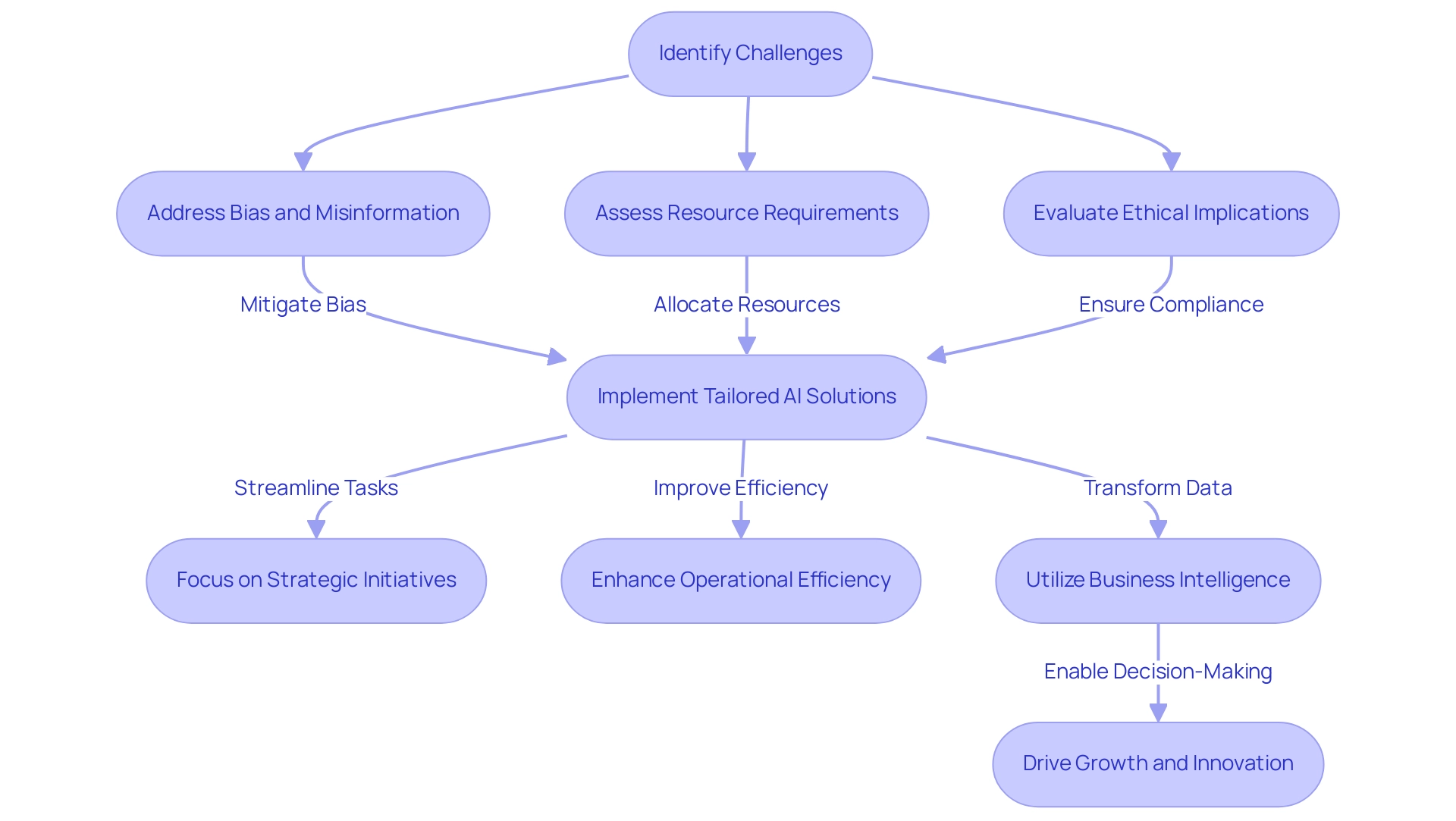
The Future of Generative AI: Trends and Predictions
The future of generative AI holds significant promise, particularly as trends reveal its increasing integration into daily applications across various industries. As technology continues to evolve, we can anticipate the emergence of more sophisticated models that enhance both the quality and relevance of generated content. A remarkable 97% of business owners express confidence that tools like ChatGPT will provide substantial benefits, with 74% expecting AI to facilitate customer interactions.
Notably, 47% anticipate AI will improve their business credibility, highlighting the broad belief in the potential of AI to empower businesses. In this rapidly evolving landscape, leveraging Robotic Process Automation (RPA) becomes crucial for automating manual workflows, reducing errors, and freeing up team resources for more strategic tasks. Industries are likely to experience a surge in collaborative AI systems that complement human creativity, fostering innovative approaches and operational efficiencies.
As ethical frameworks develop, organizations will be better positioned to tackle challenges related to data security and accuracy, further supported by tailored AI solutions that cut through the noise to align with specific business goals. This proactive approach will pave the way for responsible and impactful applications of AI across diverse sectors, aligning with the aspirations of 64% of individuals who see AI as a means to assist and empower consumers. Moreover, addressing barriers to generative AI adoption, such as safety concerns and lack of knowledge, is critical for maximizing its benefits, as indicated by a study revealing that:
- 70% of non-users would be more likely to adopt generative AI with more information
- 64% expressing a desire for greater safety and security in its use
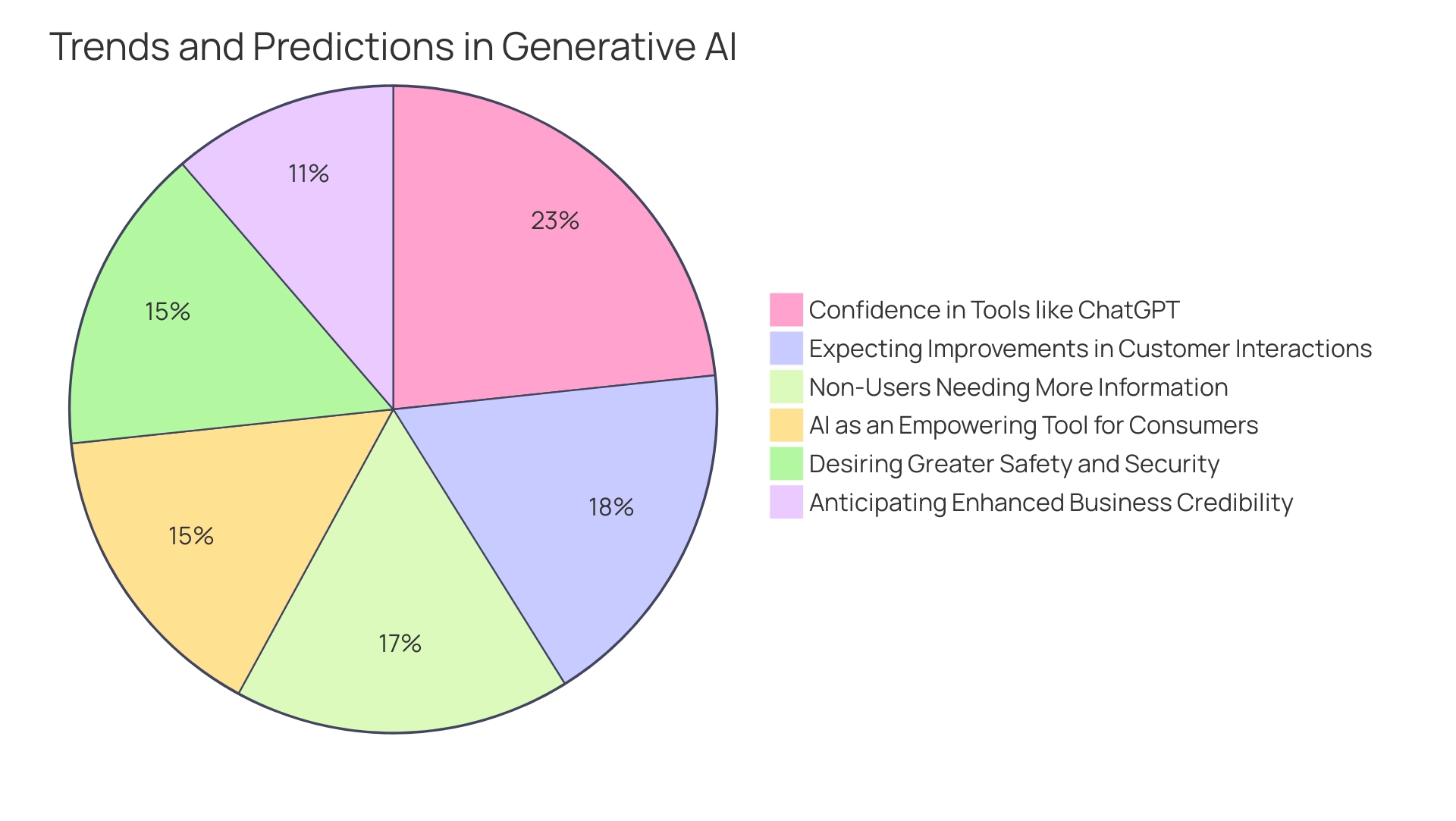
Conclusion
The transformative power of generative AI is evident across various industries, offering unprecedented opportunities for operational efficiency and creativity. By distinguishing itself from traditional AI, generative AI not only analyzes data but also produces innovative content, paving the way for enhanced decision-making and streamlined processes. Organizations can harness this technology effectively by integrating tailored solutions like:
- Small Language Models
- Robotic Process Automation
These solutions facilitate efficient data analysis while minimizing errors and freeing up resources for strategic initiatives.
However, the journey toward successful AI adoption is not without its challenges. Addressing issues such as:
- Bias in AI outputs
- The resource-intensive nature of implementation
is crucial for organizations aiming to leverage generative AI responsibly. By focusing on ethical frameworks and aligning AI initiatives with specific business goals, organizations can better navigate these complexities and unlock the full potential of generative AI.
Looking ahead, the future of generative AI is bright, with trends indicating its deeper integration into everyday applications. As businesses increasingly recognize the value of AI tools, the collaboration between human creativity and AI capabilities will likely lead to innovative solutions that drive growth and efficiency. By proactively addressing barriers to adoption and emphasizing the importance of informed decision-making, organizations can position themselves to thrive in this dynamic landscape, ultimately realizing the vast benefits that generative AI can offer.
Introduction
In an age where data reigns supreme, organizations are grappling with the complexities of transforming unstructured information into structured insights. With unstructured data projected to dominate the data landscape, accounting for up to 80% of total data volume, the potential for discovery and innovation is immense.
However, the path to harnessing this wealth of information is fraught with challenges, from data quality issues to integration difficulties. This article delves into the pivotal techniques, tools, and strategies that empower organizations to navigate these hurdles, convert unstructured data into actionable insights, and ultimately drive operational efficiency.
By embracing advanced technologies such as AI, machine learning, and Robotic Process Automation, businesses can unlock the true power of their data, fostering informed decision-making and sustainable growth in an increasingly data-driven world.
Understanding Structured and Unstructured Data
Structured information is defined as details organized into a specific format, such as databases that utilize rows and columns, allowing for efficient searching and analysis. Common examples include spreadsheets and SQL databases, which facilitate straightforward information manipulation. In contrast, non-formatted information lacks a defined structure, presenting a more intricate challenge for processing.
This category encompasses a wide array of content, including:
- Text documents
- Images
- Videos
- Social media posts
The increasing significance of differentiating between these two categories of information is emphasized by the fact that non-organized information is expected to represent up to 80% of overall volume, highlighting its considerable potential for insights despite the difficulties it presents. Significantly, the expansion of unorganized information is anticipated to reach 181.93% between 2020 and 2025, emphasizing its rising importance.
With the Internet of Things (IoT) anticipated to produce 79.4 zettabytes of information by 2025, and around 60% of entities utilizing artificial intelligence and machine learning in their operations, the capacity to efficiently transform raw content into a structured format is essential. This is where customized AI solutions, such as Small Language Models (SLMs), can play a crucial role by streamlining analysis and enhancing privacy while being cost-effective. However, despite its worth, only 44% of entities are willing to invest in non-structured content, reflecting an inverse investment ratio compared to structured information.
Comprehending these distinctions enables organizations to recognize the suitable conversion methods and tools required for transforming unstructured data to structured data into actionable insights, ultimately improving decision-making processes and operational efficiency. Additionally, addressing the common perception that AI projects are time-intensive and costly is essential for fostering adoption. Utilizing Business Intelligence can greatly assist in converting raw information into actionable insights, facilitating informed decision-making that propels growth and innovation.
Furthermore, utilizing Robotic Process Automation (RPA) can automate manual workflows, further boosting efficiency and freeing up resources for strategic initiatives.
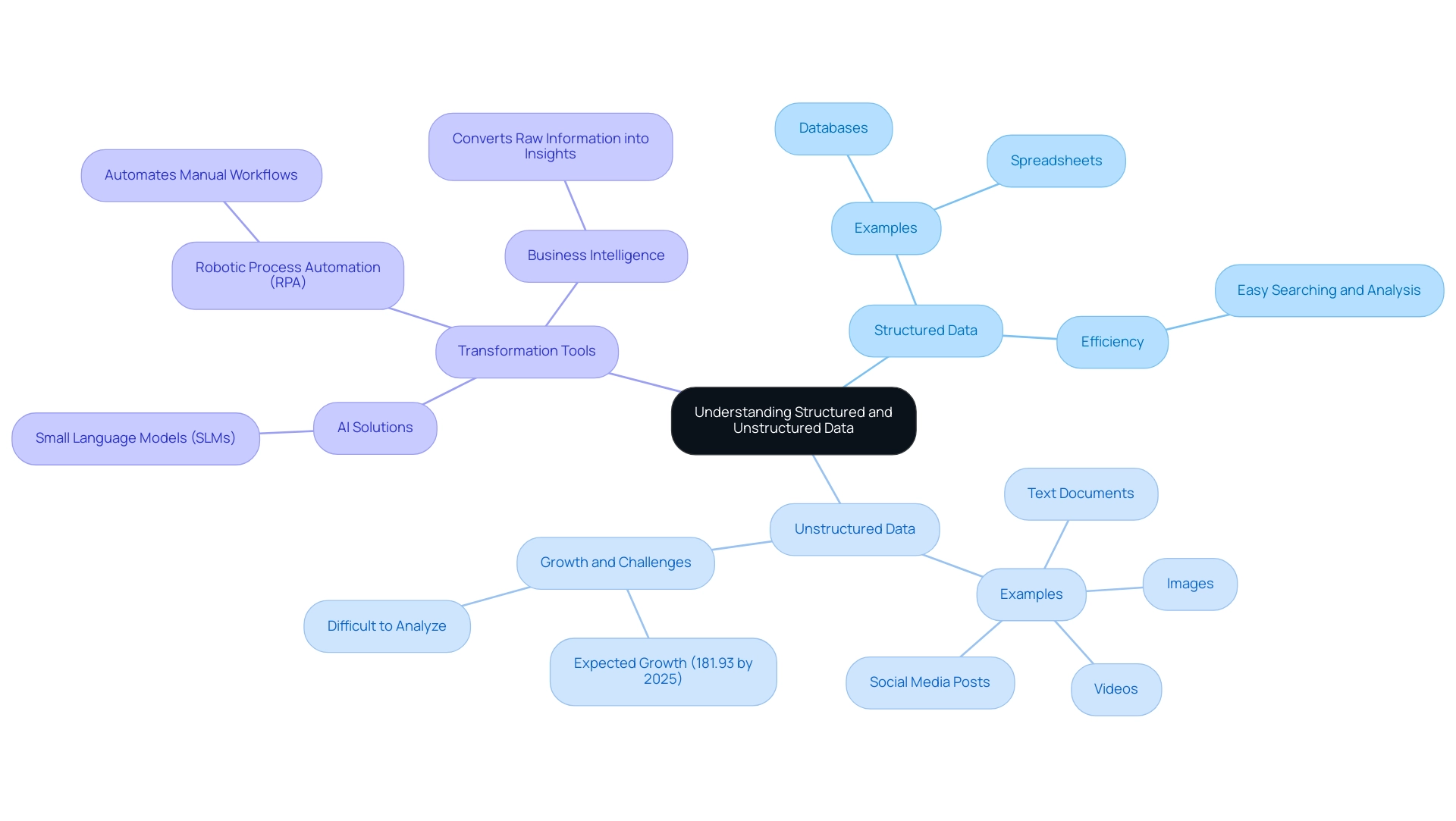
Techniques for Converting Unstructured Data to Structured Data
To effectively transform disorganized information into organized information, several techniques can be utilized, particularly in the context of leveraging Robotic Process Automation (RPA) and Artificial Intelligence (AI):
-
Text Analysis: Leverage natural language processing (NLP) to extract critical information from text documents. Tools such as NLTK and Spacy are instrumental in identifying entities and sentiments, facilitating better organization, and enhancing the capabilities of your Business Intelligence framework.
Data Tagging: Implement robust tagging systems that categorize content, facilitating the transformation of unstructured data to structured data and streamlining the organization process. Utilizing RPA solutions like EMMA RPA can automate this tagging process, improving efficiency and reducing manual errors. -
Machine Learning: Develop machine learning models to classify and structure information by recognizing patterns and features to convert unstructured data to structured data. This approach has shown promising results, with 78% of firms utilizing AI-enhanced applicant tracking systems reporting improved efficiency in locating exceptional employees. Tailored AI solutions can further enhance these models for specific business needs.
-
Optical Character Recognition (OCR): For converting scanned documents and images into text, consider employing OCR tools like Tesseract, which accurately extracts textual content, thereby enhancing accessibility to information and supporting effective information communication.
-
Manual Input: In scenarios where automation is not feasible, manual input remains a viable option to ensure the accuracy and completeness of structured information. However, integrating RPA tools like Microsoft Power Automate can minimize this need and boost employee morale by reducing repetitive tasks.
In 2024, it is projected that 25% of financial institutions will adopt NLP-based solutions for applications such as sentiment analysis and document processing, underscoring the increasing reliance on NLP tools for text analysis. This shift reinforces the importance of staying abreast of advancements in this field. Notably, the NLP market is experiencing rapid growth, driven by demand for AI-powered chatbots and automated customer service solutions, as evidenced by the case study titled ‘Market Dynamics of NLP.’
By applying these techniques and utilizing tools like EMMA RPA and Microsoft Power Automate, entities can significantly enhance their information structuring capabilities, effectively converting unstructured data to structured data, ultimately leading to more informed decision-making and operational efficiency. For implementation guidance, consider scheduling a consultation to explore how these solutions can be tailored to your specific business needs.
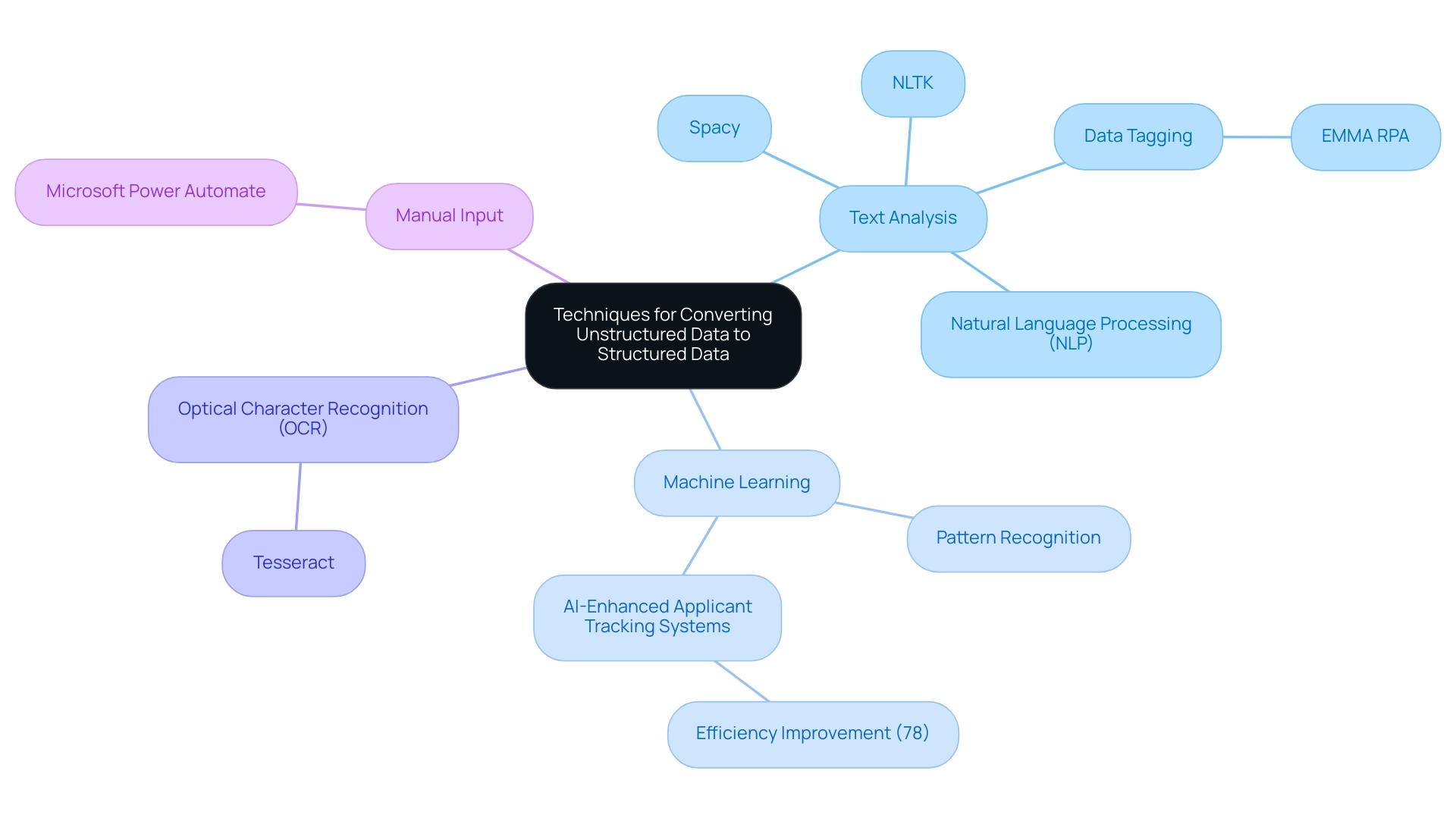
Tools and Technologies for Data Structuring
A variety of innovative tools and technologies are available to facilitate the conversion of unstructured data to structured data, enabling organizations to harness the full potential of their assets. According to TechTarget’s Enterprise Strategy Group survey of 361 IT professionals, effective information structuring is increasingly recognized as a critical capability for operational efficiency. Here are some of the most effective options for 2024:
-
Apache NiFi: This open-source tool excels in automating information flow between systems. With its intuitive user interface, Apache NiFi allows for real-time ingestion and transformation of information, making it a powerful choice for organizations looking to streamline their management processes.
-
Talend: As a comprehensive integration platform, Talend offers robust capabilities for preparation, transformation, and migration. Its cloud-based solutions ensure scalability and flexibility, catering to the needs of modern enterprises seeking efficient information handling solutions.
-
Alteryx: Renowned for its advanced analytics capabilities, Alteryx empowers users to blend information from diverse sources effortlessly. Its user-friendly interface supports complex transformations, making it an ideal choice for analysts aiming to derive actionable insights from their information.
-
Microsoft Power BI: This business analytics service transforms information into interactive visualizations, enhancing business intelligence capabilities. However, many organizations face challenges such as time-consuming report creation, inconsistencies, and a lack of actionable guidance from their Power BI dashboards. Addressing these issues is essential for maximizing the value of insights driven by information.
-
Python Libraries: For those who prefer a coding approach, libraries such as Pandas and NumPy are invaluable for manipulation and structuring of information. These libraries provide extensive functionalities for analysis and transformation, catering to users with technical expertise.
Integrating RPA solutions can further enhance these processes by automating manual workflows, reducing errors, and freeing up teams for more strategic tasks. Specifically, RPA can streamline repetitive tasks, allowing employees to focus on higher-value activities that drive business growth. Additionally, tailored AI solutions can assist entities in navigating the overwhelming landscape of available technologies, ensuring they select the right tools that align with their specific needs.
By leveraging these tools and addressing the challenges in information reporting, organizations can make informed, evidence-based decisions with confidence, ensuring they remain competitive in an increasingly information-centric landscape. It is important to evaluate these tools within the context of the graphic published by Gartner, which provides insights into the market share of structuring tools for 2024. Notably, Gartner does not endorse any vendor, product, or service depicted in its research publications and disclaims all warranties regarding the research, ensuring that the information presented is impartial and objective.
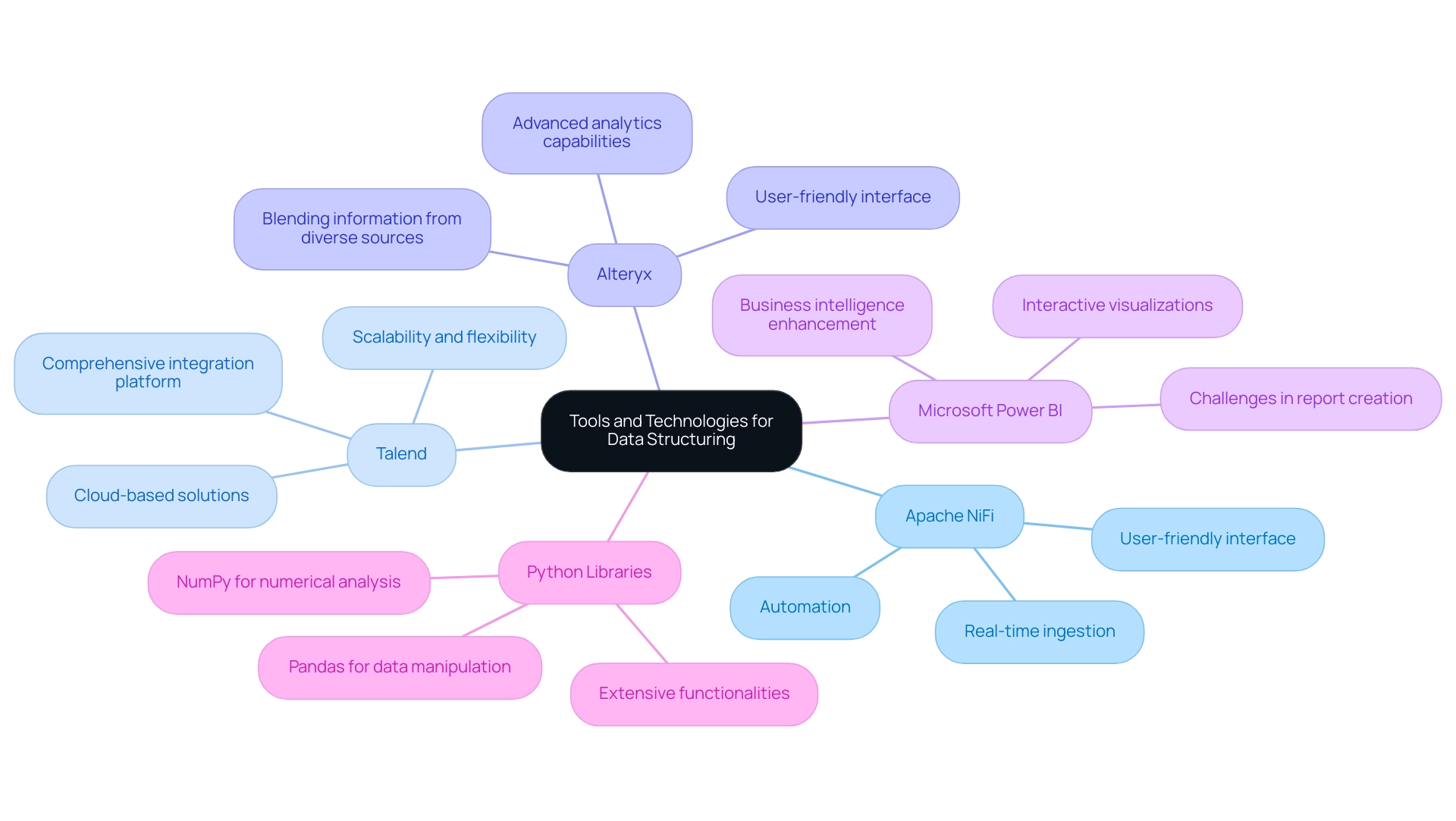
Challenges in Converting Unstructured Data
Transforming unstructured information into organized formats is fraught with challenges that require strategic approaches to ensure success:
-
Quality Issues: Unstructured content often harbors inaccuracies, duplicates, or irrelevant information that complicate the conversion process. According to a survey carried out by TechTarget’s Enterprise Strategy Group involving 361 IT professionals, many companies struggle with these information quality issues, emphasizing the need for robust cleansing techniques. A proactive approach, including leveraging Robotic Process Automation (RPA) and tailored AI solutions, can significantly improve the overall quality of the information being transformed from unstructured data to structured data, thereby enhancing operational efficiency.
-
Integration Difficulties: The integration of structured information with existing systems is intricate, particularly when faced with diverse formats and sources. A thorough mapping strategy, enhanced by customized AI solutions, can enable smoother integration, allowing entities to leverage the full potential of their information and overcome technology implementation obstacles.
-
Scalability: As the volume of unstructured information continues to grow, the challenge of maintaining efficient conversion processes intensifies. Employing automation tools such as RPA can greatly improve scalability, allowing companies to convert unstructured data to structured data while handling rising information loads without compromising quality or speed, thus fostering business growth.
-
Resistance to Change: Employees may show hesitance in embracing new information management practices. To overcome this barrier, it is essential to provide thorough training on RPA and AI solutions, clearly demonstrating their benefits in organized information management. Involving employees in the transformation process encourages acceptance and collaboration, clearing the path for effective implementation.
Insights from TechTarget’s report, ‘State of DataOps: Unleashing the Power of Information,’ indicate that many entities encounter considerable quality challenges, especially in the area of unstructured information. The report outlines critical success factors for DataOps platforms and emphasizes the necessity of addressing these challenges to optimize information management strategies moving forward. By utilizing RPA, customized AI solutions, and Business Intelligence, companies can convert unstructured data to structured data, transforming raw information into actionable insights that facilitate informed decision-making and foster growth and innovation.
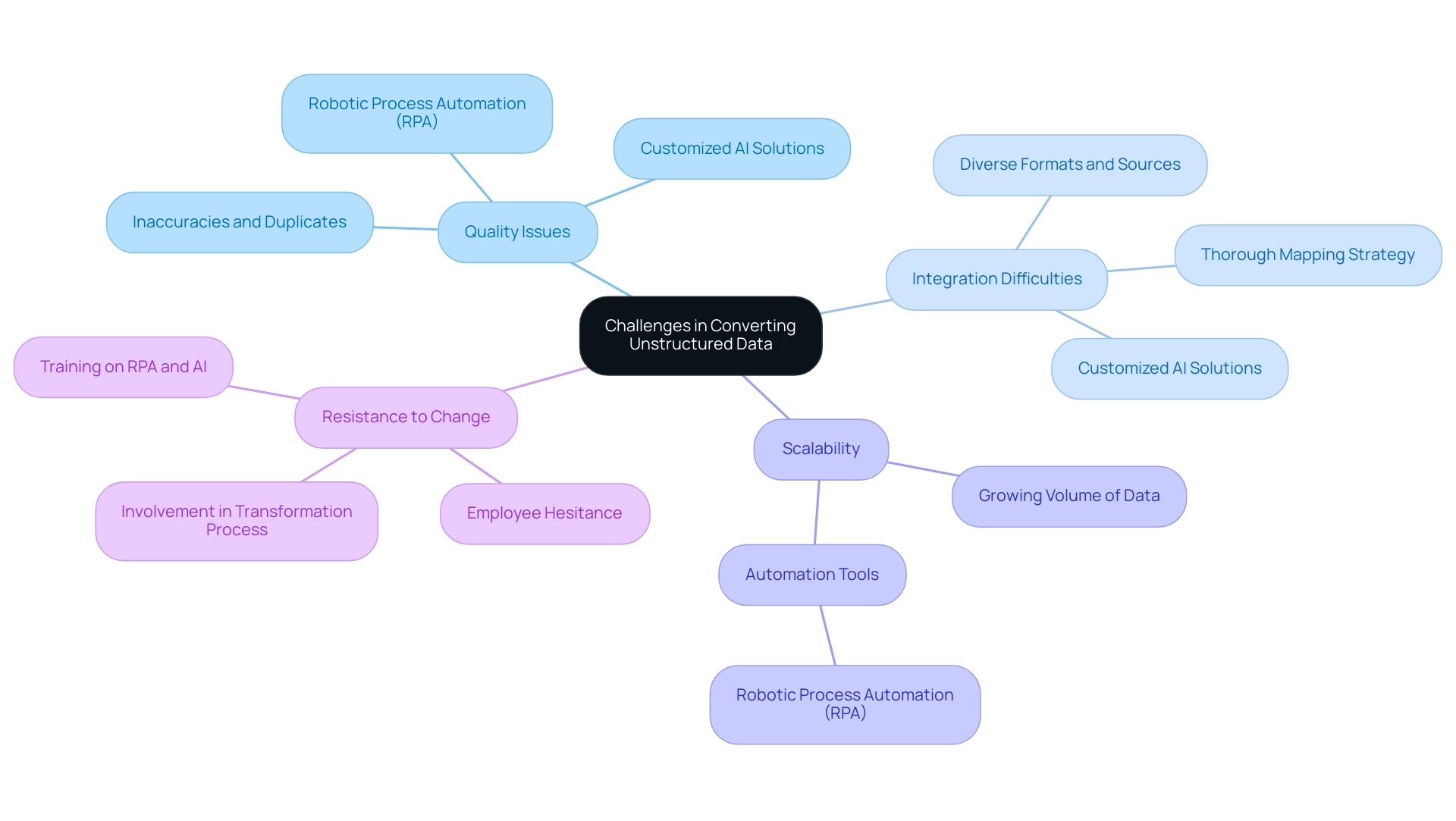
Future Trends in Data Structuring and Management
As we look to the future, several pivotal trends are set to redefine information structuring and management:
-
Increased Use of AI and Machine Learning: The ongoing integration of AI technologies is revolutionizing how businesses automate information structuring processes, driving enhanced analysis capabilities. With investments like NVidia’s $50 million in Recursion Pharmaceuticals, the impact of AI on operational efficiency is becoming more pronounced, especially in sectors like healthcare. Companies are leveraging tailored AI solutions alongside Robotic Process Automation (RPA) to automate repetitive tasks, enhancing accuracy, boosting efficiency, and allowing staff to concentrate on strategic initiatives.
-
Real-time Information Processing: The demand for rapid insights is pushing businesses toward real-time information structuring. This capability not only enables quicker decision-making but also enhances responsiveness to market shifts, fostering agility in operations. Retail firms, for example, utilize real-time analytics to track inventory levels, ensuring they satisfy customer demand without overstocking, thus improving overall productivity.
-
Integration of Big Data Technologies: As entities seek to derive value from vast amounts of unstructured data to structured data, employing robust analytics tools alongside RPA will be essential. These technologies will facilitate the extraction of actionable insights, empowering companies to make informed strategic decisions. The integration of AI with extensive information analytics has significantly enhanced operational efficiency across various industries.
-
Focus on Information Privacy and Compliance: With increasing scrutiny around privacy, organizations must ensure their structuring practices adhere to regulations like GDPR and CCPA. This compliance need drives the development of robust information governance frameworks, balancing innovation with ethical considerations. In 2024, a principled commitment to ethical AI in sectors like healthcare will likely expand, emphasizing the importance of ethical frameworks in policy implementation. Organizations are increasingly adopting comprehensive compliance strategies, such as conducting regular audits and implementing advanced data encryption, to safeguard sensitive information.
As these trends evolve, leveraging RPA and Business Intelligence tools will be crucial for maintaining long-term operational competitiveness in the rapidly changing business landscape. By addressing the challenges posed by manual, repetitive tasks, organizations can enhance efficiency and enable their teams to focus on more strategic, value-adding work.
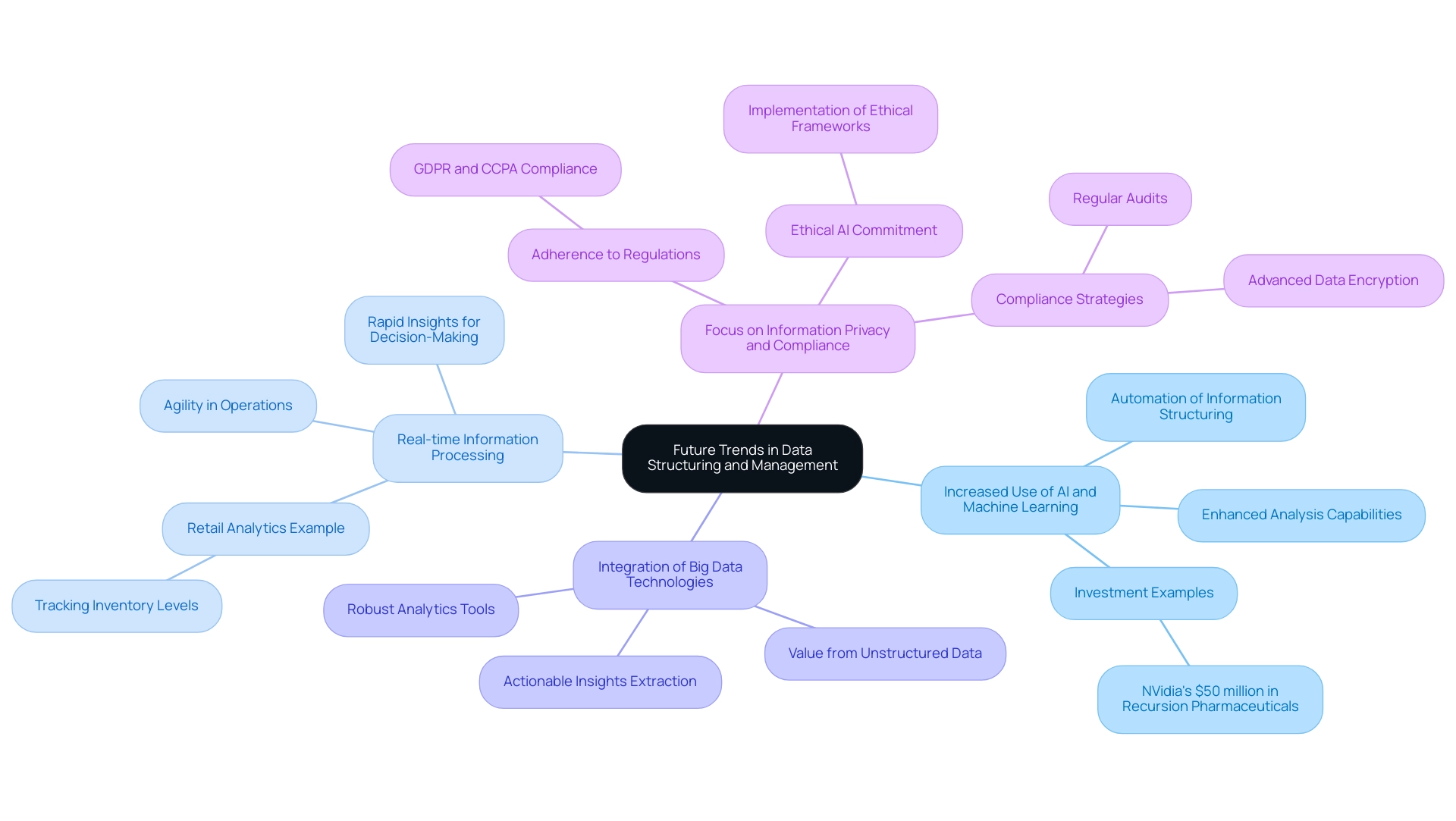
Conclusion
The journey of transforming unstructured data into structured insights is essential for organizations aiming to thrive in today’s data-centric environment. Understanding the distinctions between structured and unstructured data is the first step, as unstructured data is set to dominate the data landscape, presenting both opportunities and challenges. By employing advanced techniques such as:
- Text analysis
- Data tagging
- Machine learning
organizations can effectively harness the value of their unstructured data, turning it into actionable insights that drive informed decision-making.
Utilizing innovative tools and technologies plays a crucial role in this transformation. From Apache NiFi to Microsoft Power BI, the right solutions can streamline data management processes, enhance operational efficiency, and empower teams to focus on strategic initiatives. However, organizations must also navigate challenges such as:
- Data quality issues
- Integration difficulties
which can hinder the conversion process. By adopting robust data cleansing techniques and fostering a culture of adaptability among employees, organizations can overcome these obstacles and fully realize the potential of their data assets.
Looking ahead, the integration of AI and machine learning, alongside a commitment to data privacy and compliance, will shape the future of data structuring and management. As organizations embrace real-time data processing and big data technologies, they position themselves to respond swiftly to market changes and drive innovation. By leveraging the insights gained through these advancements, businesses can not only enhance operational efficiency but also foster sustainable growth in an increasingly competitive landscape. The time to act is now; embracing these strategies will unlock the true power of data, paving the way for informed decision-making and long-term success.
Introduction
In the rapidly evolving landscape of modern business, the pursuit of efficiency and effectiveness has never been more critical. Business Process Optimization (BPO) emerges as a vital strategy, enabling organizations to streamline operations, reduce waste, and enhance overall productivity.
By dissecting existing workflows and leveraging innovative technologies like Robotic Process Automation (RPA), companies can not only overcome operational challenges but also elevate employee satisfaction and customer experiences.
As organizations navigate the complexities of implementing these solutions, understanding the benefits, challenges, and metrics for success becomes paramount.
This article delves into the transformative power of BPO, offering insights and practical strategies for leaders aiming to drive sustainable growth and innovation in their operations.
Defining Business Process Optimization: Key Concepts and Importance
What is business process optimization? It is a strategic framework aimed at systematically enhancing an organization’s operations to maximize efficiency, effectiveness, and adaptability. This involves a thorough analysis of existing workflows to identify inefficiencies and implementing targeted changes to streamline operations, which helps to understand what is business process optimization. The significance of BPO is underscored by recent findings, revealing that 72% of business executives in Europe credit improved customer satisfaction to their BPM initiatives, highlighting a recent trend in the industry.
Additionally, insights from BPM Trends suggest that 70% of business leaders acknowledge that effective business management is essential for achieving their organizational objectives. By adopting methodologies such as Lean Six Sigma, companies can eliminate waste and ensure that each step in a process contributes value. With the integration of Robotic Process Automation (RPA) solutions like EMMA RPA and Microsoft Power Automate, organizations can revolutionize their operations, overcoming outdated systems and significantly enhancing productivity.
- EMMA RPA, with its intelligent features, facilitates seamless digitalization by mechanizing repetitive tasks, reducing errors, and enhancing employee morale.
- Power Automate optimizes workflows by linking applications and data, making processes accessible and efficient.
A compelling case study demonstrated how a mid-sized company faced challenges such as manual data entry errors and slow software testing.
By implementing GUI automation, they automated data tasks, resulting in a 70% reduction in errors and an 80% improvement in workflow efficiency within just six months. This highlights the critical role of continuous staff development in maximizing the benefits of BPM initiatives and achieving a strong ROI, as companies that invest in robust training for BPM programs are 2.1 times more likely to see increased returns.
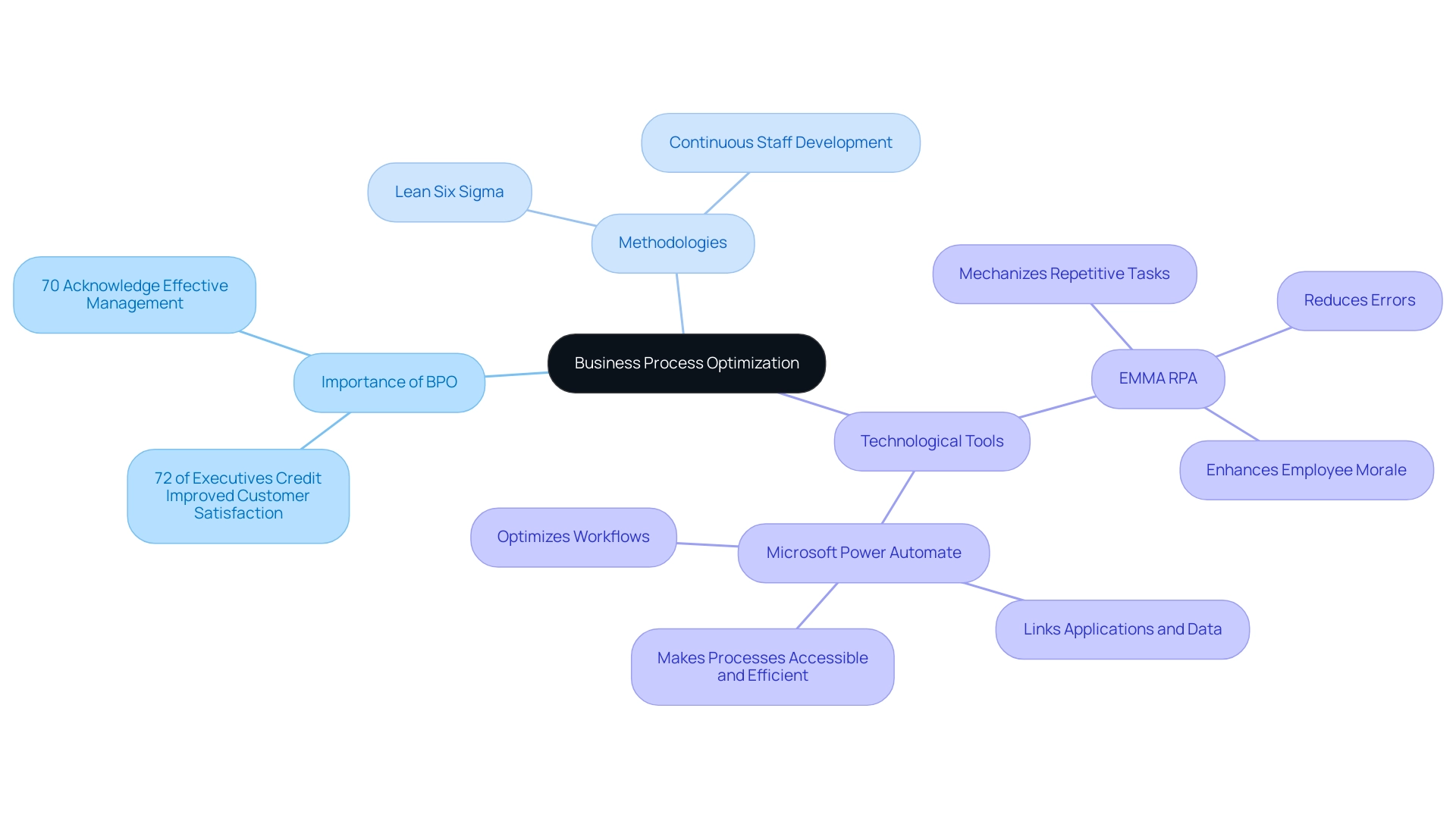
The Benefits of Business Process Optimization: Enhancing Efficiency and Performance
What is business process optimization (BPO) and how it provides a multitude of benefits that can drive transformative changes within any entity? Primarily, understanding what is business process optimization fosters operational efficiency by streamlining workflows, which can result in substantial cost savings. For instance, organizations adopting Robotic Process Automation (RPA) can significantly reduce manual tasks, thereby minimizing errors and empowering employees to concentrate on higher-value activities.
Notably, telecom operators are leveraging RPA to automate customer service processes and reduce manual data entry, showcasing a relevant application of BPO in the industry. Recent data suggests that 90% of invoices not linked to a purchase order are handled manually, emphasizing a crucial opportunity for mechanization. Moreover, RPA has been demonstrated to boost job satisfaction, with 91% of staff recognizing that mechanization saves time and enhances their work-life balance, resulting in 89% feeling more content with their roles.
Additionally, 83% of employees utilizing AI-powered systems believe it can help reduce burnout, further underscoring the positive impact of technology on employee well-being.
Alongside these advantages, understanding what is business process optimization is crucial for enhancing performance metrics by aligning processes with overarching business goals. This alignment enables organizations to respond more swiftly to market demands, ultimately enhancing customer experiences. However, the implementation of automated processes can present challenges, such as the complexities of integrating new technologies with existing systems and overcoming resistance to change.
Tackling these challenges is where customized AI solutions are relevant, offering focused technologies that align with specific business goals and simplify processes. Case studies show that GUI technology significantly improved operational efficiency, with mid-sized firms realizing a 70% decrease in data entry mistakes and a return on investment within six months. As Gartner points out, the complexities and siloed nature of automation deployment pose challenges for companies.
However, by strategically implementing BPO, leaders can effectively navigate these hurdles while understanding what is business process optimization, leveraging tailored AI solutions and Business Intelligence to drive data-driven insights and operational efficiency, positioning their entities for sustained growth and innovation in today’s competitive landscape. To explore how these solutions can be tailored to your specific needs, consider scheduling a consultation with our experts.

Challenges in Implementing Business Process Optimization
Implementing what is business process optimization (BPO) presents a range of challenges, particularly staff resistance to change. This resistance often stems from apprehension surrounding established workflows and a lack of understanding regarding the benefits of optimization, coupled with fears of job displacement. Recent statistics indicate that a significant portion of employees show hesitation towards changes in procedures, highlighting the need for companies to proactively respond to these feelings.
Given that 92% of decision-makers believe their organization is likely to expand digital communication channels, adapting to change is more crucial than ever. Moreover, the complexities inherent in current systems can complicate efforts to pinpoint areas for enhancement. To successfully navigate these hurdles, it is vital to involve staff throughout the optimization process.
Clear communication about the benefits of RPA solutions, such as EMMA RPA and Power Automate, which streamline repetitive tasks, reduce errors, and free up resources for strategic initiatives, can transform potential resistance into collaboration. By modernizing with RPA, companies can also tackle staffing shortages and outdated systems that hinder productivity. Adopting a phased approach to BPO allows for gradual changes, making it easier for employees to adapt.
The experiences of various entities, such as a tech startup that embraced agility to pivot markets and a healthcare institution that utilized strong leadership to revamp patient care systems, offer valuable lessons for future transformations. By fostering a culture centered on continuous improvement and leveraging Business Intelligence for data-driven insights, organizations can effectively overcome the challenges associated with what is business process optimization, paving the way for a more engaged and adaptable workforce.

Measuring Success in Business Process Optimization
Measuring success in what is business process optimization (BPO) is fundamentally about establishing key performance indicators (KPIs) that resonate with your organizational objectives. Metrics such as:
- Cycle time
- Cost per transaction
- Error rates
- Customer satisfaction scores
serve as critical benchmarks. Notably, companies that invest in robust employee training for BPM programs are 2.1 times more likely to increase their ROI than those that do not train employees thoroughly.
This underscores the importance of thorough training to drive these metrics effectively. For example, a mid-sized company that implemented GUI automation successfully reduced its data entry errors by 70% and accelerated its testing activities by 50%, which significantly enhanced operational efficiency and directly correlated with increased customer satisfaction and retention. The company encountered difficulties like manual data entry mistakes and sluggish software testing procedures, which were worsened by obsolete systems that obstructed their operational capabilities.
Successful BPM implementation necessitates time, effort, and dedication from everyone involved, emphasizing the collaborative aspect of the effort. For instance, the Scrap Rate KPI illustrates how measuring production efficiency can lead to optimized methods and reduced waste. By monitoring this KPI and implementing RPA solutions, such as GUI automation, companies can effectively tackle common challenges such as repetitive tasks and staffing shortages, resulting in streamlined operations.
To ensure ongoing success, it is essential to implement feedback mechanisms that allow for continuous insights from both employees and customers. This approach facilitates regular adjustments and refinements of processes, which is crucial for understanding what is business process optimization, ensuring that BPO initiatives remain dynamic and aligned with shifting business objectives and market conditions. By focusing on measurement and feedback, along with leveraging RPA solutions to address outdated systems, organizations can foster a culture of continuous improvement, ultimately leading to optimized performance and sustained success in their operations.
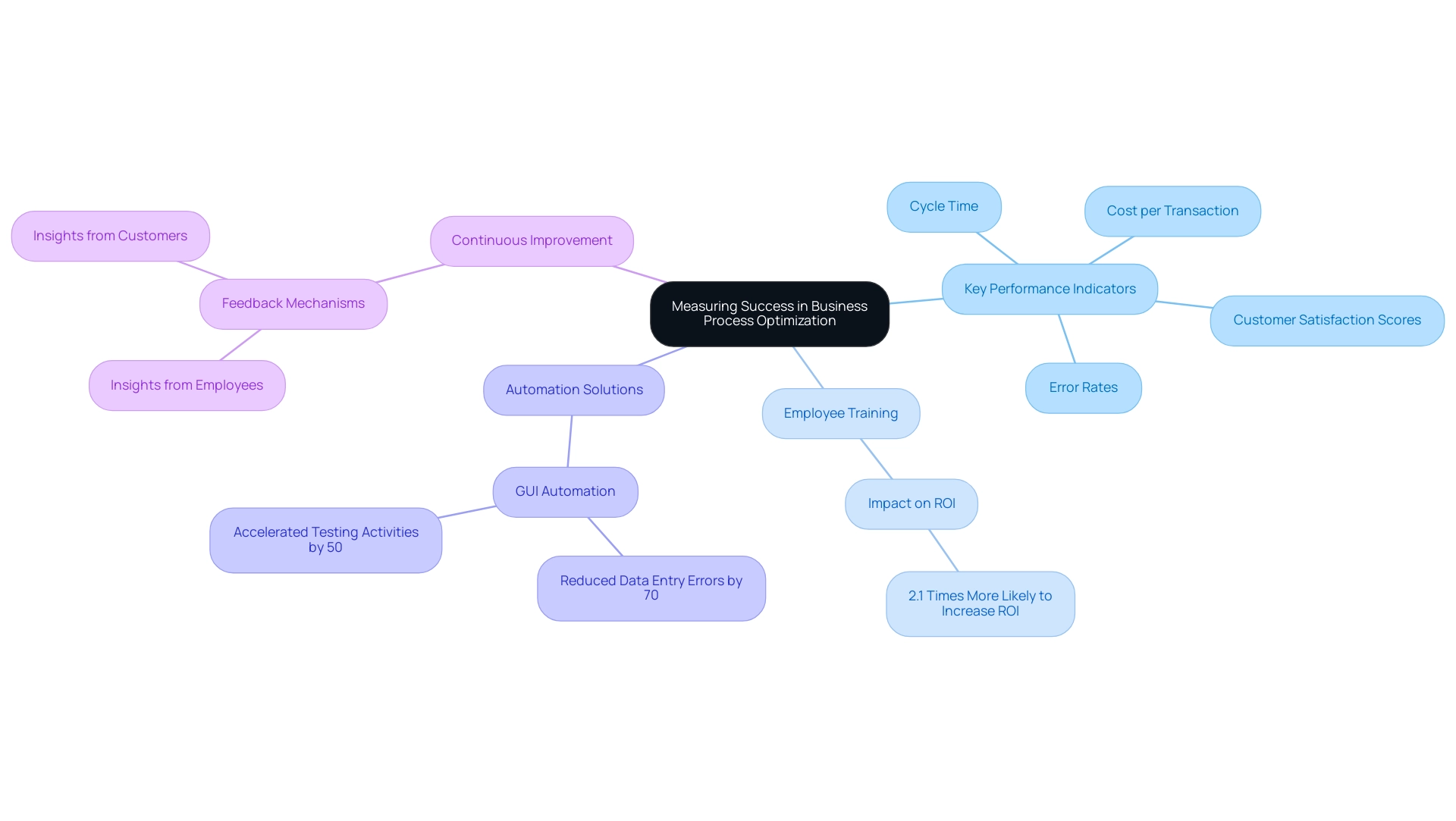
Conclusion
Business Process Optimization (BPO) stands as a critical strategy for organizations aiming to enhance efficiency and effectiveness in today’s fast-paced business landscape. By systematically analyzing workflows and incorporating innovative technologies like Robotic Process Automation (RPA), companies can streamline operations, reduce waste, and ultimately improve productivity. The benefits of BPO extend beyond mere efficiency; they encompass enhanced employee satisfaction and superior customer experiences, as evidenced by various case studies showcasing significant reductions in errors and workflow inefficiencies.
However, the journey toward successful BPO implementation is not without its challenges. Employee resistance to change and the complexities of existing processes can pose significant hurdles. To overcome these obstacles, organizations must prioritize transparent communication and active engagement with their workforce, fostering a culture of collaboration and continuous improvement. By adopting a phased approach and leveraging tailored AI solutions, businesses can navigate the intricacies of BPO, ensuring that transformations are both effective and sustainable.
Measuring success in BPO is essential for ongoing improvement and alignment with organizational goals. Establishing clear key performance indicators allows companies to track progress and adapt strategies as needed. The integration of feedback mechanisms from employees and customers further strengthens the optimization process, ensuring that initiatives remain relevant and impactful. Embracing BPO not only empowers organizations to enhance operational performance but also positions them for sustained growth and innovation in an increasingly competitive environment. Now is the time to harness the transformative power of BPO and drive your organization toward a more efficient and successful future.
Introduction
In a world where efficiency and accuracy are paramount, organizations are increasingly turning to Robotic Process Automation (RPA) as a solution to streamline operations and enhance productivity. RPA technology empowers businesses to automate repetitive, rule-based tasks, freeing up valuable human resources for more strategic initiatives.
As companies strive to improve their operational effectiveness, the role of the RPA Administrator has emerged as a cornerstone of successful automation implementation. This article delves into the multifaceted responsibilities of RPA Administrators, the essential skills they must possess, and the critical impact they have on driving organizational success in an ever-evolving digital landscape.
By understanding the significance of RPA and the vital contributions of its administrators, businesses can unlock the full potential of automation and position themselves for sustained growth and competitiveness.
Introduction to Robotic Process Automation (RPA)
Robotic Process Automation (RPA) is a transformative technology that allows an RPA administrator to leverage software robots to automate repetitive, rule-based tasks traditionally performed by human workers. A recent case study highlights how a mid-sized company utilized GUI techniques to address manual data entry errors, slow software testing, and difficult legacy system integrations. By implementing RPA, the RPA administrator helped the entity achieve:
- A 70% decrease in data entry mistakes
- A 50% enhancement in testing procedures
- An 80% boost in overall workflow efficiency
This showcases the considerable influence of mechanization on operational effectiveness and software quality.
Notably, the company achieved a return on investment (ROI) within six months of implementation, underscoring the financial benefits of RPA. In an era where the demand for accuracy and speed is paramount, the RPA administrator plays a critical role in helping businesses optimize their workflows. The pre-pandemic environment indicated that 88% of appointments were still organized manually, resulting in delays of up to two months—highlighting the crucial need for systematization solutions.
RPA applications allow organizations to redirect their focus from mundane tasks to strategic initiatives, and this process is often overseen by an RPA administrator across various industries, including finance, healthcare, and logistics. Recent advancements in RPA technology have further amplified its capabilities, with projections indicating that small and medium-sized enterprises (SMEs) are set to adopt RPA solutions at an impressive growth rate of 25% annually. Furthermore, a significant 90% of CFOs have acknowledged their firms’ investments in payment streamlining, signaling a widespread recognition of the role of the RPA administrator in unlocking RPA’s potential.
As Slack notes, ‘On average, workers save 3.6 hours per week by utilizing automated processes,’ highlighting the efficiency benefits of RPA. With RPA, the role of the RPA administrator is crucial as entities not only achieve heightened productivity but also enhance service delivery and secure a competitive edge in the market. In fact, a study on employee satisfaction with automated systems revealed that:
- 91% of employees believe these technologies save time and enhance work-life balance
- 89% report increased job satisfaction as a direct result of RPA implementation
This case study illustrates RPA’s positive impact on employee satisfaction and productivity, particularly in the healthcare sector, reinforcing the argument for its adoption across various sectors.
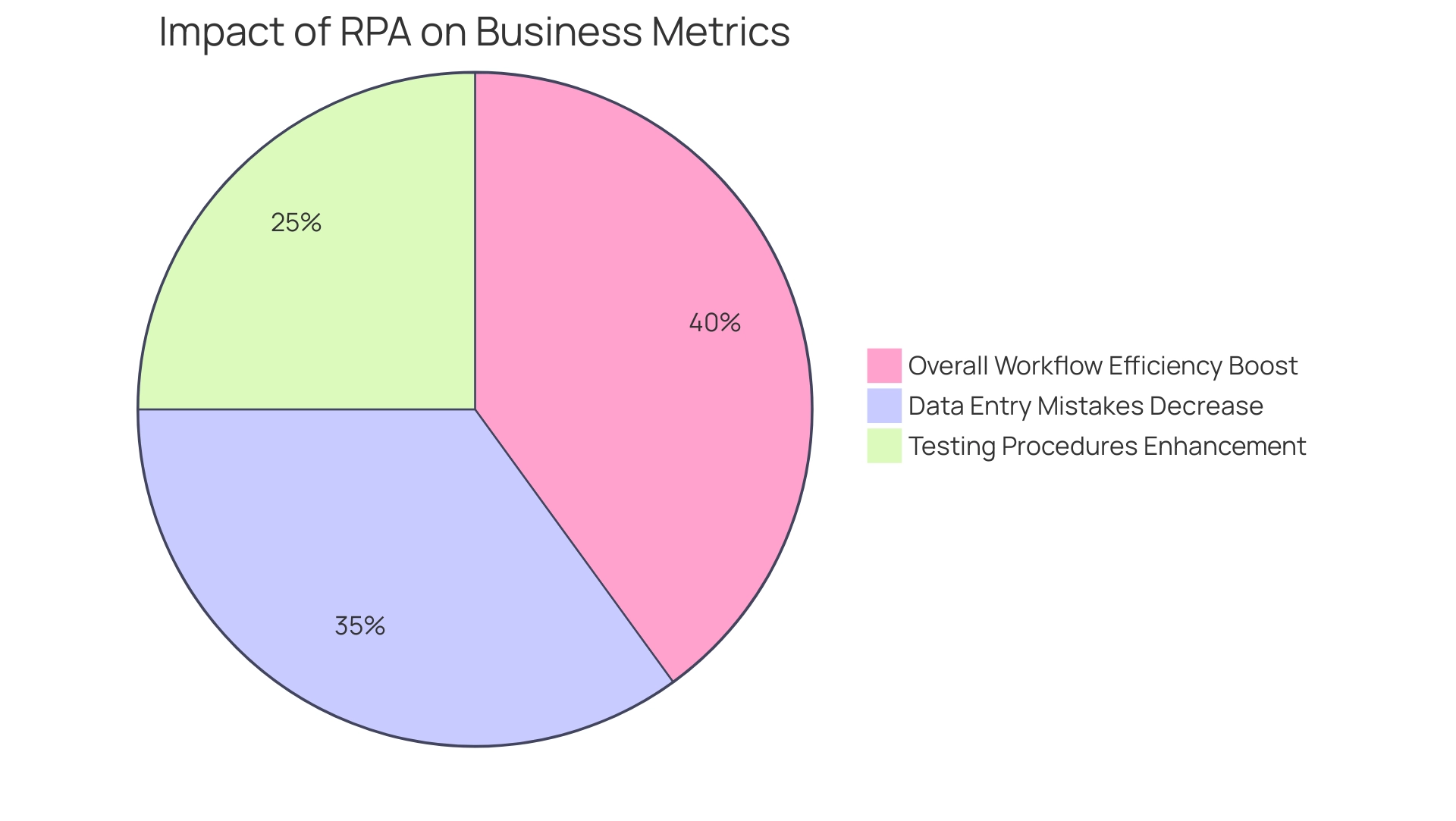
Key Responsibilities of an RPA Administrator
The successful implementation and ongoing management of robotic process automation (RPA) solutions within an organization is integral to the role of the RPA Administrator. Their role encompasses several critical responsibilities that drive efficiency and effectiveness in business operations:
-
Bot Development and Maintenance: RPA specialists are tasked with designing, testing, and maintaining software bots that automate key business processes.
This often involves collaboration with business analysts to clearly understand process requirements, ensuring that the developed bots, such as those powered by EMMA RPA, operate effectively and meet organizational needs. -
Monitoring and Troubleshooting: A crucial aspect of their role is the continuous monitoring of automated processes. RPA managers proactively identify issues or bottlenecks that may disrupt operations.
In the event of problems, they troubleshoot and resolve these issues promptly, minimizing downtime and ensuring seamless operational continuity, ultimately enhancing productivity and morale. -
User Management: Managing user access and permissions within the RPA system is another essential responsibility. RPA managers ensure that only authorized personnel can interact with or modify the bots, thereby upholding security and compliance standards essential to the robotic process framework.
-
Documentation and Reporting: Comprehensive documentation of processes, bot configurations, and any modifications is vital for transparency and knowledge transfer within the organization. RPA managers also produce comprehensive reports on bot performance and operational metrics, offering stakeholders insights into the efficiency and influence of mechanization initiatives, including the seamless digitalization provided by tools like Microsoft Power Automate. RPA Administrators play a key role in fostering a culture of continuous improvement.
By examining performance data and collecting user feedback, they recognize opportunities for additional mechanization and process enhancement. This proactive approach allows them to recommend enhancements to existing bots or develop new solutions that contribute to increased operational efficiency and help combat staffing shortages and outdated systems.
In terms of financial context, the average salary for an intern RPA developer in Florida is $35,587 annually, while entry-level RPA developers in New Brunswick can expect an average salary of $70,746. Notably, Hawaii offers an average annual salary of $104,172 for entry-level RPA developers, illustrating significant regional salary differences and highlighting the value of RPA roles across various locations. This discrepancy underscores the importance of investing in RPA solutions, as they not only enhance operational efficiency but also contribute to the retention of skilled employees by alleviating repetitive tasks and improving job satisfaction.
The multifaceted role of the RPA Administrator is crucial in ensuring the success of robotic process initiatives, positioning them as key players in driving an organization’s operational excellence and adaptability in an increasingly automated environment.
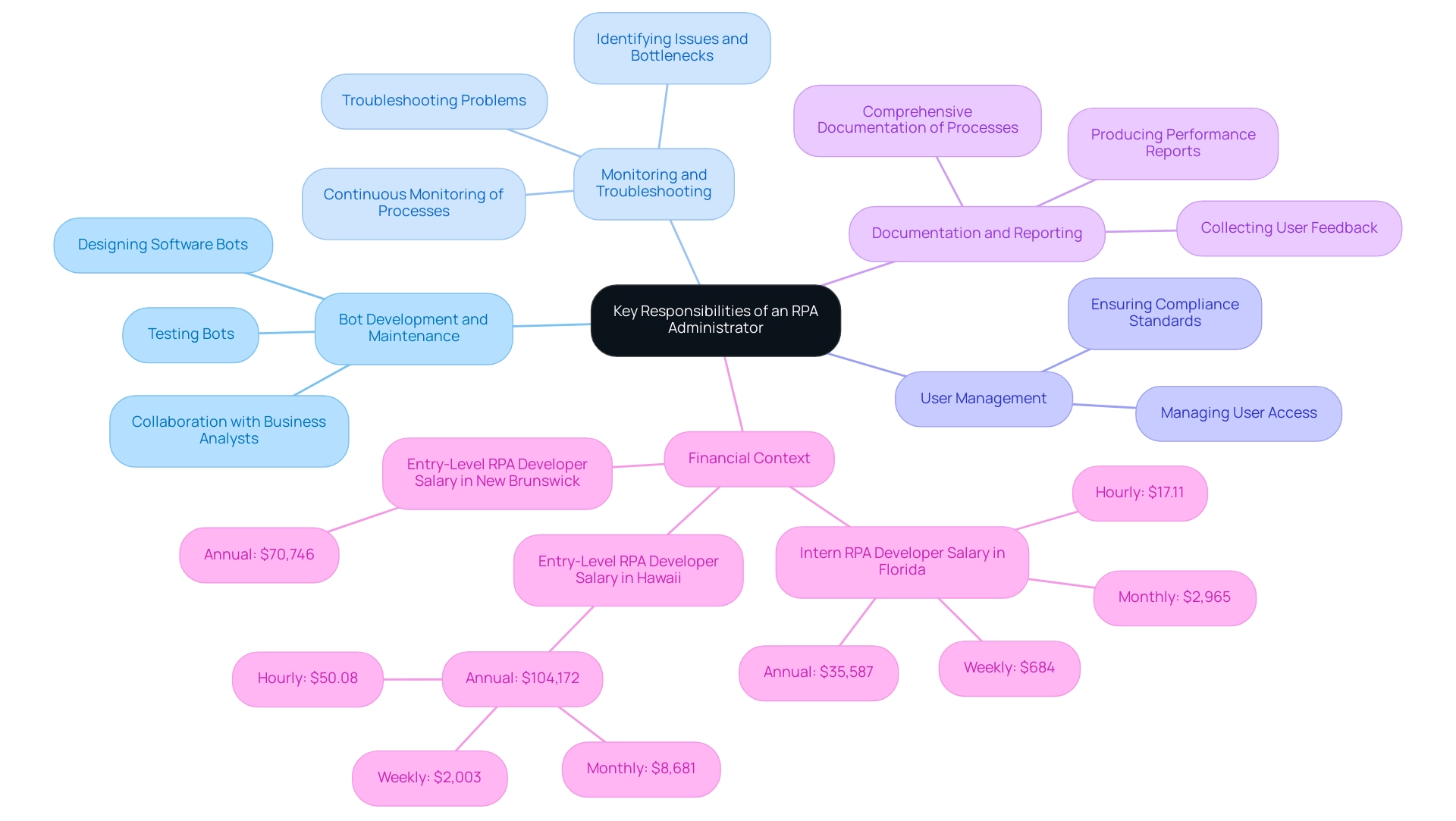
Skills Required for an RPA Administrator
To excel as an RPA Administrator, it is imperative to possess a blend of technical and soft skills, particularly in a landscape where Robotic Process Automation (RPA) is essential for enhancing operational efficiency. Key competencies include:
-
Technical Proficiency: A comprehensive understanding of RPA tools such as UiPath, Automation Anywhere, and Blue Prism is fundamental.
Additionally, knowledge of programming languages like Python or Java can significantly enhance bot development capabilities, aligning with the rapid advancements in the AI landscape. -
Analytical Skills: Exceptional analytical abilities are crucial for RPA managers to assess existing processes and discover opportunities for efficiency. This entails a thorough assessment of current workflows to determine the feasibility of proposed automation solutions, thereby unlocking the potential for enhanced productivity and informed decision-making through Business Intelligence.
-
Problem-Solving Abilities: RPA professionals must possess strong problem-solving skills to address issues effectively and devise viable solutions. Being proactive in identifying potential challenges before they escalate ensures timely corrective actions are implemented, thus overcoming common technology implementation challenges.
-
Communication Skills: Effective communication is essential for RPA managers to collaborate with a variety of stakeholders, including business analysts, IT teams, and end-users. The ability to translate complex technical information into understandable terms for non-technical audiences is vital for successful project outcomes, particularly when implementing tailored AI solutions.
-
Project Management: Understanding project management methodologies empowers RPA professionals to supervise various robotic process initiatives effectively, ensuring projects are completed punctually and adhere to quality standards.
These skills are essential for an RPA administrator to skillfully manage the intricacies of robotic processes, enabling them to achieve successful outcomes within their companies. With UiPath recently raising $750 million to enhance its RPA platform, the financial backing and growth potential of RPA technologies are evident. Additionally, small and medium-sized enterprises (SMEs) are projected to adopt RPA solutions at a growth rate of 25% annually, further emphasizing the increasing demand for skilled RPA professionals.
As the global RPA market is expected to grow at a CAGR of 27.7% from 2023 to 2028, the importance of these skills cannot be overstated. As Debasis Nayak suggests, ‘Don’t just stop at RPA—broaden your skill set. Explore new technologies and keep pace with the changing landscape.’
Embracing this mindset not only fosters relevance but also opens pathways to new opportunities in a rapidly evolving market.
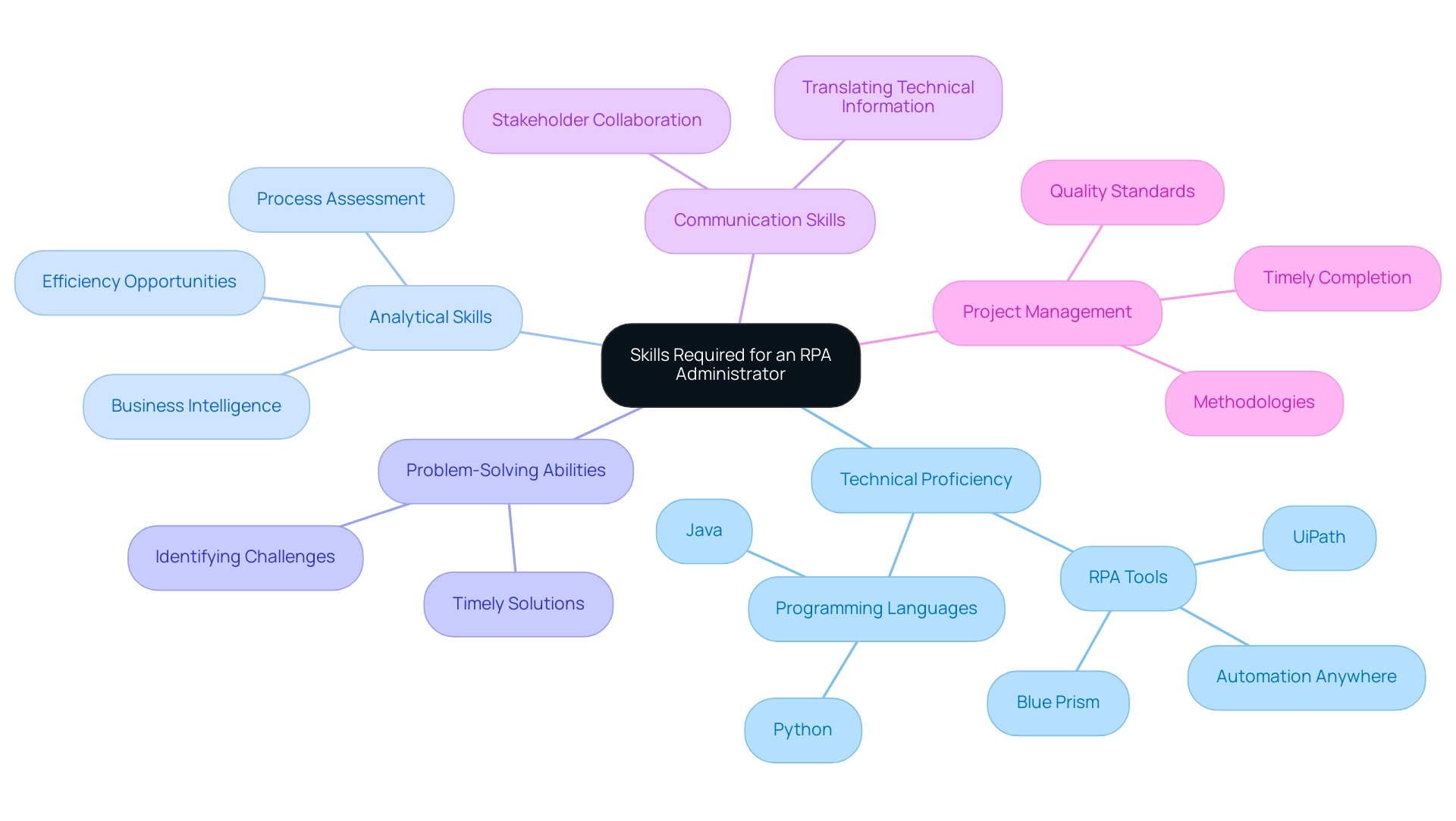
The Importance of an RPA Administrator in Organizations
RPA managers play a vital role in allowing organizations to fully utilize the transformative advantages of robotic process technology. Their specialized knowledge is pivotal for seamless implementation of automation solutions and for amplifying the overall effectiveness of these initiatives. The global RPA market is projected to grow at a CAGR of 27.7% from 2023 to 2028, with small and medium-sized enterprises (SMEs) expected to adopt RPA solutions at a growth rate of 25% annually.
This growth highlights the rising significance and demand for RPA Professionals in the industry.
Here are key reasons that illustrate the indispensable nature of RPA Professionals:
- Maximizing Efficiency: RPA Managers supervise bot performance and continuously identify areas for improvement, ensuring that businesses achieve peak efficiency in their automated processes.
- Mitigating Operational Risks: By monitoring operations in real-time and addressing issues proactively, the role of RPA Administrators is crucial in minimizing risks associated with automated processes, allowing them to run uninterrupted and smoothly.
- Fostering Innovation: These professionals are instrumental in cultivating a culture of innovation within organizations. They recognize new process improvement opportunities and promote the exploration of customized AI solutions and advanced technologies, driving continuous enhancement aligned with strategic objectives.
- Boosting Employee Satisfaction: By automating manual, repetitive tasks, RPA managers free employees to concentrate on strategic, value-added activities. This shift leads to enhanced job satisfaction and greater engagement among the workforce, ultimately contributing to business productivity.
- Aligning with Strategic Objectives: RPA managers ensure that robotic process initiatives are closely aligned with organizational goals. This alignment is crucial for driving growth and contributing to broader business success, particularly in today’s data-rich environment where informed decision-making is essential for competitive advantage.
- Utilizing Business Intelligence: RPA Managers also play a crucial part in combining Business Intelligence tools with automated processes, allowing entities to derive actionable insights from data. This capability is essential for making informed decisions that drive growth and innovation.
- Navigating AI Challenges: In the rapidly evolving AI landscape, RPA Managers assist entities in tackling challenges by deploying customized AI solutions that satisfy specific business requirements, ensuring that automation remains effective and pertinent.
The importance of RPA Managers cannot be overstated; they are essential resources in any entity aiming to utilize automation for operational excellence and sustainable growth in an increasingly automated world. With 90% of invoices not attached to purchase orders processed manually, the potential for automation—and the pivotal role of RPA Administrators in this transformation—becomes evident. Tajammul Pangarkar, CMO at Prudour Pvt Ltd, emphasizes that firms must adapt to these changes to stay competitive.
Their expertise not only streamlines processes but also positions organizations for success in a rapidly evolving AI landscape.
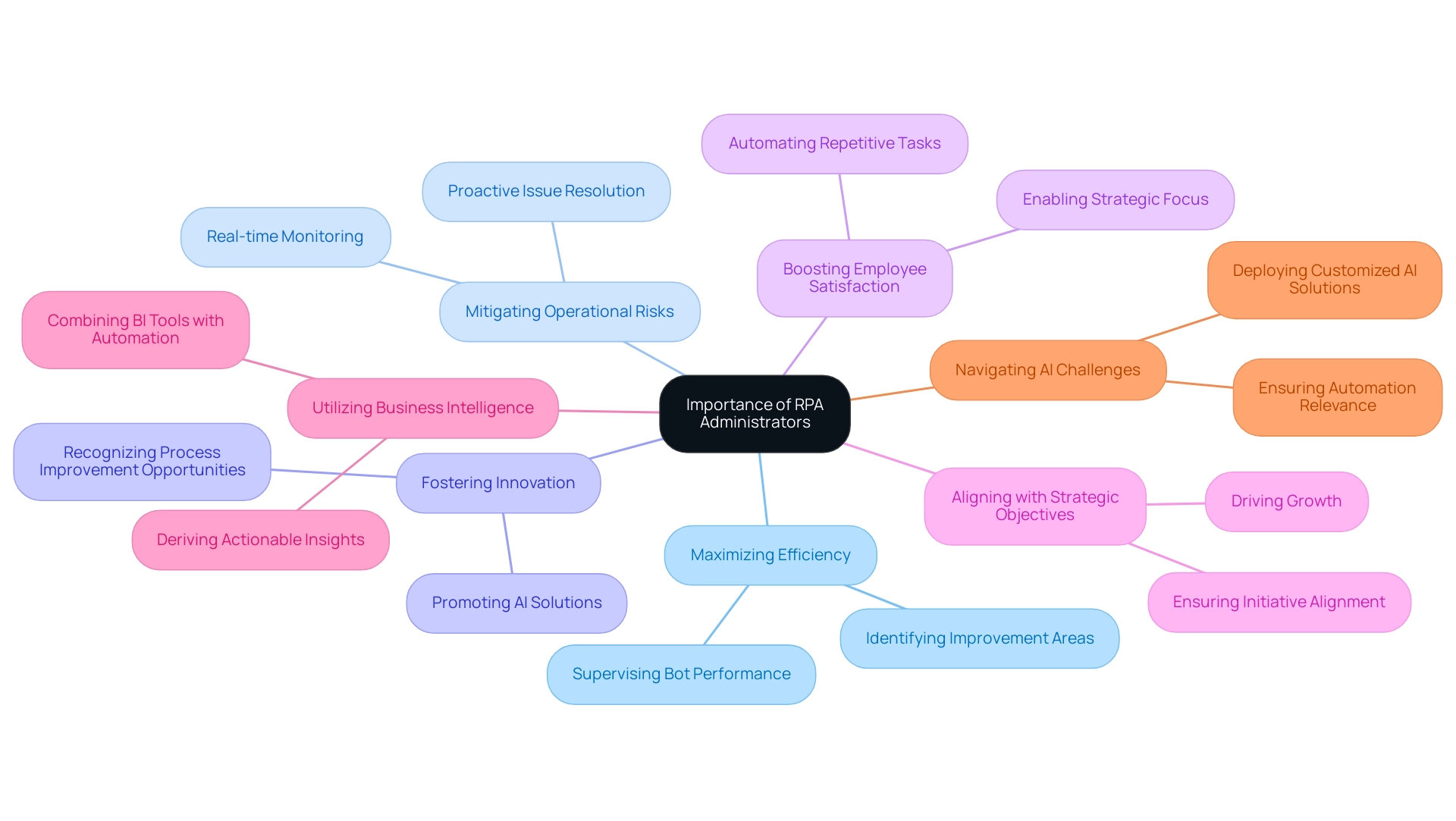
Future Trends in RPA and the Role of the RPA Administrator
As robotic process innovation (RPA) continues to advance, several transformative trends are shaping its future and redefining the role of RPA managers:
- Integration with Artificial Intelligence: The convergence of RPA and artificial intelligence is set to significantly enhance operational capabilities. This integration empowers the RPA Administrator to implement intelligent automated solutions that not only handle repetitive tasks but also learn and adapt over time, thereby driving greater efficiency and effectiveness in operations. Significantly, 83% of employees utilizing AI-driven technology believe that it can help alleviate burnout and improve job satisfaction, highlighting the crucial significance of this integration (UiPath 2023 Automation Generation Report).
- Increased Focus on Security: With the rising adoption of RPA across industries, organizations are placing heightened importance on security and compliance. RPA Managers must stay alert and informed about best practices for securing automated processes and protecting sensitive information, ensuring that these initiatives do not undermine organizational integrity.
- Expansion of RPA Use Cases: As businesses increasingly recognize the substantial value that RPA brings, the spectrum of use cases is broadening beyond traditional applications. RPA managers are encouraged to investigate innovative fields for mechanization, creating customized solutions that meet changing business requirements and challenges. This expansion not only enhances operational efficiency but also contributes to cost reduction and productivity gains.
- Collaboration with IT and Business Units: The role of RPA managers is evolving to encompass greater collaboration with IT departments and diverse business units. This cooperative approach ensures that mechanization strategies are not only aligned with organizational goals but also seamlessly integrated into the existing technology infrastructure, promoting a holistic view of mechanization that frees up teams for more strategic, value-adding work.
- Continuous Learning and Adaptation: In the face of rapid technological advancements, RPA professionals must commit to continuous learning and professional development. Adapting their skills and knowledge to meet the demands of the evolving automation landscape is vital for leveraging the full potential of RPA technologies, including the transformation of raw data into actionable insights that drive informed decision-making.
In summary, the role of the RPA administrator is positioned at the forefront of navigating the future of automation. By embracing these trends, including the integration of generative AI as outlined in the case study ‘Trends in RPA for 2024,’ they can ensure that their organizations fully harness the capabilities of RPA while adeptly responding to emerging challenges and opportunities.
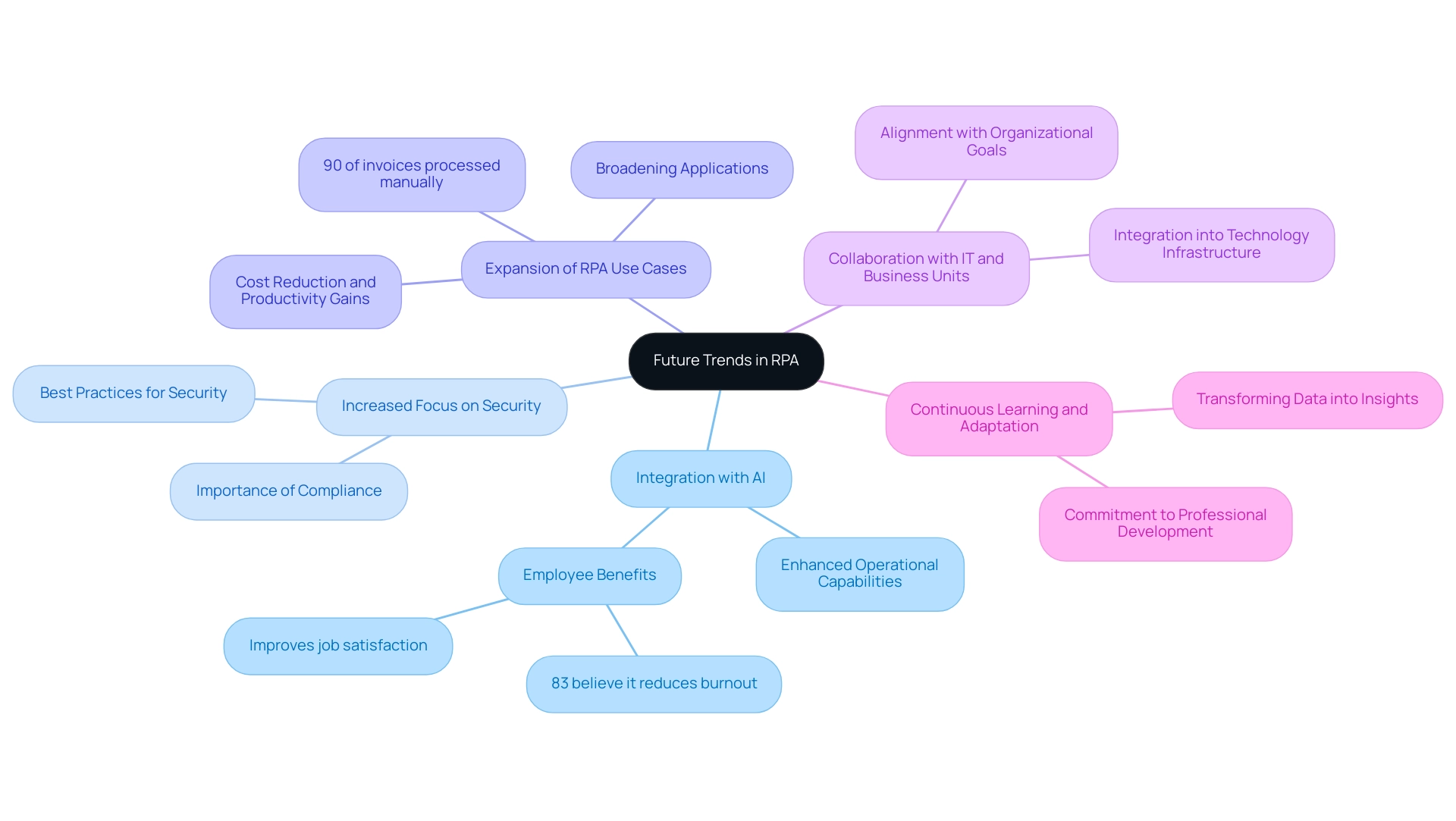
Conclusion
Embracing Robotic Process Automation (RPA) is not just a trend; it is a transformative strategy that empowers organizations to enhance operational efficiency and drive innovation. The role of the RPA Administrator is central to this journey, as they are responsible for the design, implementation, and management of automation solutions that streamline processes and improve productivity. With a focus on continuous improvement and the ability to mitigate operational risks, RPA Administrators are key players in maximizing the benefits of automation.
The multifaceted skill set required for RPA Administrators—including technical proficiency, analytical capabilities, problem-solving skills, and effective communication—underscores their importance in today’s rapidly evolving digital landscape. As organizations increasingly adopt RPA technologies, the demand for skilled RPA Administrators continues to grow, highlighting the critical need for these professionals to navigate the complexities of automation and align initiatives with strategic objectives.
Looking ahead, the integration of artificial intelligence with RPA signals a new era of intelligent automation. RPA Administrators will play a pivotal role in leveraging these advancements to enhance operational capabilities, drive employee satisfaction, and foster innovation. By staying abreast of emerging trends and committing to continuous learning, RPA Administrators will ensure their organizations not only keep pace with technological advancements but also position themselves for sustained growth and competitive advantage in an increasingly automated world. The future of work is here, and RPA Administrators are at the forefront, ready to unlock the full potential of automation for their organizations.
Introduction
In the rapidly evolving landscape of healthcare, organizations are increasingly turning to Robotic Process Automation (RPA) as a transformative solution to streamline operations and enhance patient care. By automating repetitive tasks, RPA not only alleviates the burden on human resources but also significantly improves accuracy and efficiency across various processes, particularly in revenue cycle management.
As healthcare providers face mounting pressure to optimize workflows and reduce costs, understanding the multifaceted benefits of RPA becomes essential. This article delves into the various advantages, common challenges, and best practices for RPA implementation, while also exploring future trends that promise to further revolutionize the industry.
With a clear strategy and proactive approach, healthcare organizations can harness the full potential of RPA to drive meaningful improvements in operational performance and patient outcomes.
Understanding Robotic Process Automation (RPA) in Healthcare
Robotic Process Automation (RPA) is revolutionizing the healthcare landscape by employing software robots, or ‘bots’, to automate repetitive and routine tasks that have traditionally required human intervention. In particular, RPA in revenue cycle management proves invaluable by streamlining essential processes such as:
- Patient registration
- Billing
- Claims processing
This process not only saves time but also significantly reduces the manual effort involved, leading to enhanced operational efficiency and lower costs.
For example, a recent case study highlighted a mid-sized medical company that improved its efficiency by automating data entry and software testing, resulting in:
- A 70% reduction in data entry errors
- An 80% increase in workflow efficiency within six months
Furthermore, RPA’s role in minimizing human errors enhances accuracy, ensuring that financial transactions and patient information are handled with precision. As the medical field struggles with the reality that nearly 37% of organizations currently lack the technology necessary for efficient onboarding processes, this highlights an urgent need for RPA adoption to avoid falling behind.
Notably, a remarkable 80% of health systems plan to invest in digital medical solutions within the next five years, signaling a pivotal shift toward innovative operational strategies. As the industry continues to evolve, leveraging RPA in revenue cycle management’s full potential is essential for organizations striving to optimize their operations and enhance patient care outcomes. While concerns about data handling and AI risks persist—echoed in a statement from The Economist regarding banks—RPA’s benefits in streamlining operations and improving patient care far outweigh these challenges.
Furthermore, the case study ‘Economic Gains from AI and Automation‘ indicates that improvements propelled by AI could represent 45% of overall economic gains by 2030, reinforcing the economic justification for embracing RPA in healthcare. Additionally, integrating tailored AI solutions and business intelligence can further elevate operational efficiency, enabling informed decision-making that drives growth and innovation in this rapidly evolving landscape.
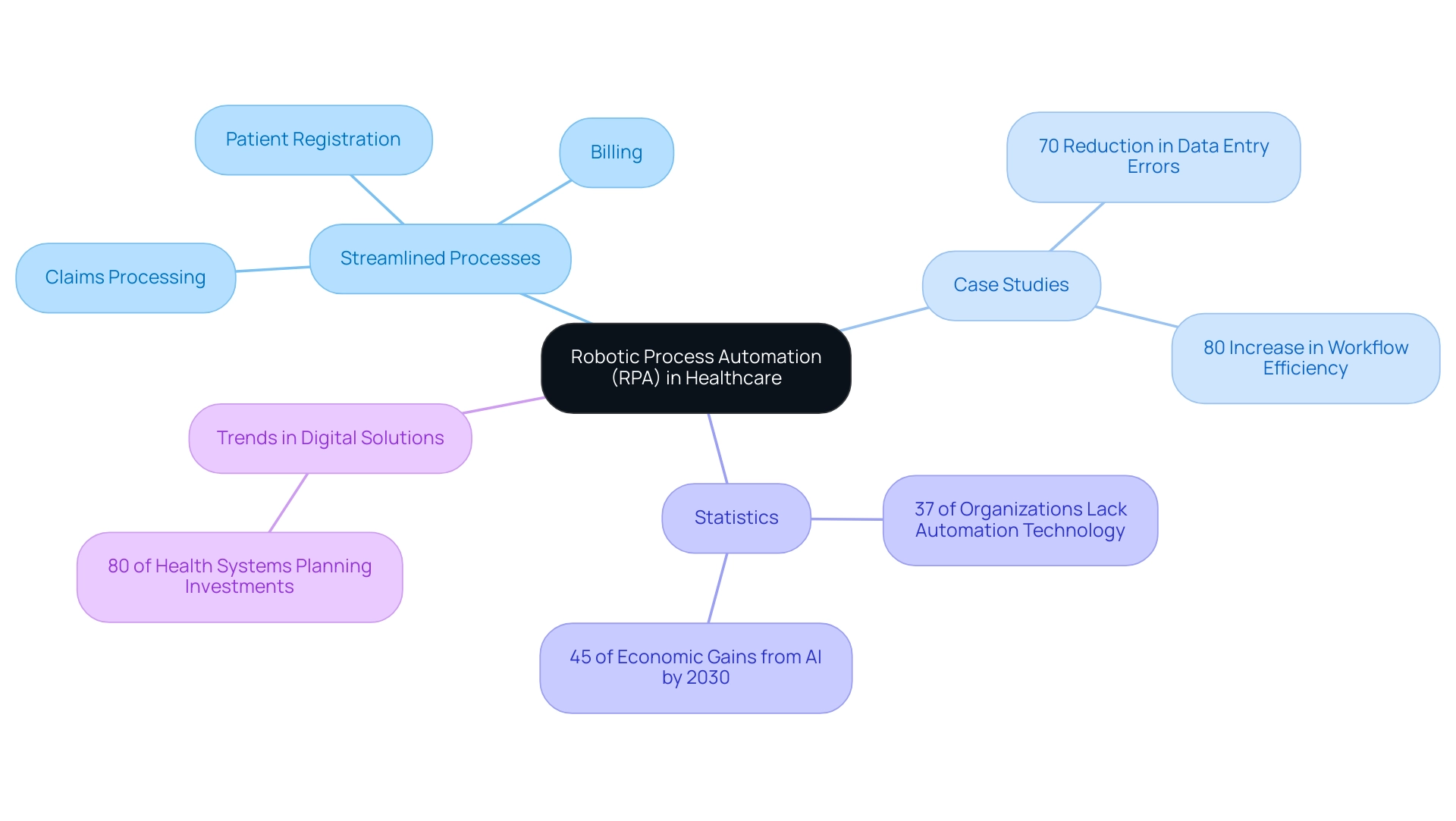
Transformative Benefits of RPA in Revenue Cycle Management
Implementing RPA in revenue cycle management unlocks a range of transformative benefits that can significantly enhance operational efficiency and patient care. As noted by Gartner, companies will leverage a combination of RPA, AI, machine learning, and other automation technologies to streamline operations, resulting in a projected 30% reduction in operational costs by 2024. Here are the key advantages:
-
Increased Efficiency: Automating routine tasks such as claims submission and payment posting dramatically speeds up these activities. With innovative tools like EMMA RPA and Microsoft Power Automate, healthcare providers can redirect their focus toward strategic activities that drive better outcomes. For instance, EMMA RPA can automate data entry from various sources, ensuring that claims are submitted accurately and on time, while Power Automate can connect disparate systems to facilitate seamless data flow.
-
Enhanced Accuracy: RPA minimizes human error in data entry and processing, leading to fewer claim denials and reduced need for rework. This improvement results in higher revenue collection rates and more reliable financial reporting, showcasing the power of tailored AI solutions in enhancing operational precision.
-
Cost Reduction: By automating manual processes, organizations can achieve substantial cost savings. This decrease in staffing requirements enables resources to be distributed more effectively, thereby improving overall operational efficiency and guaranteeing a risk-free ROI evaluation through professional execution of projects.
-
Improved Compliance: RPA helps organizations maintain strict adherence to regulatory standards by consistently executing predefined rules. This reduces the likelihood of compliance issues and associated penalties, with automation proving essential in navigating complex regulatory landscapes.
-
Better Patient Experience: With administrative tasks streamlined, medical providers can dedicate more time to patient care. This shift not only enhances patient satisfaction but fosters a more patient-centered approach to service delivery, transforming the overall experience for patients.
-
Scalability: RPA solutions are inherently scalable, enabling organizations to easily adjust to changing demands in the medical field. This adaptability is crucial in an industry characterized by rapid evolution and increasing complexity, allowing providers to remain agile and responsive.
-
Data Insights: RPA facilitates improved data collection and analysis, empowering organizations with actionable insights. These insights can inform strategic decision-making and enhance long-term planning, ensuring that providers are well-positioned for future challenges.
However, it is essential to acknowledge that RPA deployment can face challenges such as integration with existing systems and workforce skill management. Organizations may struggle with aligning their current workflows with RPA capabilities, which requires careful planning and training. By harnessing the advantages of RPA in revenue cycle management, particularly through EMMA RPA and Power Automate, organizations in the medical field can transform their processes, leading to superior operational performance and enhanced patient care.
As observed by industry specialists, the integration of RPA not only enhances accuracy and lowers costs but significantly affects claim denial rates, paving the way for a more efficient and effective system.

Common Challenges in RPA Implementation
While the advantages of Robotic Process Automation (RPA) are clear, healthcare organizations often encounter several challenges during its implementation:
-
Resistance to Change: Employee apprehension towards adopting new technologies can hinder progress, fueled by fears of job displacement or complexity. To counter this, fostering a culture of acceptance through comprehensive training programs and transparent communication is essential, emphasizing how RPA enhances roles rather than replaces them.
-
Integration Issues: The complexity of integrating RPA with existing systems poses significant challenges. Conducting thorough assessments of current infrastructure is crucial to ensure compatibility, which can lead to a productivity boost of up to 30% in IT support activities. Furthermore, RPA can streamline workflows, allowing for more efficient operations.
-
Data Security Concerns: Automating processes that handle sensitive patient information raises legitimate security concerns. Organizations must implement robust data protection measures and adhere to compliance protocols to mitigate these risks while maintaining patient trust.
-
Lack of Clear Objectives: RPA initiatives can struggle without well-defined goals. Establishing clear objectives and success metrics is vital to effectively steer RPA projects and measure their impact.
-
Resource Allocation: Inadequate budget or skilled personnel can hinder RPA efforts significantly. Ensuring sufficient resource allocation and ongoing training for staff is essential for the success of technology projects.
By proactively recognizing and addressing these challenges, healthcare organizations can pave the way for successful RPA implementations that maximize benefits and minimize risks. Additionally, as emphasized in the case study titled ‘Job Market Impact of RPA,’ the employment outlook in the RPA sector seems favorable, with expectations for job openings associated with technology advancements. RPA not only enhances compliance and reporting by removing human mistakes in 50% of instances but also improves data management and decision-making abilities, demonstrating the transformative potential of mechanization when carried out carefully.
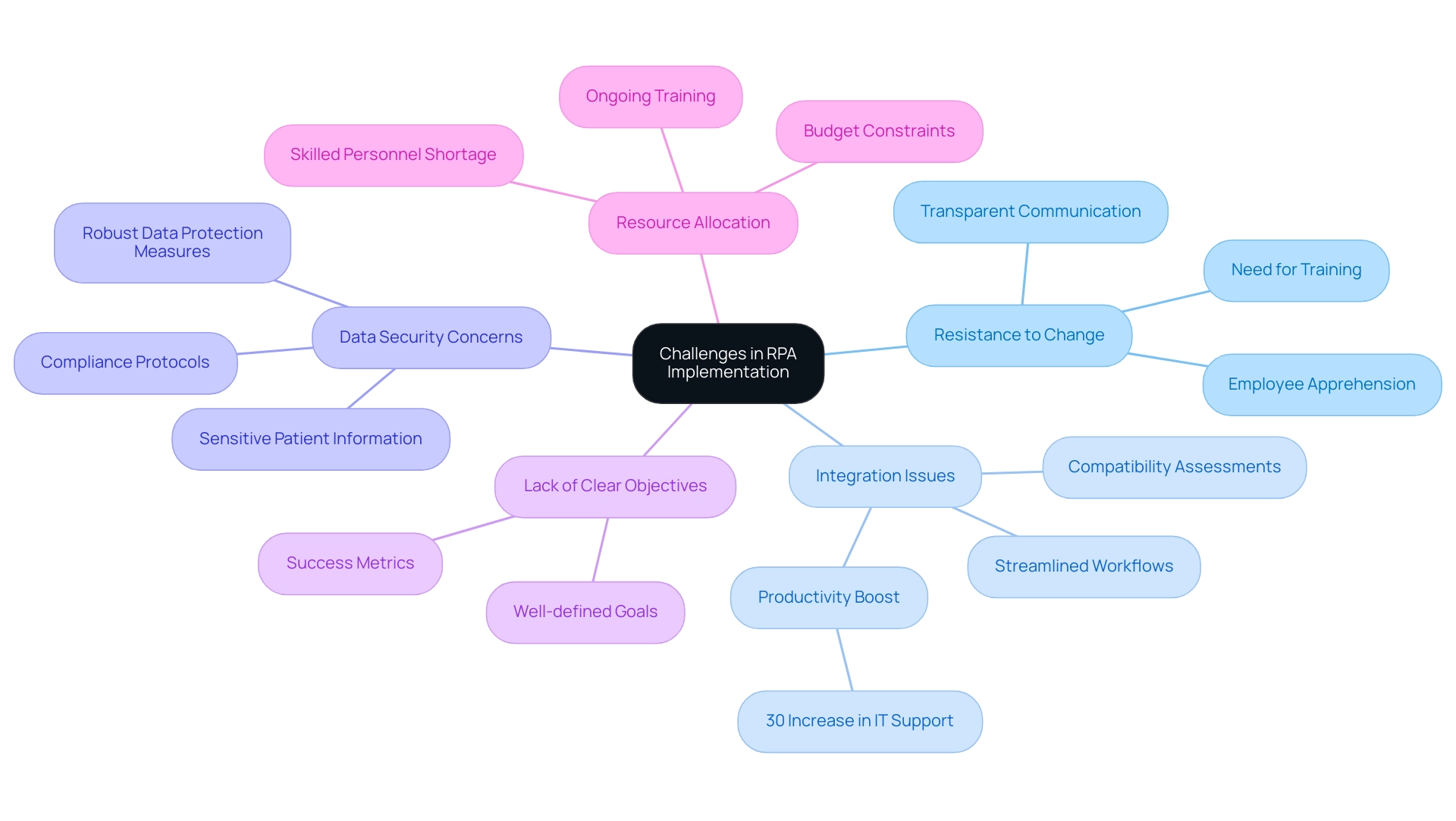
Best Practices for Successful RPA Implementation
To achieve successful RPA implementation in revenue cycle management, organizations should adhere to the following best practices:
-
Define Clear Objectives: Establish specific goals for RPA initiatives, such as reducing processing times or enhancing accuracy. Clarity in objectives ensures that efforts are aligned with organizational goals, ultimately leading to a risk-free ROI as demonstrated in our successful GUI automation case studies.
-
Engage Stakeholders Early: Involve key stakeholders from the very beginning to gain valuable insights and foster robust support for the initiative. Engaged stakeholders are critical to navigating the complexities of RPA projects and overcoming technology implementation challenges.
-
Choose the Right Procedures: Focus on automating tasks that are repetitive, rule-based, and high-volume. These methods often yield the highest return on investment when automated, as evidenced by our clients who reduced data entry errors by 70% and accelerated testing activities by 50% through RPA.
-
Invest in Training and Change Management: Equip employees with the skills necessary to collaborate effectively with RPA technologies. Addressing any concerns upfront fosters a smoother transition and enhances overall acceptance of the new systems, contributing to improved operational efficiency.
-
Monitor and Optimize: After implementation, it’s crucial to consistently observe RPA performance metrics, including the Downtime Rate, which indicates the percentage of time a bot could execute a task but is not due to errors or maintenance. Understanding this metric is crucial for identifying potential inefficiencies. Making necessary adjustments can significantly improve efficiency and effectiveness, aligning with the goal of enhancing business productivity.
-
Scalability Planning: Design RPA solutions with future growth in mind, ensuring they can adapt to changing operational needs and scale accordingly. A well-planned scalable RPA implementation can support long-term efficiency gains.
-
Establish Governance Framework: Develop a governance framework to oversee RPA initiatives, ensuring compliance with industry regulations and alignment with overarching organizational goals. This framework is essential for preserving the integrity of automated efforts and maximizing their impact.
By applying these best practices, healthcare organizations can harness the full potential of RPA in revenue cycle management to drive significant improvements. Notably, the cost-effectiveness of RPA solutions is underscored by the potential payroll savings of around 30% FTE for recruitment and onboarding of human processors. Furthermore, as part of our service commitment, ‘You only pay if we deliver what was promised,’ we evaluate your systems, calculate the efforts needed, estimate time savings, and ultimately ensure that the implementation is carried out by certified professionals.
Furthermore, the case study on the reusability of code indicates that higher reusability can lead to faster development times and reduced costs for new initiatives. According to Bart Teodorczuk, RPA Tech Lead at Flobotics, ‘Our team, drawn exclusively from the ‘Big Four’ of accounting, will evaluate your operations and current RPA configuration and suggest the metrics and KPIs that are most appropriate for your business objectives and requirements.’ This tailored approach is crucial for maximizing RPA’s impact on operational efficiency.

Future Trends in RPA and Healthcare
As robotic process automation (RPA) technology continues to advance, several key trends are poised to redefine its application in various industries, particularly healthcare:
-
AI Integration: The convergence of artificial intelligence with RPA is set to significantly enhance operational capabilities. This integration will enable bots to handle more intricate tasks that involve decision-making and adaptive learning, enhancing workflows across operations.
-
Hyperautomation: Organizations are increasingly leaning towards hyperautomation, which synergizes RPA with advanced technologies such as AI, machine learning, and analytics. This comprehensive method facilitates the mechanization of end-to-end processes using RPA in revenue cycle management, driving operational efficiency and productivity.
-
Cloud-Based RPA Solutions: The migration to cloud-based RPA solutions offers organizations improved flexibility, scalability, and cost-effectiveness, allowing for dynamic responses to changing operational needs.
-
Focus on Patient-Centric Automation: Future RPA initiatives will prioritize experiences that directly affect interactions and service delivery, ultimately leading to enhanced satisfaction and outcomes. As Amardeep Rawat, Co-Founder and Director, notes, “In the OR, a surgeon sees not only the patient but also real-time data overlays, providing guidance and insights as they operate.”
-
Enhanced Data Security Measures: In light of increasing data security concerns, RPA solutions will evolve to incorporate sophisticated security protocols, ensuring the protection of sensitive information.
-
Increased Collaboration Between Humans and Bots: The future landscape will feature a more integrated work environment where humans and bots collaborate seamlessly, fostering productivity and operational efficiency.
-
Benefits of RPA: RPA is not only about automation; it significantly boosts efficiency, reduces errors, and frees up teams for more strategic, value-adding work. By utilizing RPA in revenue cycle management, organizations can automate manual workflows and redirect their resources towards innovation and growth.
-
Challenges of Implementation: While the benefits are clear, organizations must also navigate challenges in technology implementation, including change management and integration with existing systems. Tailored AI solutions and Business Intelligence can play a crucial role in addressing these challenges, enhancing the effectiveness of RPA initiatives.
By remaining attuned to these trends and recognizing both the benefits and challenges of RPA in revenue cycle management, organizations can strategically position themselves to harness these technologies for enhanced operational performance and improved service delivery. Notably, the RPA market in regions such as Saudi Arabia is anticipated to grow significantly from 2023 to 2030, driven by the IoT revolution, indicating a broader relevance of RPA technology in various markets.
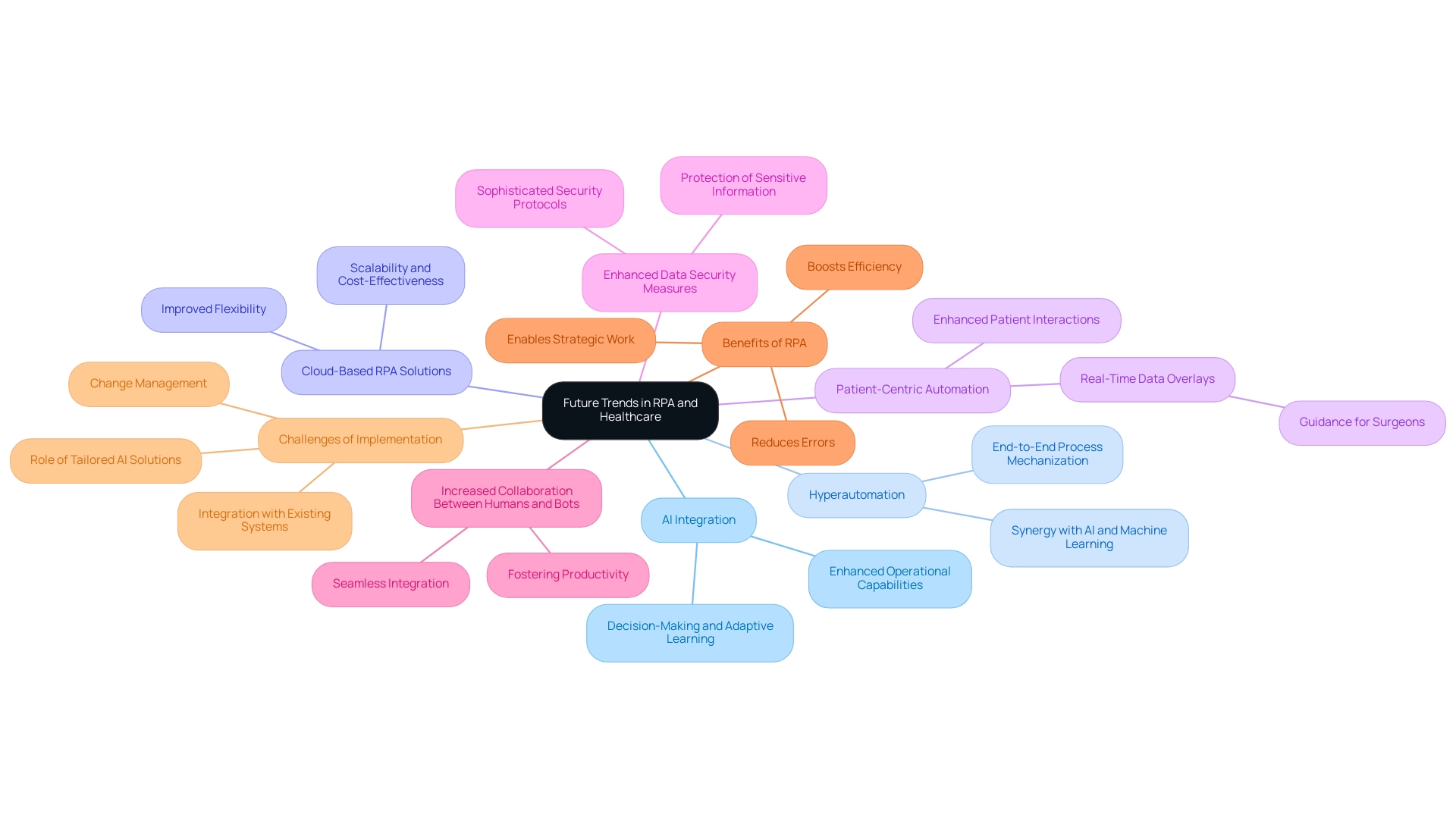
Conclusion
Implementing Robotic Process Automation (RPA) in healthcare is not just a trend but a necessity for organizations looking to optimize their operations and enhance patient care. The multifaceted benefits of RPA, particularly in revenue cycle management, are evident through increased efficiency, enhanced accuracy, and substantial cost reductions. By automating repetitive tasks, healthcare providers can focus on delivering quality patient care while minimizing errors and compliance risks.
However, the path to successful RPA implementation is not without its challenges. Addressing resistance to change, integration issues, and data security concerns are crucial for organizations to fully leverage the transformative potential of RPA. By adopting best practices such as:
– Defining clear objectives
– Investing in training
Healthcare organizations can navigate these hurdles effectively.
Looking ahead, the integration of AI, the rise of hyperautomation, and a focus on patient-centric automation are set to redefine the landscape of healthcare operations. Organizations that remain proactive in adopting these innovations will not only improve operational performance but also enhance the overall patient experience. Embracing RPA is an empowering step toward a more efficient and effective healthcare system, positioning organizations for future success in an increasingly competitive environment.
Introduction
In the rapidly evolving landscape of business operations, organizations are increasingly turning to Robotic Process Automation (RPA) as a powerful tool to enhance efficiency and drive growth. By automating repetitive tasks, RPA not only liberates employees from mundane duties but also integrates seamlessly with existing systems, paving the way for smoother workflows.
As companies strive to stay competitive, understanding the key concepts and functionalities of RPA becomes essential. This article delves into the transformative potential of RPA, exploring its applications across various sectors, the challenges organizations may face during implementation, and practical strategies for building a scalable RPA framework.
With a focus on continuous improvement and innovation, businesses can harness RPA to unlock new levels of productivity and operational excellence.
Understanding Robotic Process Automation (RPA): Key Concepts and Functionality
Robotic Process Automation (RPA) is a groundbreaking technology that allows entities to set up software, or ‘robots’, to mimic human actions within digital systems, thereby carrying out business workflows efficiently. Understanding the core concepts of RPA strategy is essential for crafting a strategic approach that aligns with your organizational goals:
-
Automation of Repetitive Tasks: A primary advantage of RPA is its ability to automate mundane tasks such as data entry, processing transactions, and managing records. This liberation from time-consuming duties not only minimizes errors but significantly enhances productivity, allowing your team to focus on more strategic initiatives.
-
Integration with Existing Systems: RPA tools like EMMA RPA and Microsoft Power Automate seamlessly operate across various applications and systems without necessitating extensive coding or modifications, facilitating smoother workflows and quicker implementations. This is crucial for overcoming the challenges posed by outdated systems and ensuring that your entity remains agile and innovative.
-
User Interface Interaction: RPA robots are designed to mimic user actions, allowing them to interact with applications just as a human would. This capability ensures a seamless workflow, preserving the integrity of existing methods while optimizing efficiency.
-
Overcoming Technology Implementation Challenges: Implementing RPA can address common challenges such as resistance to change and integration with legacy systems. By offering targeted training and support, companies can ensure a smoother transition and better acceptance among employees.
-
ROI and Risk Management: Investing in RPA solutions not only leads to significant cost savings through enhanced efficiency but also mitigates risks associated with manual errors. By calculating potential time savings and enhancements, companies can better understand the ROI of their RPA initiatives. Furthermore, small and medium-sized enterprises (SMEs) are projected to adopt RPA solutions at a growth rate of 25% annually, underscoring the increasing relevance of this technology in the sector. For instance, integrating RPA into appointment scheduling can lower no-show rates, which vary between 5% and 39%, demonstrating a tangible benefit of automation. Additionally, BPO companies in sales and marketing utilize RPA for lead generation and campaign management, enabling teams to concentrate on customer engagement and ultimately leading to higher conversion rates. Grasping these key concepts is imperative for developing a robust RPA strategy that addresses immediate operational needs while positioning your organization for future growth.

Leveraging RPA: Use Cases and Benefits for Effective Strategy Development
RPA can be utilized across diverse sectors and workflows. Some notable use cases include:
- Finance and Accounting: Automating invoice handling and reconciliation tasks to minimize human error and expedite workflows.
- Customer Service: Implementing chatbots and automated responses to manage common inquiries, allowing human agents to focus on complex issues.
- Human Resources: Streamlining employee onboarding activities by automating document collection and verification.
In particular, a recent case study highlights how a mid-sized healthcare company tackled challenges such as manual data entry errors, slow software testing, and the difficulty of integrating outdated systems without APIs by implementing GUI automation. This solution, as part of our RPA strategy, resulted in a remarkable 70% reduction in data entry errors, a 50% acceleration in testing processes, and improved workflow efficiency by 80%, achieving a return on investment within just 6 months. The benefits of adopting RPA, in line with our RPA strategy, include:
- Increased operational efficiency and productivity.
- Reduced costs associated with manual processes.
- Enhanced accuracy and compliance in data handling.
- Greater employee satisfaction as teams can focus on more strategic tasks.
By leveraging tailored AI solutions alongside an RPA strategy, entities can unlock the full potential of their data and drive informed decision-making, further enhancing productivity in a rapidly evolving landscape.
The transformative impact of GUI automation on healthcare service delivery is evident, showcasing how technology can revolutionize operations and improve service quality.
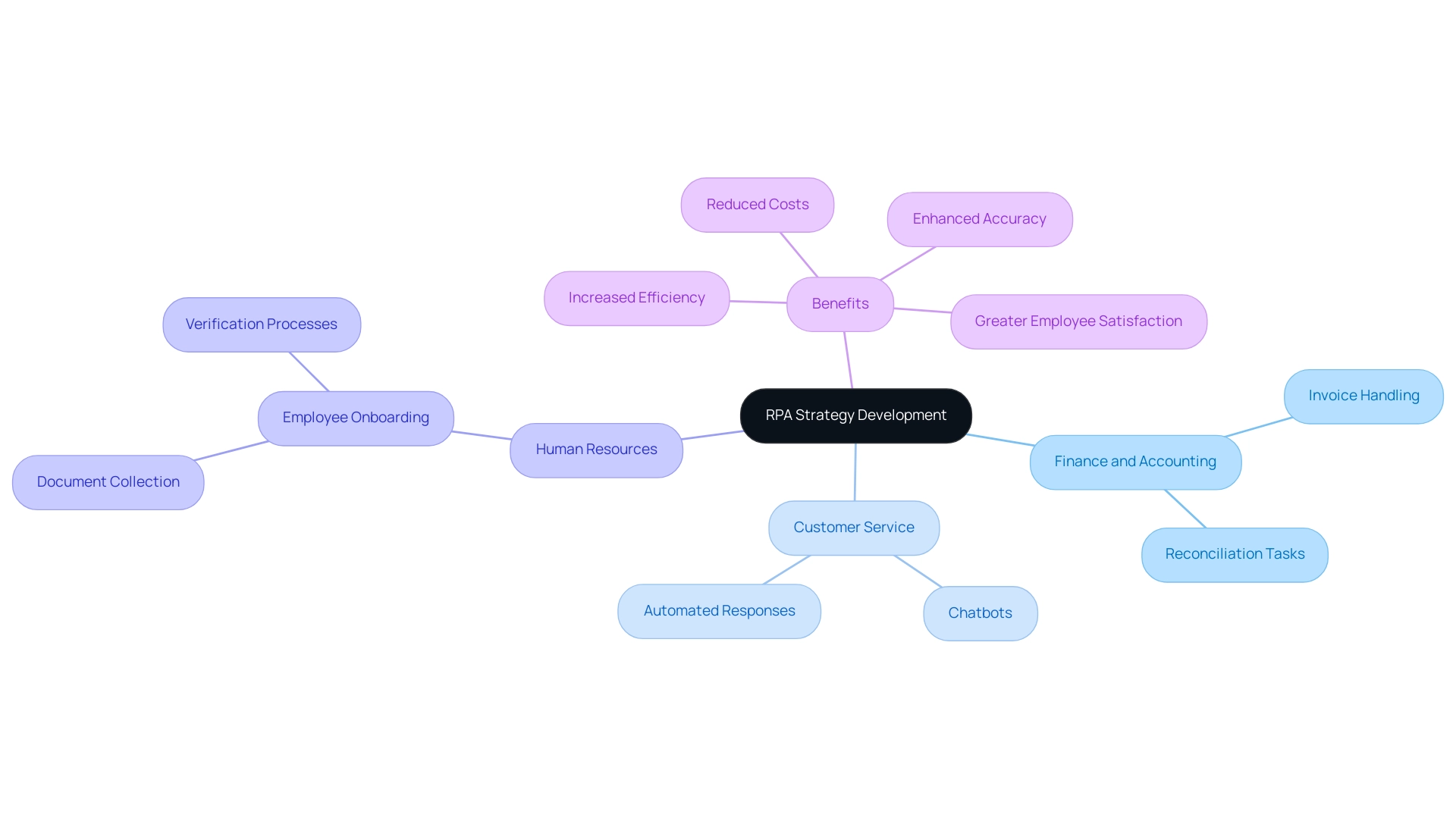
Navigating Challenges in RPA Implementation: Strategies for Success
While the advantages of an RPA strategy are substantial, organizations often encounter hurdles during implementation that can impede progress. For instance, a direct-to-consumer retailer is grappling with operational efficiency due to outdated automation systems, highlighting a common challenge in the industry. Key challenges include:
-
Resistance to Change: Employees may exhibit reluctance towards adopting new technologies.
To combat this, it is essential to effectively communicate the benefits of the RPA strategy and actively involve staff in the transition, fostering a sense of ownership and understanding. -
Integration Issues: Ensuring RPA tools integrate seamlessly with existing systems is vital. To mitigate this risk, conduct thorough testing of the selected RPA solutions and prioritize tools known for their integration capabilities.
-
Lack of Clear Objectives: Without well-defined goals, RPA initiatives can stall. Establishing clear Key Performance Indicators (KPIs) and objectives is essential to guide the implementation activities of the RPA strategy and measure its success.
To enhance the likelihood of successful RPA integration and operational efficiency, consider the following approaches:
- Engage stakeholders from the outset to cultivate buy-in and support across the organization.
- Provide comprehensive training programs that equip staff with the skills necessary to work alongside RPA technologies effectively.
- Regularly review and adjust implementation techniques based on feedback and performance metrics to ensure continuous improvement and alignment with organizational goals.
A case study titled ‘Robotic Process Automation Approach for D2C Retail in Competitive Market’ illustrates how a direct-to-consumer retailer improved customer experience and reduced operational costs through an effective RPA strategy. This underscores the potential benefits of overcoming implementation challenges and highlights the importance of an RPA strategy in driving efficiency in today’s rapidly evolving AI landscape. Moreover, by implementing an RPA strategy to automate repetitive tasks, it alleviates the burden on employees, leading to improved morale and productivity. Furthermore, combining Business Intelligence with RPA can improve decision-making activities, allowing organizations to utilize data-driven insights for growth and innovation.

Starting Small: Building a Scalable RPA Strategy
To develop a scalable RPA strategy that effectively addresses workplace challenges and enhances productivity, follow these essential steps.
- Identify Quick Wins:
Start by targeting activities characterized by high volume, repetition, and clear rules. For example, automating data entry tasks within your finance department can lead to immediate and significant benefits, streamlining operations and freeing up valuable resources.
Organizations implementing RPA have reported time savings of up to 30% in these tasks, significantly improving employee morale and productivity. Additionally, by alleviating repetitive workloads, RPA can help attract and retain talent, as employees are more likely to stay in roles that allow them to focus on strategic tasks rather than mundane ones.
- Pilot Projects:
Launch RPA initiatives within a controlled environment using a small, dedicated team.
This approach allows for testing and refining processes before broader implementation, minimizing risks and setting the stage for successful expansions. As shown in the North Sea’s cross-border CCUS collaboration, a focused pilot can lead to effective execution and improved talent retention by alleviating workload stress. Moreover, these pilot projects can serve as a model for modernizing outdated systems that hinder operational efficiency.
-
Measure Success:
Tracking key performance metrics such as time savings, error reduction, and employee satisfaction is crucial. These indicators provide a comprehensive view of the pilot project’s impact and effectiveness. Industry experts emphasize that measuring these metrics helps organizations enhance their approaches and demonstrate the value of their RPA strategy in overcoming technology implementation challenges, including staffing shortages and system inefficiencies. -
Gather Feedback:
Engage directly with users involved in the pilot projects to collect insights and feedback. Understanding their experiences highlights areas for improvement and fosters a culture of continuous refinement within your RPA initiatives. Expert opinions accentuate the importance of user feedback in driving successful automation strategies, ensuring that the solutions remain aligned with team needs and help address outdated processes. -
Scale Gradually:
Once initial pilot projects yield positive results, systematically expand RPA to other processes and departments. A measured approach to scaling ensures that lessons learned are applied, enhancing the overall impact of automation throughout the entity. By referencing successful collaborative efforts, such as those in the North Sea, entities can draw parallels and implement best practices to enhance their RPA approaches.
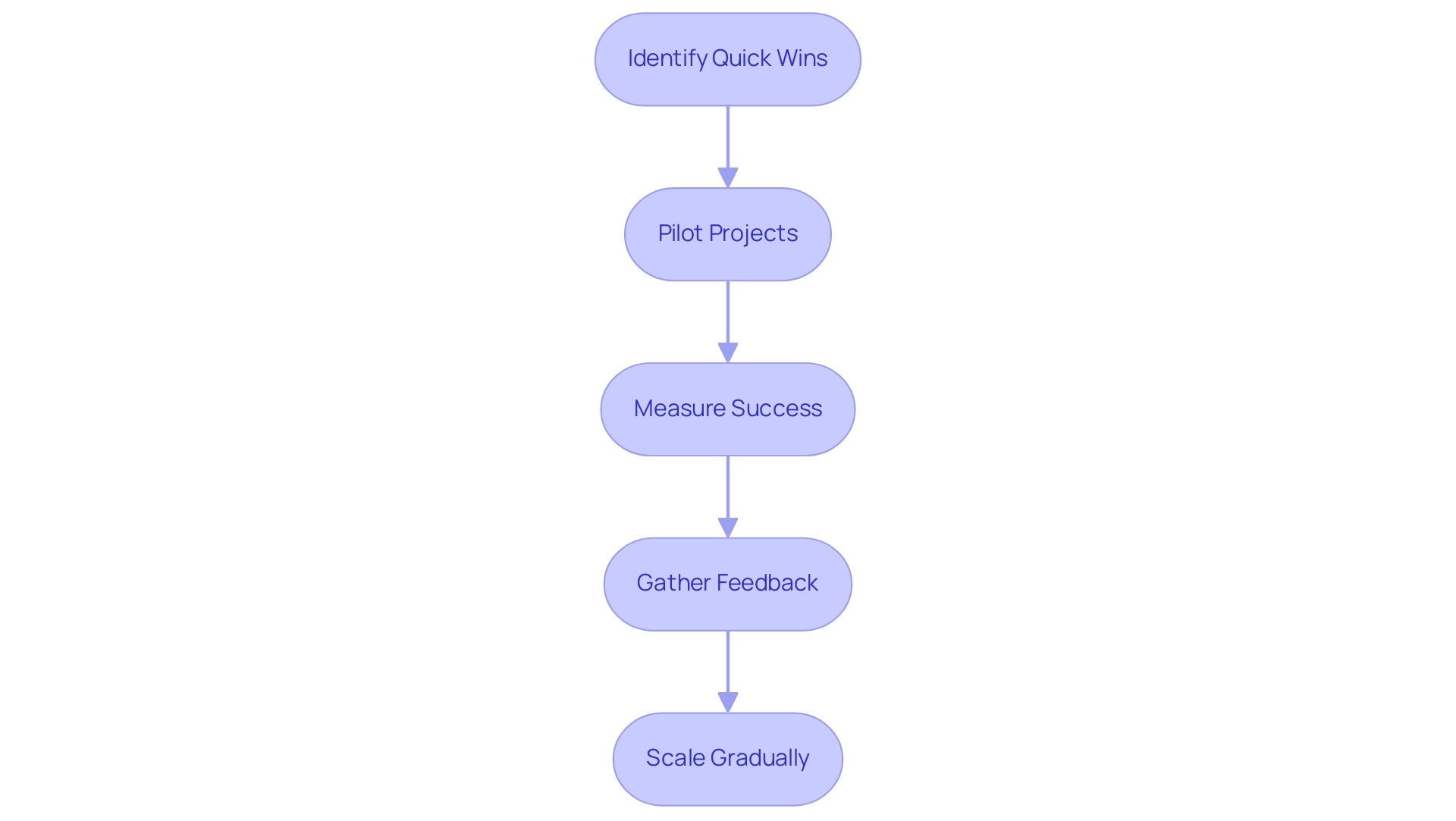
Future-Proofing Your RPA Strategy: Continuous Improvement and Adaptation
To effectively future-proof your RPA strategy, it is essential to continuously monitor industry trends and advancements in RPA technologies. Staying updated allows you to identify new opportunities for enhancement and ensures your entity remains competitive in a rapidly evolving landscape. Recent events scheduled from September 12-14, 2023, highlighted key advancements in RPA that can inform your RPA strategy.
- Invest in Training: Prioritize regular training sessions for your staff focused on the latest tools and best practices related to your RPA strategy.
Empowering your team with knowledge enhances their ability to leverage new capabilities, ultimately leading to better implementation and utilization of RPA solutions. This training is crucial for a successful RPA strategy, as it equips employees with the skills necessary to adapt to evolving technologies.
-
Encourage Innovation: Cultivate a culture of innovation within your establishment. Encourage teams to explore and experiment with new applications of RPA, fostering an environment where creative solutions can flourish. This proactive approach can lead to unique efficiencies and applications that align with your RPA strategy, ensuring that you effectively review and optimize your RPA initiatives. Periodically reviewing performance metrics allows you to make necessary adjustments to your RPA strategy, optimizing processes and effectively addressing any emerging challenges. These technologies can enhance decision-making by providing insights that drive efficiency and innovation, aligning with your specific business goals.
-
Transform Data into Insights: Utilize RPA to extract meaningful insights from your data, enabling informed decision-making. This capability is crucial for sustaining a competitive advantage in today’s data-abundant landscape.
By focusing on ongoing enhancement and merging RPA with customized AI solutions and Business Intelligence, organizations can ensure their RPA strategy aligns with current business objectives and remains flexible to future requirements. As Kim Collins aptly stated, ‘Strive for continuous improvement, instead of perfection.’ This mindset is crucial as industries evolve and expectations shift.
Drawing from the example of Waste Management, where Thomas A. Edison noted that waste is more detrimental than loss, focusing on minimizing waste directly relates to an RPA strategy by enhancing efficiency and resource management, ultimately leading to improved operational outcomes.

Conclusion
Robotic Process Automation (RPA) stands as a transformative force in modern business operations, offering organizations the capability to streamline workflows, enhance productivity, and drive significant cost savings. By automating repetitive tasks, RPA not only minimizes errors but also allows employees to redirect their efforts toward more strategic initiatives that contribute to overall growth. The seamless integration of RPA tools with existing systems ensures that businesses can adapt quickly to changing demands, thereby maintaining a competitive edge in their respective industries.
While the advantages of RPA are compelling, successful implementation requires a strategic approach. Organizations must navigate challenges such as:
- Resistance to change
- Integration issues
By fostering a culture of buy-in and providing comprehensive training, establishing clear objectives, and measuring success through defined key performance indicators, organizations can guide the implementation process and ensure long-term effectiveness.
Starting small with pilot projects can yield immediate benefits, paving the way for scalable RPA strategies that address workplace challenges. By systematically expanding automation initiatives and focusing on continuous improvement, businesses can not only enhance operational efficiency but also empower their workforce to thrive in a technology-driven environment. The integration of tailored AI solutions further amplifies the potential of RPA, enabling organizations to extract valuable insights and make informed decisions that propel them toward future success.
In conclusion, embracing RPA is not merely a trend; it is a strategic imperative for organizations aiming to achieve operational excellence. By prioritizing innovation, investing in training, and cultivating a culture of adaptability, businesses can unlock the full potential of RPA, ensuring they are well-positioned to meet the demands of an ever-evolving landscape.
